41st Evacuation Hospital Unit History

Shoulder Sleeve Insignia of the Hospital’s different assignments: Second US Army, First US Army, Ninth US Army, and Seventh US Army; Meritorious Service Sleeve Insignia; European-African-Middle Eastern Campaign Ribbon.
Introduction & Activation:
The 41st Evacuation Hospital, a non-affiliated 750-bed hospital unit, was activated at Fort Bragg, Fayetteville, North Carolina (Field Artillery Replacement Training Center, acreage: 129,422, troop capacity: 4,311 Officers & 76,175 Enlisted Men –ed) on 1 June 1941, as per letter Headquarters, Fourth Corps Area, Atlanta, Georgia (Fourth Corps Area: North Carolina, South Carolina, Georgia, Florida, Alabama, Tennessee, Mississippi, Louisiana, with Headquarters in Atlanta, Georgia –ed), dated 13 March 1941 and radiogram Headquarters, Fourth Corps Area, Atlanta, Georgia, dated 27 May 1941. On 15 May, Technical Sergeant Paul G. White and Staff Sergeant Arthur W. James were assigned to the organization thus becoming the first 2 Enlisted Men in the unit.
The first Commanding Officer was First Lieutenant Donald Lee Rose, MC, who reported for duty with the unit on 1 June 1941. Lieutenant D. L. Rose was later succeeded by First Lieutenant Willard F. Angen, MC, on 10 June and on the same day 149 EM arrived from the Medical Department Replacement Center, Camp Lee, Petersburg, Virginia (Army Service Forces Replacement Training Center, acreage: 7,534 troop capacity: 2,143 Officers & 38,427 Enlisted Men –ed) for duty with the 41st Evacuation Hospital.
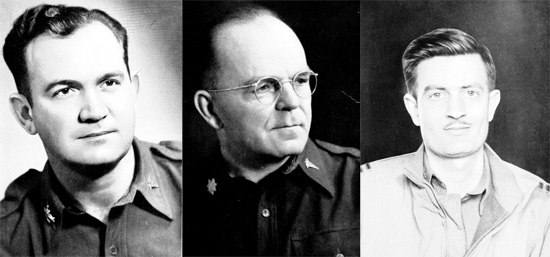
Portraits of senior Hospital personnel. From left to right:
Lieutenant Colonel Joe Harrell, MC, Commanding Officer, 41st Evacuation Hospital.
Lieutenant Colonel Clinton E. Adams, MC, Executive Officer, 41st Evacuation Hospital.
Captain Edward J. Hammerbacher, MAC, Executive Officer, 41st Evacuation Hospital.
The organization was initially housed in a three-story brick building located on Armistead Street among the main post buildings. The adjoining field served for all outdoor activities for the men (including parades, marches, and drill). First Lieutenant Yankour, Medical Corps Reserve, joined the unit on 15 August 1941.
Training:
A training program was started at once and by the end of September the unit was believed to be ready for field maneuvers. Orders were received to move the unit to Rockingham, North Carolina on 22 September 1941 to assist the 1st Evacuation Hospital (activated 1 August 1940, embarked for Australia 4 March 1942 –ed) operate a hospital for the maneuver period. Staff and personnel would spend the next ten weeks under canvas. The 41st joined with the 1st Evacuation Hospital to form the “1st Evacuation Hospital, Reinforced” which would remain operational for the duration of the field exercises. A complete Evacuation Hospital was subsequently established in a field near Rockingham, with every department being as complete as possible under the current circumstances.
Approximately 350 casualties a day were treated. Maximum capacity of the reinforced hospital was 2,000 patients. Another Officer, First Lieutenant Harry L. Alpert, MC joined the unit in the maneuver area and First Lieutenant W. F. Angen was promoted to Captain.
The maneuver being over, the organization moved back to Fort Bragg, North Carolina, on 4 December 1941, the move being made in a steady downpour of rain. Following the field training and maneuvers, there was not much activity for the organization. Conclusions and recommendations were drafted, and the unit was further built up and staffed as authorized by the current T/O & E.
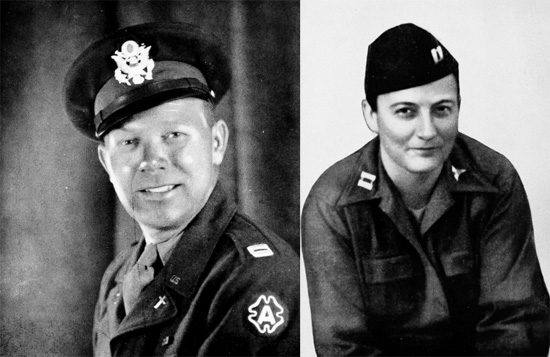
Left: Captain Clyde J. Verheyden, ChC, Chaplain, 41st Evacuation Hospital.
Right: Captain Jeannette E. Potter, ANC, Principal Chief Nurse, 41st Evacuation Hospital.
In January 1942 the men started the regular grind of training again. In April a number of changes took place. 108 Enlisted Men were transferred in grade to the 38th Evacuation Hospital (activated 16 April 1942, affiliated to Charlotte Memorial Hospital, North Carolina, embarked for England 5 August 1942 –ed) in April, along with Captain Angen and First Lieutenant Yankour, leaving First Lieutenant H. L. Alpert temporarily in command of the 41st Evac Hosp. Major Joe Harrell, MC, reported and assumed command of the unit on 19 July 1942 (Major J. Harrell was a Regular Army Officer, whose previous station was Camp Livingston, Alexandria, Louisiana, an Army Ground Forces Training Station –ed).
Captain Anton M. Miller reported for duty on 9 July and First Lieutenant Stanley N. Nowacki joined the unit the next day. With the arrival of additional Officers, First Lieutenant H. L. Alpert was promoted to Captain. More arrivals and fillers joined the organization the following weeks. Within the same period, 9 EM were meanwhile transferred to the unit from the 38th Evacuation Hospital. In August 1942 the Hospital moved to the Spring Lake area. During its stay 157 Enlisted Men arrived from the Reception Center, Fort Snelling, St. Paul, Minnesota (Army Service Forces Reception Center –ed), and 8 more joined from the Reception Center, Jefferson Barracks, Barnhart, Missouri. Also, another 45 EM came to the unit in a single group from the Reception Center, Fort Leavenworth, Kansas (Command & General Staff School –ed). By far the greatest number of the personnel hailed from the midwest, and were intelligent, healthy, and hard working men. Another Officer, First Lieutenant James E. Bolanowski, MC was attached to the unit in August.
By 31 August 1942, the unit numbered 8 Officers and 271 Enlisted Men (official T/O 8-232, dated 15 June 1941 authorized a strength of 47 Officers – 52 Nurses – 318 Enlisted Men + revised T/O 8-580, dated 2 July 1942 indicated the same aggregate strength + T/O 8-580, 750-bed Evac Hosp, dated 23 March 1943 indicated a strength of 48 Officers – 53 Nurses – 1 Warrant Officer – 308 EM vs. T/O 8-581, 400-bed Evac Hosp SM, dated 25 March 1944 authorizing a strength of 38 Officers – 40 Nurses – 1 Warrant Officer – 217 Enlisted Men –ed).
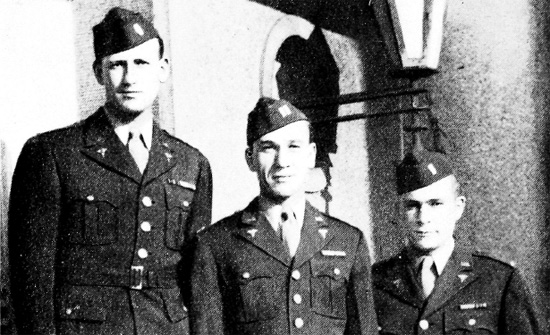
From L to R: First Lieutenant William L. Ivery, MAC, Transportation Officer; Captain Allen L. Allion, MAC, Registrar; First Lieutenant Jack D. Wallace, MAC, Mess Officer.
During the summer and fall of 1942, in addition to carrying out the regular training program for an Evacuation Hospital, groups of men were sent to various Training Schools throughout the Zone of Interior. These institutions included Officer Candidate Schools, Schools for Cooks and Bakers, as well as Enlisted Men’s Technicians Schools at O’Reilly (Springfield, Missouri), Fitzimons (Denver, Colorado), Billings (Indianapolis, Indiana), and Walter Reed (Washington DC) General Hospitals.
In September the unit moved again, this time to the Motorized Animal area, although the animals had long since departed and the motors had not arrived yet. Second Lieutenant Allen L. Allion, MAC, First Lieutenant Lester E. Shapiro, MC, and First Lieutenant Robert L. Rein, MC joined the unit in September 1942. They were immediately put to work assisting in the conduct of the overall training program. On 26 October, at 1300 hours, 8 Officers and 329 Enlisted Men assembled with full field equipment in the company street, ready for their first overnight hike. The skies were overcast and at the moment of departure a heavy rain was falling. Despite the bad weather, everyone proceeded on foot to the bivouac located 6.2 miles from headquarters. Upon arrival the men fell out and immediately set out to pitch their shelter tents in the pine woods just off Chicken Road. The men competed with one another to see who could camouflage their individual tents best. Slit trenches were dug, mess, supply and headquarters tents pitched, and straddle trenches prepared to serve as latrines. That night, after eating a substantial meal from their individual mess kits (they were somewhat of a novelty then), everyone gathered around a large central bonfire and joined in songs, led by the organization’s own Chaplain Willard and accompanied by Private Wayne W. Rathbone. Later in the night, the unit was led in a night march by First Lieutenant John Bradbury and Captain Anton M. Miller. When that exercise was over everybody went to bed and it seemed only minutes had passed until the First Sergeant was trying to get the men out of bed again and ready for breakfast. The sun was peeping through the pine trees and the air was crisp, so the men built bonfires and stood around them while eating breakfast. The food seemed to taste better in the woods and there was no shortage of appetites. As the sun got a little higher in the sky everyone began to warm up a bit, and the men set to striking their tents and getting ready for the return march after lunch.
Colonel Hawkins, from Headquarters, Special Troops, Second United States Army, inspected the mess, the camouflaged tents, the slit trenches, and all the other sections of the camp, both on 26 and 27 October. He praised the unit’s initial attempt at living in the field under ‘special’ conditions and offered some timely and helpful suggestions, both related to general comfort and setting up an efficient bivouac. Colonel Striker, from the Surgeon’s Office, Second US Army, visited the bivouac area too, joined in the songfest, and led the singing with his rich baritone voice. The unit returned to the animal area at 1520 hours 27 September 1942, following a satisfactory overnight march and bivouac.

Captain Glenn F. Palmer, MC, Receiving & Evacuation Officer.
First Lieutenant Gustave N. Click, MC and Second Lieutenant William V. Ivery, MAC joined the unit in October 1942 and in November Captain George Bush, MC also reported for duty. Major J. Harrell was promoted to Lieutenant Colonel. Training was continuous, and activities conducted during this period put special emphasis on defense against gas attack, general camouflage, defense against air attack, litter drill, improvised splints, and correct preparation of Emergency Medical Tags. By 1 December 1942, there were 10 Officers and 321 Enlisted Men in the unit.
In order to break a certain monotony in training, most of the men were placed on TD in the Station Hospital for practical experience in the handling and care of patients. Major George R. Benton, Jr., MC joined the unit from Camp Livingston, Louisiana, followed by Captain Robert E. Eby, MC from the 101st Airborne Division, and Second Lieutenant Anthony P. Pancamo, MAC from Camp Barkeley, Texas. Simulated entraining exercises were held on 3 December 1942. Eighteen railcars were selected, vehicles were marked, and all men ate their noon meal on the train. The ‘problem’ was successfully solved and many details satisfactorily ironed out.
On 7 and 8 December 1942, the “grapevine” let the entire unit down as, without any previous warning, or rumor, Second United States Army Inspectors swooped down upon the post. On a cold, miserable, windy day the outfit began the first of a two-day examination period. Instructors held their breaths as the probers went through rank after rank of shivering men, asking odd questions, such as “what information would you give to the enemy if captured?” or “where would you apply a tourniquet to stop hemorrhage from the forearm?” – the classic exposition by Private Joe Ock on treatment of snakebites – Captain H. L. Alpert and the punishment for helping a deserter (cut his throat) – and the always present fierce cold – were items that would stand out in retrospect of the first day of the inspection. On the second day, subjects of medical and military interest were taken up. On the whole a satisfactory showing was made, with a rating of ‘satisfactory’ being granted by the examiners and the organization was permitted to go into its second period of training. So another phase in the life of the 41st Evac drew to a successful close.
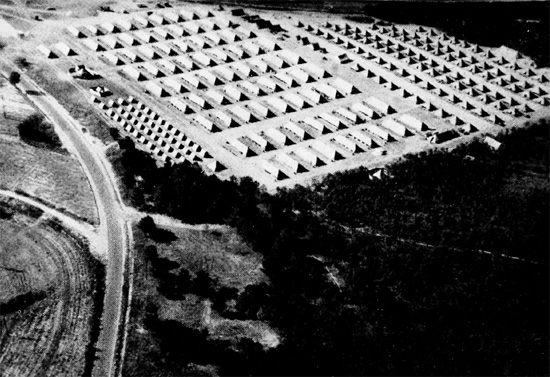
41st Evacuation Hospital setup during 1941 Maneuvers. Picture taken 24 September 1941 at Rockingham, North Carolina, Zone of Interior.
Commanding Officers – 41st Evacuation Hospital
First Lieutenant Donald L. Rose, MC – 1 June 1941
First Lieutenant Willard F. Angen, MC – 10 June 1941
First Lieutenant Harry L. Alpert, MC – 10 April 1942
Major Joe Harrell, MC – 19 July 1942
Lieutenant Colonel Van Buren O. Hammett, MC – 23 October 1945
January 1943 ushered in an eventful year in the life of the members of the 41st Evacuation Hospital. New Officers joined during the first month: they were Captain Van Buren O. Hammett, MC, First Lieutenant George Wadsworth, MC, and First Lieutenant William D. Monahan, MC. Second Lieutenant Allen L. Allion was promoted to First Lieutenant the same month. On 28 January, Second Lieutenant A. P. Pancamo and 42 Enlisted Men were transferred to the 100th Evacuation Hospital to form a cadre to activate that unit. More marches and bivouacs were in store for the Enlisted personnel, with more lectures and practice in the care of patients, and more instruction in what to expect in combat. The men got a real taste of battle conditions on a fifteen-mile forced march during which the 193d Field Artillery Battalion laid down a barrage close to the road. Of course, there were the usual 41st conditions of rain, wind and mud, but all was taken in stride by the men. More Officers were assigned to the organization. Captain James J. Reardon, MC, reported on 1 February. He was followed by Major Arthur Post, Captain Abraham I. Friedman, and Major James G. Bogle, all from the Medical Corps.
The bivouac of February 1943 was to stand out in the memories of all the men, because of the intense cold and the long road marches. Water froze in the canteens and water containers, and the men returned to camp only to find that the water mains in the barracks were frozen solid, so lyster bags had to be set up in the barracks to provide water for both drinking and washing. On 26 February, a tactical road march of fourteen miles was held. Many tactical conditions were simulated, including an air raid, by Lieutenant G. Wadsworth in a training plane. The men were “gassed” and “bombed” by the aircraft and machinegun fire simulated by fire crackers thrown by Lieutenant Lester E. Shapiro from a passing jeep. As a rule, most of the men were ready for the aircraft and the gas attacks set off by Sergeant Michael P. Telehany and Private First Class Allan Gentry; however, the machinegun fire by Lieutenant Lester E. Shapiro took them by surprise and would have caused a great number of casualties had it occurred in actual combat.
Again the month of March brought new Enlisted Men and new Officers to the unit. Captain Milton F. Axthelm, Major Walter W. McCook, First Lieutenant William P. Gaynor, Captain Jacob M. Mayer, Lieutenant Colonel Clinton E. Adams and Captain George Colyer, all joined the unit during the month. During the first half of the month the usual training duties were carried out with more and more emphasis being placed upon the function of a complete Evacuation Hospital in the field. So the latter part of March 1943 was spent in putting to practical use the knowledge gained in training. For the first time the complete hospital was set up in the field and simulated patients were processed through the organization. This procedure gave the men a more complete idea as to the function of an Evacuation Hospital, and they seemed to get a great deal of satisfaction out of it. April was a busy month four the 41st, as a constant flow of Officers reported for assignment and duty with the unit, including: First Lieutenant Miles J. Gullickson, Captain Benjamin B. Wetchler, Captain James T. Williams, First Lieutenant Stephen S. Stanczak, Captain George Nenner, Captain Samuel R. Sherman, First Lieutenant Henry E. Zeranski, Second Lieutenant Dairwood A. Mote and Second Lieutenant Howard E. Thompson. The first ANC Officers to join the unit came from Camp Blanding, Starke, Florida (Infantry Replacement Training Center, acreage: 152,672, troop capacity: 2,157 Officers & 58,570 Enlisted Men –ed). They included: Second Lieutenants Grace E. Bradshaw, Rosemary M. Gaylord, Floy E. Green, Betty A. Harris, Pauline F. Parre, Phyllis N. Richardson, Mary E. Twamley, and Lenora E. Wheeler.
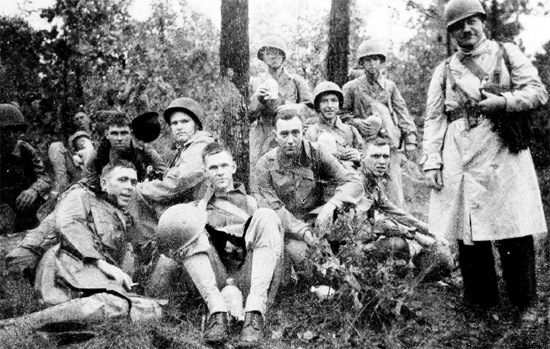
Personnel of the 41st Evacuation Hospital at rest during a training march, Fort Bragg, North Carolina, 26 October 1942.
The outstanding event of the month was not only the arrival of the organization’s first female Officers, but the departure of the unit for the spring maneuvers in Tennessee, by motor convoy. To most of the organization this was an introduction to the method of travel they would soon become very familiar with for the duration of their stay overseas. The unit left Fort Bragg at 0810 hours, 16 April 1943. There were twenty-four vehicles in the convoy. The personnel consisted of 29 Officers, 8 Nurses, and 198 Enlisted Men. The weather was unusual for the season, the day being bright and sunny. Two hundred and eleven miles were covered the first day, bringing the convoy into Camp Croft, Spartanburg, South Carolina (Infantry Replacement Center, acreage: 19,403, troop capacity: 864 Officers & 20,431 Enlisted Men –ed) for the night. The area was out on the range and pup tents were erected, latrine areas designated, guards posted and supper started. Chow was served at 2000, retreat at 2100, and taps at 2300. Everyone had to get up early the next morning as breakfast was scheduled for 0515. The personnel ate quickly, broke camp, boarded the trucks, and were on their way by 0700. The arrival at Chattanooga, Tennessee took place late in the night, after a long and tiresome journey. The weather was bad, it was cold and rainy and there were no dry spots for the men to sleep. They pitched their individual tents in the dark and in the rain, but as they were dead tired, they felt that a little water would not keep them from sleeping.
On 18 April 1943 (Sunday) the weather was still bad, so the men moved into pyramidal tents set up in the recreation area, washed and changed their clothes. Sightseeing trips were arranged for all those who cared to go, and those who ventured downtown in Chattanooga, out to Lookout Mountain, or out to Fort Oglethorpe, Chattanooga, Tennessee (Women’s Army Corps Training Center, acreage: 2,742, troop capacity: 382 Officers & 13,293 Enlisted personnel –ed), reported very profitable trips. The last one hundred miles of the journey were to be made at night. Accordingly, camp was struck, the men entrucked, and moved out of Chattanooga at 2200 hours, 18 April. This part of the journey was rather difficult, especially the last fifty miles, for the hospital unit traveled that particular distance in total blackout. The convoy was met on the outskirts of Shelbyville by Major Arthur Post, MC, in charge of the advance party, and he directed the various groups to the area they were to occupy. The official time of arrival was 0500 hours, as scheduled. The trip was made without a single mishap, although there were indeed some very close calls. Total distance traveled was five hundred and seventy-five miles. On arrival, the unit was told to occupy two large highway garages on the outskirts of Shelbyville. Having traveled all night, nobody was particularly interested in doing anything but going to bed, as it was five o’clock in the morning when the men detrucked. The buildings were surrounded by a sea of mud and the rain was pouring down, things did not look too good. In addition, the buildings were already occupied by one other Evacuation Hospital unit, colored elements of an Engineer Battalion, and a Medical Collecting Company. Some men were asked to move over, in order to find some space for the arriving troops. Personnel quickly lay down on the concrete floor and went to sleep, Officers, Nurses and EM, both white and colored. This was quite different to the reception everyone had expected, but this circumstance was largely due to the fact that it had been raining constantly for the past week, so that all work had been slowed down, and the units had to move into hard buildings for protection against the elements. The unit was soon to get used to wind, rain, and sticky mud, however.
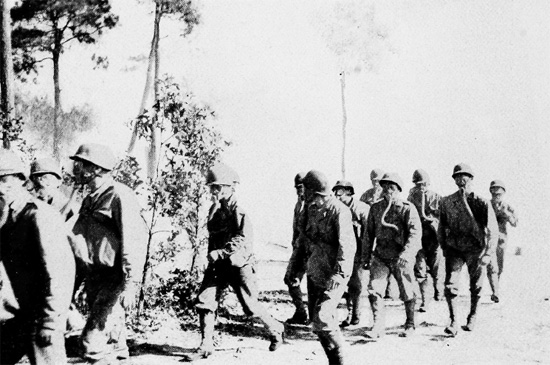
“Gas Attack” during a training march at Fort Bragg, North Carolina, October 1942.
On 20 April all hands turned out, details were formed, duties assigned, and work was started on getting the buildings cleaned and turned over into a temporary hospital. This was not an easy task; but within three days roads were made passable, the mud cleaned out of the buildings, arrangement made for water, waste and garbage disposal, and things were pretty well under way. The hospital equipment, which had been shipped by rail from Fort Bragg, arrived on 21 April and the entire day and night was spent unloading it, moving it to the hospital area and uncrating and unpacking everything for the hospital. The Evacuation Hospital was officially opened on 22 April 1943 and the very first patient was admitted at 1000 hours (a member of the own organization) and evacuated the same day to Camp Forrest, Tullahoma, Tennessee (Infantry Division Camp, acreage: 73,124, troop capacity: 1,886 Officers & 32,368 Enlisted Men –ed). So began the maneuvers at Shelbyville, Tennessee.
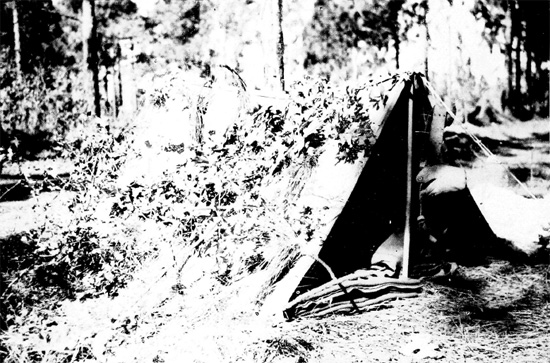
View of a camouflaged individual pup tent at a bivouac area. Picture taken during training at Fort Bragg, North Carolina, October 1942.
Additional Officers, Nurses and Enlisted Men were assigned and joined the unit soon after its arrival at Shelbyville. These included: Second Lieutenants Samuel D. Gross, Joyce M. Lehman, Jack D. Wallace, and Meyer Rabban; Captains Truxton L. Jackson and Martin J. Rucker; First Lieutenant Jeannette E. Potter, Second Lieutenants Verdine E. Mulkins, Mary E. Brown, Elizabeth C Hogan, Alice M. Radigan, Eunice A. Thorpe, Elma M. Miller, Luella M. Wentzel, Margaret M. Wright, Betty J. Hindman, Clara M. Duley, Maria G. Cinelli, Phyllis E. Bailey, Florence E. Thompson, Helen E. Callesen, Eugenia A. Phillips, Rosemary Slavin and Lucille Crandall, all assigned from Ninth Corps Area. Several days later Second Lieutenants Mary E. Kuntz and Mary E. Fedor, Captain Frank R. Pittman, and First Lieutenant Louis Golman, also reported for assignment with the 41st Evac. Major George R. Benton, Jr. was promoted to Lieutenant Colonel on 1 May and Captain Harry L. Alpert to Major. 25 Enlisted Men reported in from Camp Pickett, Blackstone, Virginia (Division Camp, acreage: 45,867, troop capacity: 2,363 Officers & 41,552 Enlisted Men –ed).
The first five days of maneuvers were a little rough, as it continued to rain daily and there was considerable difficulty in keeping traffic moving. The Hospital was sufficiently established to handle 200 patients. The first official operation (0-1) of the maneuvers began 26 April 1943 with the 41st alone furnishing hospitalization for the “Blue Forces” for the period ending on the 29th. On 2 May 1943, the 45th Evacuation Hospital opened at Hermitage and the 41st closed for receipt of patients, except for an occasional emergency in the immediate vicinity. On 8 May the 45th Evac moved to Shelbyville, took over the few remaining cases from the 41st and the latter moved into reserve in the vicinity of the highway garages. During this first setup in the buildings from 22 April to 8 May, 643 admissions were registered, with 1 death. This was a very satisfactory function and many kinks were ironed out during the time. During 0-3, which began on 10 May and ended 14 May, the unit remained in reserve at Shelbyville, Tennessee. The time was utilized in breaking the equipment down into 2 completely independent sections and loading the second section onto organic vehicles, ready to move at short notice. At 1300 hours, 11 May 1943, the second section moved to a new site, two and a half miles northeast of Murfreesboro and established a 200-bed Evacuation Hospital, opening at 1800 hours that same day. This was a beautiful hospital site; unfortunately it never stopped raining. The trucks returned to Shelbyville and moved the first section at 0800 hours, 12 May, but the equipment of this section was not unloaded, as it was not needed. This was the unit’s first move by echelon and it proved very satisfactory. The Hospital officially functioned only fourteen hours during its stay at Murfreesboro and received 33 patients. However, due to the changing of the battle line, it was necessary to move again on 14 May. The next move was to the vicinity of Nashville, about three miles north of Berry Field, a distance of forty miles from the old location, movement being made by the Hospital’s organic vehicles, plus eighteen 2 ½-ton, and twelve ¾-ton ambulances. The loading was delayed by failure of the Quartermaster Corps trucks (on loan) to arrive at the designated time, but the “IP” (Initial Point –ed) was crossed at 0800 hours, as ordered. The entire hospital, with personnel, was moved at the same time, the loads being such that the section to be set up at destination would be the only section to be unloaded. The move was made without difficulty following a severe rainstorm; as a result, quite a lot of trouble was encountered getting into the new area, with trucks bogging down and having to be pushed and pulled uphill. The Hospital was set up rapidly, however, and was open for receiving patients at 1800 hours the same day. The 41st Evacuation Hospital operated under complete camouflage and blackout conditions during the period at this site, from 14 to 20 May. This was for the period of 0-3, as well as four days prior thereto. This was a very active period, the Hospital admitting 601 patients, and handling 7 deaths; one from lightning, and six from drowning. From every standpoint, the period at this site was the most interesting and instructive one of the entire maneuver period for the 41st, proving that an Evacuation Hospital could operate under complete camouflage and in blackout conditions in the field.
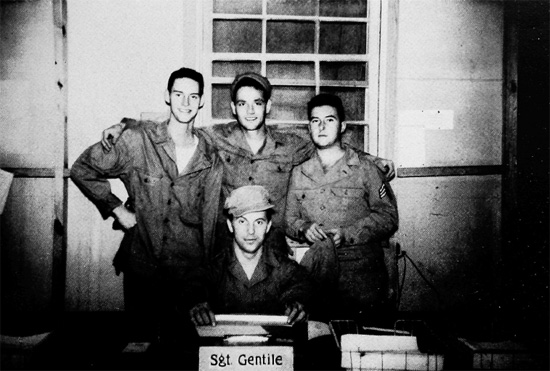
Personnel of the Supply Department. Standing, from L to R: Private Cancer; Technician 5th Grade Louis Jeeney; Sergeant McManus. Front: Staff Sergeant Patrick Gentile. Fort Bragg, North Carolina, Zone of Interior, November 1942.
On 19 May 1943, at 1000 hours, the first section, supplemented by the entire Headquarters, Personnel, Post Exchange, and American Red Cross Sections, moved by convoy to Shelbyville, via Farmington, and established the first section of the Hospital in the highway garages there, taking over 15 patients from the 45th Evacuation Hospital, and opening at 1400 hours 19 May. At 1400 hours, Company C of the 37th Motor Ambulance Battalion moved 165 patients from the old installation to the highway garages, arriving at 1700 hours. At 2100 hours the same day, the second section moved by its own transportation, leaving 6 non-transportable cases, 10 EM, 1 Officer, and two ambulance vehicles at the old site, with instructions to move as soon as the patients were able. The installation at Shelbyville was entirely different from the original setup there and was much more satisfactory. The first building was used for nothing but patients, all other departments being located in the second building, except for the Mess which was located outside. Thus it was easy to house 350 patients without having to put any in tents. The unit functioned at this location from 19 May to 5 June 1943; that is, during the rest period following 0-4 and during 0-5, furnishing medical service and support to the “Blue Forces”. On termination of 0-5, it continued to receive patients from the Blue Army Forces in the vicinity, there being an average of 25 patients daily from this source. During the entire period the organization admitted 713 patients and handled 3 deaths; two from an airplane crash, and one from a jeep accident.
At 0500 the entire unit moved in one convoy to the vicinity of Castilian Springs, a distance of seventy-five miles, arriving there at 1345 hours. This move required using the organic transportation, and nine 1½-ton trucks borrowed from the 45th Evacuation Hospital, plus twelve ¾-ton ambulances from the 37th Motor Ambulance Battalion. This was a rather long convoy, consisting of forty-eight vehicles; in addition, the unit was accompanied by a Medical Collecting Company pertaining to the 48th Medical Regiment, consisting of twenty vehicles. The convoy was divided and moved in serials. The hospital functioned under more difficult conditions here than at any other place, due to a poor road net, lack of good telephone communication, lack of water for washing and bathing and the extreme heat and humidity in the region. The method of evacuation was not as efficient, and the method of handling Wassermans and darkfield examinations was not satisfactory at all. During this operation 40 paratroops from airborne attacks in the vicinity of Gallatin were admitted. There were no serious injuries, although there were seven fractures. About twelve hours following arrival in this area, the Hospital was called upon to handle and evacuate 20 death cases in Nashville, Tennessee, in addition to 1 death from mesenteric thrombosis in its own facility. There were 278 admissions to the Hospital during this entire period.
The last move during the maneuvers was to Beechgrove, a distance of sixty-five miles from Castilian Springs. The movement began at 0830 hours, 12 June, the entire unit moving at one time with its own transportation, supplemented by nineteen extra Quartermaster Corps trucks, fourteen 1½-ton trucks and five 2½-ton trucks. No patients were transported, all of them having been evacuated prior to the move. On arrival, according to pre-arranged plans, the hospital proper was set up in the form of a large cross, using 24 large ward tents for this purpose. This proved to be an excellent arrangement as far as efficiency was concerned, although it did not allow for sufficient dispersion, or staggering of tents as required under battle conditions. All personnel, vehicles, and the mess, were placed beyond the arms of the cross, and partially concealed and camouflaged. The 45th Evacuation Hospital opened at Statesville to receive the greater portion of casualties, although the 41st continued to receive all patients from troops located south of Statesville. There were 226 admissions and 1 death during this period from 12 to 16 June 1943, the operation ending at 1800 hours on 16 June.
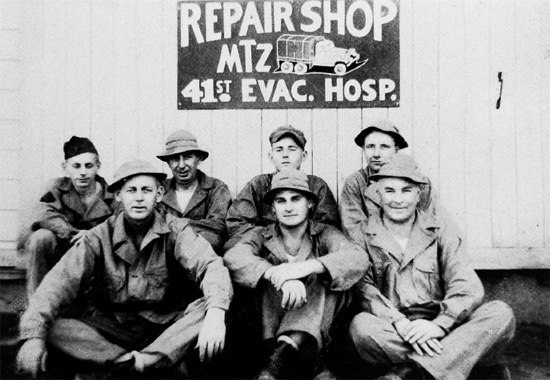
Personnel of the Utilities Department. Back row, from L to R: Technician 5th Grade George D. Cameron; Private Sumstadt; Private Harold J. Scott; and Private Robert C. Ash. Front row, from L to R: Private Gentry; Private Shurston; Private Arry. Fort Bragg, North Carolina, Zone of Interior, November 1942.
Maneuver Findings & Recommendations:
It should be noted that general conditions confronting an Evacuation Hospital on maneuvers were quite different from conditions encountered during actual combat, insofar as the type of patients to be handled is concerned.
It proved not practicable to adhere to the T/O assignment of Medical Officers to operating teams, since the amount of surgery performed was minimal and the services of the Officers were most needed in the fields of non-operative surgery. The professional services were divided into Medical, Surgical, X-Ray, Laboratory and Pharmacy, with the Surgical Section consisting of operating and ward sections and the Medical Section consisting of wards only. The entire hospital, equipment and personnel alike, except for the X-Ray and Personnel Sections were divided into two equal sections. However, on occasion, certain Specialists, Technicians, and Nurses were shifted from one section to the other, depending on where their services were needed most. The Personnel, Post Exchange, American Red Cross and Special Service Departments were always placed with the rear section of the installations. By this division, either section could move forward or back, depending on which section was functioning, with the least amount of confusion. As a rule, only the necessary sections of the hospital were established, thus leaving an entire section loaded on trucks ready to move on short notice. If both sections were needed at one site, then either section could be pulled out and moved, adding any needed personnel. By this division, either section could be moved with its own transportation, thus relieving the unit from requesting transportation that often failed to arrive on schedule, or which was of a type not usually employed in the organization’s procedures for loading. The Surgical Service consisted of two equal sections, each having one operating tent, one tent for central supply and five wards. The X-Ray Department could not be satisfactorily divided, so was moved with the section to be moved first each time. All other departments were equally split up and divided, so that the two sections could function independently. The various departments of the hospital were as follows: Headquarters; Detachment Headquarters; Supply; Utilities; Mess; Transportation; Registrar and Commanding Officer of the Detachment of Patients; Surgical; Medical; Pharmacy, Laboratory and Morgue; X-Ray; Special Services (including American Red Cross and Post Exchange); Sanitation; Receiving; Dental and Dressing (or Dispensary); and Evacuation (or Disposition). Although the T/O did not make allowance for some of these sections, they were found to be an inseparable part of most Evacuation Hospitals operating in the field.
It was evident from orders received from higher authority that an Evacuation Hospital was expected to be able to function as one 400-bed unit or function as a 200-bed organization with the remainder of the organization in reserve, or closing out at the old site, with each section functioning independently of the other, except for certain reports and records. This did not mean that the unit should set up two, 200-bed units and receive front line casualties at the same time; but it did contemplate that while operating in one place, a section could be detached and moved forward, or back, to establish a 200-bed hospital while the remaining section gradually disposed of the cases it handled and prepared to join the other section. However, with a little difficulty, it could act as two separate 200-bed Evacuation Hospitals, each section receiving front line casualties. In moving forward, or back, the unit could move: as a whole – as a section – or if one section was already functioning, one section could leapfrog the other when the necessity arised.
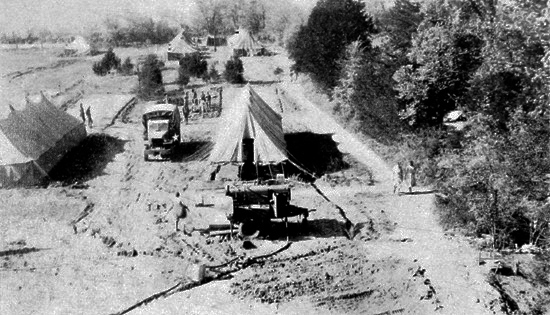
Partial aerial view of the 41st Evacuation Hospital setup near Shelbyville, Tennessee, 20 April 1943. Shower tent displayed in foreground with Nurses’ area in the background.
The above, however, required careful planning and breaking down of equipment, but it could be done, and, in the opinion of the 41st Evac Hosp Staff, the unit should introduce an SOP for such move. The existing T/O contemplated that the hospital be moved by its own organic transportation, except for personnel and individual equipment. This could have been done, except that some departments had been added as they were found to be essential to the efficient function of the hospital. To move the entire unit at one time required eighteen additional 1½-ton trucks. Army Ground Forces instructions at that time were that Evacuation Hospitals should, in general, set up the hospital proper in the open, plainly marked with two large Geneva Crosses, tents dispersed and staggered, and vehicles dispersed and under cover, if possible. In addition, they were to set up under cover without displaying the GC symbols, if the necessity arose. The latest information from North Africa and the Mediterranean Theater was that Evacuation Hospitals were usually setting up in the open, with tents arranged in the form of a large cross, with GC ground markers conveniently displayed and the Red Cross flag in the center of the large cross. At Shelbyville, the medical installation was in two large buildings, with ward tents in the rear, two Geneva Crosses on the ground, with only Enlisted personnel and organic vehicles under cover, as there was not sufficient space to put the Officers and Nurses under cover as well. Slit trenches were dug and the Geneva Cross conspicuously displayed at all times. At Murfreesboro and at Castilian Springs the personnel were under cover, the hospital was established in the open, tents dispersed and staggered, and two Geneva Crosses conspicuously displayed for aerial and ground recognition.
At Donelson, all tentage was set up under cover, completely camouflaged, tents properly dispersed and staggered, with personnel and vehicles also under cover. The personnel wore a blending uniform (mostly HBT fatigues) and observed all rules of camouflage. In addition, blackout conditions prevailed throughout the installation at night. The Geneva Crosses were not displayed. This was a most interesting, as well as difficult, setup and afforded the best opportunity to put into effect practically all of the principles involved in operations in a combat zone. The last installation, at Beechgrove, was along the lines employed by both Axis and Allied Evacuation Hospitals in North Africa; that is, the canvas tents of the hospital proper were set up in the form of a large cross, with two all white ground Crosses at each end of the area, and the flag placed in the center of the large cross. This was by far the most convenient and efficient setup yet tried when established under tentage at that time, although it did not fully conform to the idea of dispersion and staggering of the tents.
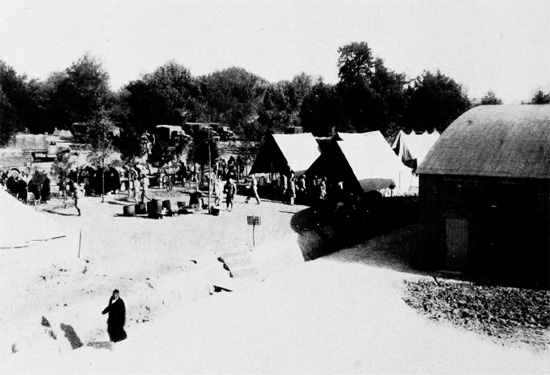
41st Evacuation Hospital Mess area, Shelbyville, Tennessee, 22 April 1943.
The surgical functioning of the unit, as a whole, was well planned and well executed. When divided into sections, there was some difficulty in adjusting property and personnel so that the specialists would be where most needed. Having an exceptionally versatile staff overcame this difficulty for the maneuvers, but it would not entirely work under combat conditions. That is, the Table of Equipment could have been split into two units to function separately under any circumstances, but the T/O could not be divided into two complete structures, and it was in fact not intended to be. The supply of surgical instruments and supplies was adequate, except that there was a need of a type of fracture reduction apparatus, such as the Stader or the Roger Anderson Type Anatomic Fracture Reduction apparatus (MD Supply Catalog Item No. 32885), to be used especially in the reduction of simple fractures that could not be reduced by other closed methods, for it was felt that an Evacuation Hospital was not the place to do open reduction on simple fractures. In combat this apparatus was not necessary. Insofar as the function of the operating rooms was concerned, it taxed the ingenuity of all concerned to devise methods, special devices, gadgets, and improvisations to cause the field OR, functioning under canvas, to approach the aseptic conditions and conveniences of an efficient and acceptable Operating Room. The fact that one was working under field conditions in no way altered the consideration which was to be given to asepsis. It was recommended that some standard method be adopted whereby an operating room set up under tentage could be lined with muslin or some similar material to be placed over a very light and portable metal frame, similar to that which was used for the darkroom of field X-Ray units. The tarpaulin (20×40) had been found to serve adequately for flooring. When prepared in such a manner a single operating room could be temporarily set up, without the cover of the ward tent, for the performance of emergency surgery in the field for short periods of time (2 to 3 hours). Such a device was used with this hospital during the maneuvers and found to be entirely practical, except for the fact that the frame for the tent was attached to the center poles of the tent and could therefore not be used separately.
As water was/is the greatest source of cleanliness and one of the greatest factors involved in the end results of surgery, it was highly recommended that some portable, collapsible type of scrub basin be devised and furnished the hospital for use in the field. The type used on maneuvers consisted of a fifty-five gallon tank, mounted on a stand from which three outlets were available and a scrub sink made of galvanized metal, and this was adequate, but its bulk decreased its portability. A device similar in make to that of a lyster bag would much better serve the purpose, since it would be collapsible and thereby its portability increased. While the above did not constitute necessities for the functioning of the Surgical Service in the field, it was felt that the best field hospital would be the one which most closely approached the conditions of a fixed hospital and, at the same time, did not increase its carrying load, or decrease its mobility.
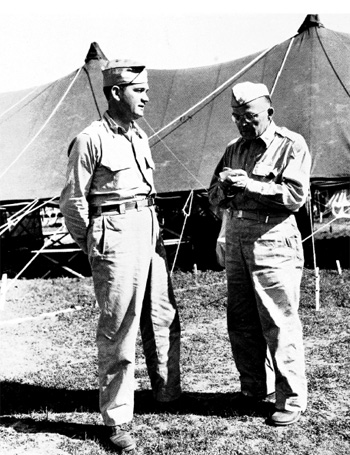
Lieutenant Colonel Joe Harrell, MC, and Lieutenant Colonel C. E. Adams, MC, at Beechgrove, during the 1943 Tennessee Maneuvers.
Realizing the need of a sewing machine for any hospital, especially the surgical section, this organization purchased a portable Singer Electric Machine prior to moving from Fort Bragg, and it was found to be indispensable. It was small, compact, and could be operated, either by hand or electricity. In Headquarters, Registrar and Personnel Sections, a small mimeograph machine was found to be of considerable value in publishing instructions, and SOP, as well as printing the small unit newsletter at regular intervals. This latter was a definite morale factor. It was found necessary during maneuvers to improvise what was called a Clinical Data Form in order to properly record a patient’s treatment over a period of several days, especially when he was seriously ill and required considerable attention. This also provided the Medical Officers in the hospitals to which patients were transferred, with the necessary information, in order to continue the treatment as it should be done. The method of handling the dead on maneuvers was most cumbersome and time consuming. Many hours were required to do post-mortem examinations, inspect remains, and fill out all of the necessary forms. The Dispensary was a fairly active department during maneuvers and it actually acted as a first-aid room for the hospital personnel, and minor dressing room for patients. Many physical examinations were performed in the Dispensary.
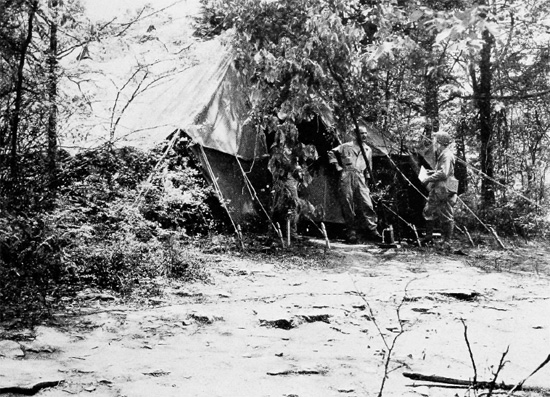
Major Harry L. Alpert, MC, talks to a patient in front of the camouflaged Surgical Ward tent, Donelson, Tennessee, 14 May 1943.
From the professional standpoint, there were a variety of interesting cases admitted and treated. Of particular interest were the following:
- Tick-borne fever. Approximately 20 cases of fever resulting from tick bites were treated, most of them showing many of the features of Rocky Mountain Spotted Fever.
- Tick-borne Tularemia. There were around 8 cases treated for what appeared to be tularemia, the local lesion developing at the site of the tick-bite. The agglutination tests for some of these cases were reported as positive.
- Diarrhea. During the latter one third of the maneuver period, approximately 20% of all admissions to the hospital were caused by diarrhea. Most of the cases were of the staphylotoxin type, coming on several hours after eating, lasting several days, and gradually subsiding. In addition, there were a few cases of bacillary dysentery and one or more of amoebic dysentery. Only three or four of these cases were sick enough to warrant transfer to the Station Hospital.
- Atypical pneumonia. In the first part of the maneuver period a number of cases of this nature were received. The patients, in general, were not acutely ill and responded to treatment readily. However, there were a few sulfa-resistant cases that became very ill and required hospitalization at Camp Forrest.
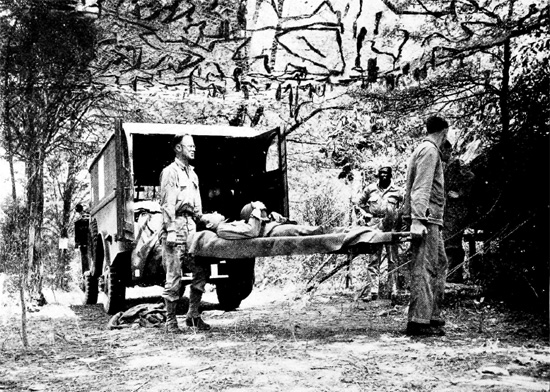
Donelson, Tennessee, May 1943. Litter bearers take a patient into the Receiving tent for triage.
There was nothing particularly remarkable about the surgical patients. There was a surprising scarcity of operative cases. The orthopedic section handled the greatest number of patients, most of them being chronic conditions; next in line was septic surgery, and then venereal. In general, there were more patients admitted on the surgical service than on the medical, except during the last two weeks, when the number of medical patients equalled the surgical cases, due to the increase in the number of diarrhea patients. The Surgical Service took care of all VD cases. There were 2 deaths in the Hospital during maneuvers; one being the result of a fractured skull and cerebral hemorrhage, the patient dying thirty minutes after arrival; and another patient who died of mesenteric thrombosis. The latter case arrived in serious shock and never recovered sufficiently for surgery. 18 men met their deaths when a government truck drove over an embankment in Nashville. Two soldiers were killed when they were run over by a train while they were asleep on the track; two died as the result of a plane crash; one was killed by lightning; six died of drowning; one died from a stab wound in the neck incurred in a fight, and four as a result of a jeep accident; in total 3 Officers and 33 Enlisted Men were involved. Thirty cases were handled in Nashville and six were handled in Tullahoma. The Laboratory and Pharmacy Department performed efficiently, but were handicapped by the lack of chemicals and stains to do many of the necessary tests while on maneuvers.
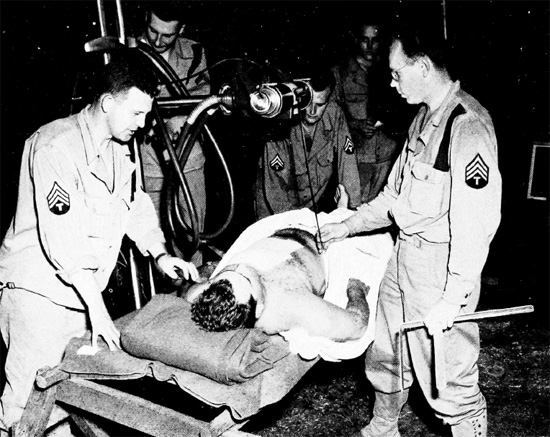
1943 Tennessee Maneuvers. Technicians 4th Grade John J. Kish and Tony S. Zigala take X-rays of a patient in one of the tents used by the X-Ray Department.
Twenty-eight Nurses served with the unit during the entire first phase of the maneuvers and rendered excellent service. They lived under the same conditions as the Officers, under canvas, and neither asked nor received special favors of anyone. They dug their own trenches, made their own beds, washed clothes, rode the trucks, acted as guides for convoys, and were in no way a detriment to the unit. Instead, they were a morale stimulating factor to the patients and the entire hospital personnel, both Officers and Enlisted Men alike. There was little sickness among the Nurses, with only one requiring hospitalization for a short time. They often wore herringbone twill fatigues for camouflage purposes. The Nurses, as a rule, carried much less individual equipment or luggage than the other Officers. During rest periods, they had classes in drill, sanitation, use of the gas mask, chemical warfare, military courtesy and allied subjects. They further participated in several retreat inspections and parades, showing up well every time.
There was an adequate supply of expendable property available on maneuvers. In fact, the 10-day supply of surgical items was more than twice what was needed for maneuver purposes, due to the type of cases received. This unit had most all of its T/E equipment, and this was found to be adequate, except as already mentioned. The method of securing supplies was satisfactory, both medical and other types.
This concluded the 41st Evacuation Hospital’s participation in the Tennessee maneuvers, although the organization remained at Beechgrove for three more days, then moved to Tullahoma where it stayed overnight prior to entraining for the final return to Fort Bragg. The Hospital departed Tullahoma, Tennessee, 30 June 1943.

First Lieutenant Helen E. Callesen, ANC, on duty in one of the Surgical Wards (in rear of tent) during the 1943 Tennessee Maneuvers.
Upon arrival at Fort Bragg, 1 July 1943, all personnel were granted leaves, or furloughs, before settling down to serious work again. For a brief period following maneuvers, no strict training program was initiated, and the time was spent unloading, sorting, and cleaning the hospital equipment. Considerable energy was also devoted to general cleaning and improvement of the unit area. On 12 July the 41st entered upon a post-maneuver training program. The principal aim of this program was to improve the physical condition of every individual in the unit. Consequently, road marches, calisthenics, and other conditioning exercises were scheduled regularly, and organized athletics were encouraged to the utmost. The 41st Evac produced a softball team, one that was a runner up for the Fort Bragg championship. There were several changes in personnel during the month, and new additions included Second Lieutenants Myra L. Wilkinson, Maggie E. Scott, Augusta Robins, Anna B. Kestner, Madeline Buchanan, Minnie E. Banks, Rhoda B. Richards, Margaret C. Denton, Ethel W. Langham, Mary M. Jackson, Theresa E. Warren and Mary E. Blanton, all of the Army Nurse Corps. Besides a number of promotions among the Officers, Chaplain (First Lieutenant) William H. Barsh, ChC, joined the unit just before July faded into August.
The physical conditioning program was continued during the month of August, and, for the time being, little stress was placed on technical or organizational training. It was felt that the personnel had absorbed sufficient knowledge by now to enable them to do a first rate job of any assignment in the field that the unit might be given. There was a general feeling, also, that the 41st was to be overseas-bound almost immediately; but, thus far, nothing definite had developed. There were a number of changes in the Enlisted personnel during this period, and the Detachment of Patients received 7 men from one of the MRTCs, but lost eight in return by discharge. Staff Sergeant Albert W. Kuhlmann was appointed Warrant Officer Junior Grade on 17 August 1943. During the latter part of August, an order was received to ship all the unit’s equipment to the 106th Evacuation Hospital at Fort Dix, Wrightstown, New Jersey (Training and Pre-Staging Area, acreage: 28,344, troop capacity: 1,825 Officers & 51,598 Enlisted Men –ed); so considerable time and energy was spent preparing the necessary boxes and crating the material. As a result the 41st was left with just the usual T/E equipment required for a training organization.
In September, a change was made in the training program, because by now, everyone had attained a high state of physical condition; in other words, the men were “in the pink” and it was time to ease off a bit. A large number of Enlisted Technicians were placed on SD at the Station Hospital for further individual training. In this way, it was possible for the Medical Officers, Nurses and EM men to work together and become more familiar with the manner in which each person performed his assigned duties. This method of training proved most satisfactory and provided a means of gathering a great deal of experience that would prove invaluable later, when the hospital operated in the field and under battle conditions.
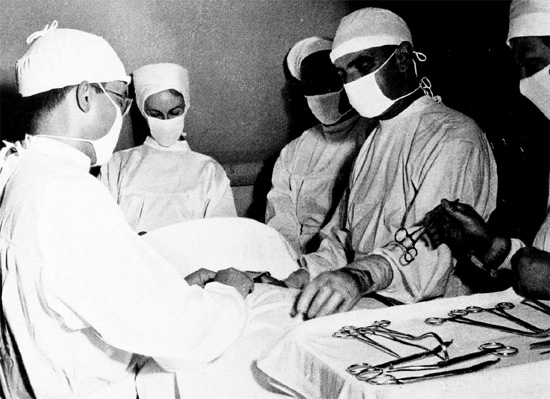
Major Walter W. McCook, MC, performs an abdominal operation at Castillian Springs, Tennessee. Picture probably taken on or around 7 June 1943.
About the middle of the month, the unit finally received some definite word to confirm the persistent rumors that they would soon leave the shores of the good old USA. It was assigned a shipping number and told to prepare for appropriate overseas movement. Boxes and crates were prepared for the equipment that was to accompany the troops (TAT –ed), and all the directives set down by the War Department procedures were complied with. As yet, no definite date of the movement was in sight, but all could see that it wasn’t far away. No further leaves or furloughs were granted and the word was passed around to make arrangements for all the families of the personnel, staying in Fayetteville, North Carolina, to go home.
Throughout the month of October, the organization was expectantly waiting for some definite orders on the impending overseas movement, but nothing further could be released for general knowledge. During the period, more work was accomplished in packing and marking the organizational equipment that was to go along with the unit. The Enlisted Men’s equipment and clothing were checked countless times, and each Officer and Nurse was made personally responsible for seeing that his, or her, personal equipment was in order. It was a busy time for all. Staff and personnel were told that the individual equipment should not include any summer uniforms, because they would not be worn in the Theater that they were heading for. That WAS the only hint that gave away the unit’s final destination. During this period, it was impossible to maintain a rigid training schedule, the emphasis being laid on individual training and physical fitness. There were a number of late transfers during this month, and the unit lost First Lieutenant Louis Golman, Captain Abraham I. Friedman, ANC Second Lieutenant Madeline Buchanan, along with 3 Enlisted Men. Promotions included First Lieutenant W. P. Gaynor and Chaplain W. H. Barsh to Captain. In spite of the rush and tense excitement of the moment, Lieutenant Colonels J. Harrell, C. E. Adams, and G. R. Benton, Major V. B. O. Hammett, and Captains J. M. Mayer and B. M. Halbstein, found time to visit the Convention of Military Surgeons in Philadelphia.
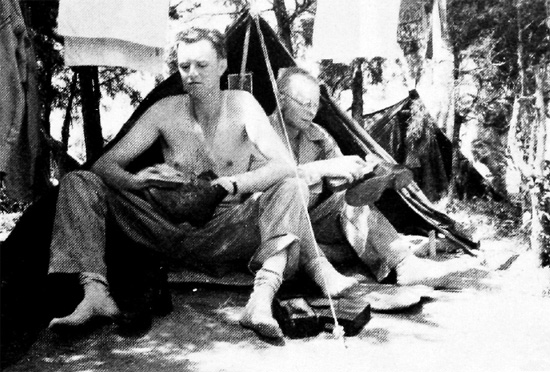
Time off during the 1943 Tennessee Maneuvers. From L to R: Corporal Gilman A. Ingvalson and Technician 5th Grade Lloyd G. Johnson.
November turned out to be the month all were waiting for, and it was still young when all Medical Officers and Enlisted personnel who had been working, until this time, in the Station Hospital at Fort Bragg and at other medical installations around the post, were recalled to the unit and told to prepare for movement almost immediately. At this time, the services of three more of the Nurses were lost: First Lieutenants L. M. Wentzel, A. B. Kestner and M. M. Wright, together with another 13 EM. To fill the vacancies in the unit ANC Second Lieutenants Olive R. DeVilbiss, Margith H. Heide, Connie A. Snape and Ida M. Walker joined the organization just before leaving Fort Bragg. As the 41st was now overstrength in Enlisted personnel, no new Enlisted Men joined the unit at this time.
Another change took place when the unit was converted to a 400-bed hospital prior to moving overseas.
Shortly after all personnel were recalled to the unit, they were confined to the immediate staging area on the post, and orders were given that no one was to have visitors, or attempt to communicate with anyone on the outside.
Preparation for Overseas Movement:
The organization boarded a train at Fort Bragg 7 November for a destination that was kept secret until it actually arrived at Camp Kilmer, Stelton, New Jersey, Staging Area for the New York Port of Embarkation, after a twenty-four hour ride from the south. From 9 to 13 November 1943 major activities consisted of showdown inspections, immunizations, checking medical identification cards and luggage tags, physical inspections, and indoctrination in security measures, including censorship, etc. Passes to visit New York were given to as many of the personnel as possible in the limited time available. On 14 November the big moment arrived, and the entire unit left Camp Kilmer Staging Area and boarded a train for the Port of Embarkation. During their stay in the area, the men practiced entraining exercises, but when the real thing came along, it was discovered that the group were infinitely more crowded than was initially anticipated. Although the train ride was only an hour or so long, everybody was just glad to have it behind them and to get aboard the ferry that would take them over to the transport vessel. By this time it was well past midnight, and so it was effectively on 15 November 1943 that the 41st Evacuation Hospital’s first overseas service became a reality. Much to everyone’s pleasant surprise, the unit was to board the former luxury liner “Queen Mary”, now designated “Transport NY 540”. The morale of the men at the time of boarding was extremely high, but it took a drop almost immediately, when shown the Enlisted Men’s quarters. The Officers and Nurses were more fortunate to be assigned state rooms on “A” and “B” decks, but the EM were sent almost below the waterline near the engine rooms on “D” and “E” decks, where living conditions were far from satisfactory.Unfortunately, there was nothing that could be done to improve them. The trip over the Atlantic was uneventful, except for a single air raid alarm. Many of the unit’s Medical Officers and some Enlisted Technicians were assigned to the First-Aid Post and Dispensary, to be manned in cases of emergency and during all boat and air raid drills; but many of the others were given what seemed to be an unusual amount of the less pleasant details aboard the ship.

Aerial view of the 41st Evacuation Hospital installations at Beechgrove, Tennessee, 14 June 1943.
United Kingdom:
20 November 1943, the “Queen Mary” steamed up the Firth of Clyde, in Scotland, and dropped anchor off Gourock and Greenock, to complete a record wartime crossing in only four days and eighteen hours. The next day, the unit debarked and went ashore at Gourock and immediately boarded a train for its new station. There was considerable confusion during the trip, but staff and personnel were finally put off at the sleepy little village of Dursley, in Gloucestershire, during the early morning hours of 22 November 1943.
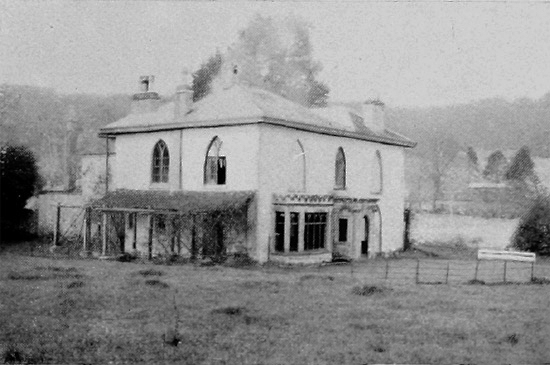
“Ranger House”, Dursley, England. Picture taken during the 41st Evacuation Hospital’s stay in the United Kingdom, 26 November 1943.
At first light, the unit marched to Highfield High School, a large unfinished school building, which was to provide space for Headquarters, billets for the Enlisted Men, and storage for the equipment. All the Officers and Nurses were billeted throughout the town with individual families in private homes. As people were wondering if the quarters were to be permanent or not, word was received that the unit was to remain in this location for the duration of its stay in England. As soon as staff and personnel had settled in their new quarters, orders were received assigning the organization to the First United States Army and instructions to provide the necessary medical service for the invasion of Hitler’s Fortress Europe. As yet, no program had been set up for a proper training period, but this would follow soon. As soon as possible a program was prescribed by the Surgeon, First US Army that was designed to stress physical fitness more than any other phase of the actual training. Physical exercises were held every morning and hikes were on the schedule at least three times weekly.
During the month of December the Nurses were granted short leaves of absence for three-day periods and were allowed to leave in groups of two. About the middle of December 1943, a policy of sending a number of Medical Officers away on DS to various Medical Schools operated by the United States Army in England was put into effect. This was continued until the unit was alerted for movement, prior to the actual invasion. Almost every Medical Officer, at one time or other was sent off to these schools to study some particular phase of the medical service they would be called upon to render under combat conditions. During the latter part of the month, the program was also expanded to include selected Nurses and Enlisted Men. The EM were sent to General Hospitals for training as Medical or Surgical Technicians. Christmas 1943 became the first one celebrated by the unit overseas, and was feted by the Officers and Nurses with a party at the Ranger House, while the Enlisted Men had a celebration on Christmas morning in the Enlisted Mess hall. Many an Officer, Nurse, or an Enlisted Man, was invited to dinner by inhabitants located throughout Dursley.
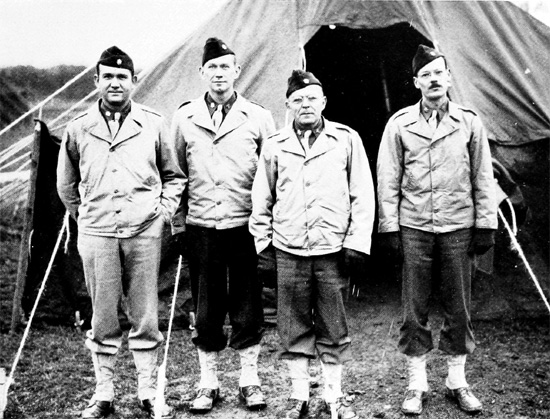
Officers of the 41st Evacuation Hospital in the United Kingdom. From L to R: Lieutenant Colonel Joe Harrell; Lieutenant Colonel George R. Benton, Jr.; Lieutenant Colonel Clinton E. Adams; and Lieutenant Colonel Van Buren O. Hammett.
During early January 1944, a great deal of the hospital equipment arrived and much time was spent in sorting, unpacking, and familiarizing all the personnel with the numerous instruments and materials on hand. The flow of equipment was continuous throughout the stay in England and many extra items considered necessary for operations, were obtained. The program of physical conditioning was continued, although the rigors of the English climate, necessitated that many outdoor activities be cancelled or moved to a later date. On 3 January 1944, another billeting party under the command of First Lieutenants E. J. Hammerbacher and J. D. Wallace was sent to Castle Cary to prepare for the arrival of the 97th Evacuation Hospital. Everything was arranged so smoothly for their arrival that the Officer in charge, First Lieutenant Edward J. Hammerbacher, MAC, received a letter of commendation from First US Army Headquarters for the work accomplished. On 24 January the same two Officers left again with a reception party for Cheddar, to receive the 24th Evacuation Hospital.
Lieutenant Colonel Joe Harrell was promoted to the rank of Colonel 26 January 1944.
During the early part of January the Enlisted Men were granted furloughs of five to seven days. An allotment of beds in London was received by the unit and most men took advantage of this opportunity to visit the English capital city. Others were more of a wandering nature and traveled widely around the country. In an effort to help the Officers and EM take advantage of their new surroundings, free transportation was provided for short trips to Bath, Cheddar, Gloucester, and other surrounding places of interest. One of the special attractions was Stratford-on-Avon, the home of William Shakespeare. The training period was maintained during the month of February and included quite a few overnight bivouacs. At this time, tentage was set up in the approved style and was inspected by the Surgeon, First US Army. The physical training aspect of the program was never relaxed and many hikes were scheduled despite the foul weather.

41st Evacuation Hospital Staff Officers during “Visitors’ Day”, at Dursley, England, December 1943. From L to R: Lieutenant Colonel Joe Harrell, MC (CO); Captain George Colyer, MC; Miss Colter (visitor); Captain William H. Barsh, ChC; Lieutenant Colonel Clinton E. Adams , MC (XO).
Changes in personnel during the month of February included the assignment of a number of ANC Officers, such as: Second Lieutenants Ruth E. Collins, Katharin Dewey, Nell L. Fountain, and Mildred A. Higgins, who joined the unit from the 2d Evacuation Hospital. Major Harry L. Alpert was relieved from assignment to this organization and re-assigned to the 5th Evacuation Hospital. He was replaced by Major Jacob Helms, MC. The following Officers also joined the organization, including: Second Lieutenant Emily A. Musante who came from the 298th General Hospital; Second Lieutenant LaRene R. Slater from the 96th General Hospital; Privates Dennis J. Tracy, Donald F. MacLean from the 471st Quartermaster Group; and Private First Class Homer L. Eaton from the 65th Field Artillery Battalion. Private Arnold Hogan was transferred to the 96th General Hospital on account of illness.
As March came the weather cleared allowing for more outdoor activities to be scheduled in the form of longer hikes and organized athletics, both for Officers and Enlisted personnel. The unit participated in another field exercise and was inspected once more by a First United States Army team. The practice of sending Officers, Nurses and Enlisted Men away on DS to Medical Schools was continued and much new equipment arrived.
Personnel changes during the month of March included the arrival of Second Lieutenant Winifred M. Briggs, who replaced Mildred A. Higgins. First Lieutenant Jeannette E. Potter was promoted to the grade of Captain on 12 March, and Second Lieutenant Clara M. Duley was promoted to First Lieutenant the same day. Second Lieutenant Maria G. Cinelli was assigned to the 96th General Hospital, while Second Lieutenants Minnie E. Banks, Floy E. Green and Maggie E. Scott were assigned to the 121st Station Hospital. Major Anton M. Miller, MC, left the 41st for the 10th Station Hospital and was replaced by Major Thomas E. Wyatt. Second Lieutenant Gertrude E. Patenaude joined from the 316th Station Hospital and Private George G. Reibeling was transferred to the 298th General Hospital. On 13 April, Nancy Jones and Ruth Stenvick, both of the American Red Cross, joined the unit on a permanent basis.
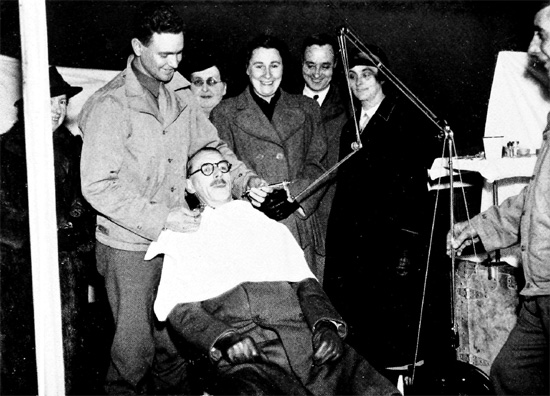
Technician 4th Grade Donald F. Willsey, demonstrates field dental equipment to local Dursley friends, during “Visitors’ Day”, March-April 1944.
It was clear and warm enough in April to begin a softball league and the 41st Evac, along with a number of other units, participated finally emerging as victors at the end of the season. Another field exercise was held, and again the Hospital satisfactorily passed First US Army inspection. On 14 April 1944 the unit was alerted for departure from Dursley, and the personnel away on DS were immediately recalled. As April wore on, there were a number of changes and the 41st hardly looked like the organization that had played such a successful part in the Tennessee maneuvers back in the Zone of Interior. Captain George Colyer was transferred to the 15th General Hospital; Captain J. J. Reardon was promoted to the rank of Major, and First Lieutenants A. L. Allion and E. J. Hammerbacher became Captains. As from 19 April, Second Lieutenant Alfred Ettinger and a Platoon of the 456th Quartermaster Laundry Company were permanently attached to provide laundry service for the hospital. Second Lieutenants Rhoda B. Richards and Augusta Robins were assigned to the 24th and 91st Evacuation Hospitals, respectively. Second Lieutenant Mary E. Fedor of this unit and Second Lieutenant Frances Davis of the 3rd Auxiliary Surgical Group, swapped assignments. Privates Winford Hill and Lewis A. Temple came from the 353d Replacement Depot and also joined the unit. Fillers were still required.
May 1944 found the Hospital wondering just how much longer it would be before the real invasion of the continent would begin, and, indeed, if there was to be an invasion after all. Everyone was still engaging in physical training periods to an ever increasing degree, and indulging in more and more outdoor exercises. The weather during this period was unusually pleasant and most of the personnel enjoyed the outdoor activities. More hospital equipment continued to arrive and much work was put into getting it all in final shape and condition for immediate use. All the necessary supplies were sterilized and packed, and all the trucks waterproofed and made ready for a forthcoming sea voyage. The trucks were eventually combat-loaded with all the essential equipment necessary to start the hospital functioning immediately upon arrival on the continent and to continue such a function for a minimal period of ten days with the supplies already on hand. By the end of the month, all that remained to do was to secure the individual and personal equipment and make the exit. All of the remainder of the hospital equipment that could not be loaded on the trucks (about 45 tons was to be shipped) was taken to the port area and loaded on a landing craft there. Once more, the month of May again saw a large number of changes in the unit. Major Joe Hammett was promoted to Lieutenant Colonel 4 May; Second Lieutenant Elma M. Miller suffered a broken leg while playing softball and was transferred to the 94th General Hospital. A Captain Herbert B. Hutt was assigned and joined the organization 28 May. Technicians 5th Grade Lome H. Paynter and Private First Class Henry Nelson were transferred to the 94th General Hospital.
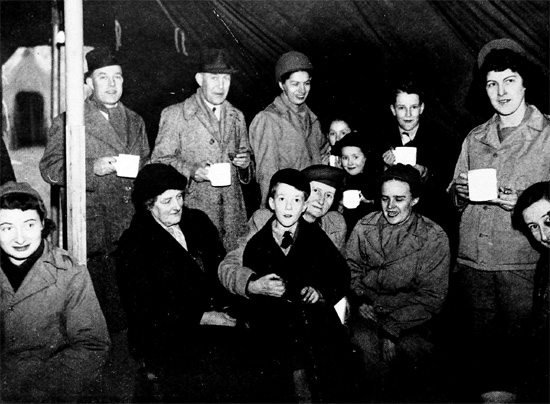
English Dursley friends and children visit the 41st Evacuation Hospital, March-April 1944.
Station – United Kingdom – 41st Evacuation Hospital
Dursley – 22 November 1943 > 7 June 1944
At 1800 hours, 7 June 1944, orders were received for the motor convoy to leave its Dursley, Gloucestershire, England, home station at 2200 hours and proceed to Truro, England. The vehicles had been previously loaded and were ready, except for a few last minute details. At 2200 hours sharp the convoy, consisting of fifty-seven vehicles, 8 Officers, and 58 Enlisted Men, departed for Truro, England. At 0030 hours, 8 June, orders were received that the remainder of the personnel and their equipment were to board the train at Dursley at 0945 hours bound for the marshalling area. At 0830 hours 31 Officers, 40 Nurses, 2 ARC workers and 191 Enlisted Men effectively entrained. At 0945 hours the group left Dursley and proceeded to Cam, England, where the men and women changed trains and further moved on to Truro where they finally arrived at 1730 hours. Trucks were at the station and took them to the designated marshalling area, between Truro and Falmouth. Here they boarded another motor convoy which had left the night before. Areas F-2, F-3, and F-5 were designated for the 41st Evac Hosp. The night of 8 June 1944 was spent in receiving last minute instructions and making final preparations. Wool blankets were issued by the marshalling area personnel and everyone not needed for duty was told to try and sleep. All housekeeping details were handled by the marshalling area personnel. 9 June 1944 the unit left the area to embark on the S/S James I. McKay (MT 244), ready and waiting at Falmouth. The unit left the area at 1830 hours on trucks furnished by a Quartermaster Corps Truck Company. The convoy stopped at Falmouth where the personnel detrucked and lined up according to rank. After this long procedure had ended, everyone was issued anti-seasickness pills. When this was over, the groups picked up their duffel bags and walked to the ship, nearly a mile away. By 2100 all vehicles and personnel had successfully boarded.

ANC Nurses somewhere in the United Kingdom, spring 1944. From L to R: First Lieutenant Florence E. Thompson; First Lieutenant Rosemary M. Gaylord; First Lieutenant Phyllis E. Bailey; First Lieutenant Mary E. Brown; and First Lieutenant Helen E. Callesen.
The following days, 10 – 11 – and 12 June were spent on board the S/S James I. McKay. Living conditions aboard the ship were not very satisfactory, particularly for the Nurses. One end of the hatch was reserved for the ANC Officers, while all other personnel were placed in the hold of the ship. Male Officers shared bunks. The only entrance was down a ladder, and the Nurses had to pass through the men’s area to get to their own quarters. Little, if any, provision had been made for washing facilities. The Officers and Nurses could utilize the crew’s latrines and washroom facilities, while the EM got water from spigots and washed from their helmets. Temporary latrines were built on deck with drainage over the side of the ship for the Enlisted personnel. Two other units were on the ship with the 41st, making conditions fairly crowded. Chow consisted of “5-in-1” rations, which were issued to groups of five individuals. They contained canned vegetables and a variety of meats, canned butter, jam, sugar, instant coffee, candy, etc. Sometime early in the morning of 11 June 1944 the ship lifted anchor and proceeded to cross the English Channel part of a large convoy, well protected by overhead balloons and planes all the way.
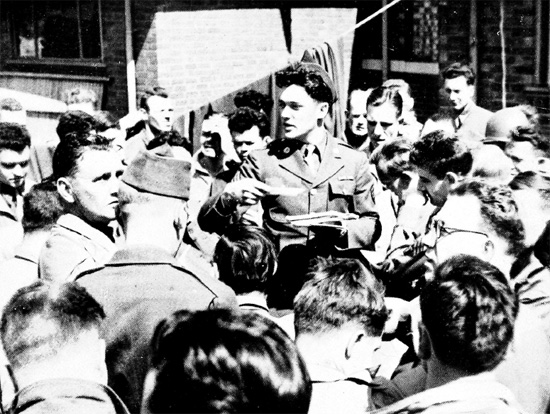
An important morale-builder; “Mail Call” at Dursley, England, May 1944.
France:
The day and night of 12 June was spent aboard ship just off Omaha Beach, Normandy, France. As the captain of the ship could not unload without orders, and no orders arrived, it was urgent to contact shore personnel with regards to unloading. This meant hailing a passing “dukw”, going inshore and contact the beach parties in charge. This was finally arranged, and the organization managed to secure one empty LCT and load it with equipment and personnel before darkness forced them to stop. That night there was a great deal of enemy air activity and the ships in the artificial harbor were ideal targets. The whole coastline was obscured by a smoke screen. Fortunately the intense antiaircraft fire prevented any enemy aircraft from coming directly overhead, and thus everyone passed the night without suffering any hits.
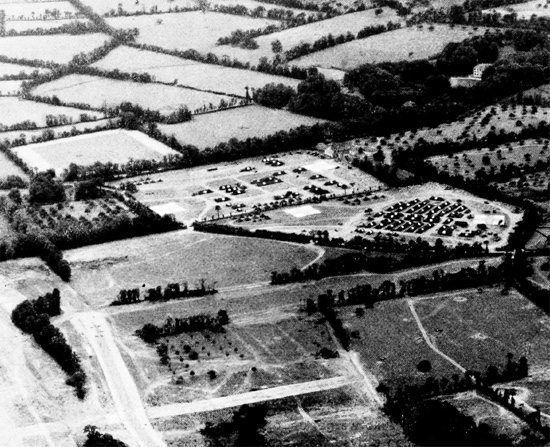
Aerial view of the 41st Evacuation Hospital established near Le Molay, France, 21 June 1944 (the 5th Evac Hosp across the hedgerow is in the process of moving).
On Tuesday, 13 June 1944, some vehicles and personnel were unloaded. Help was sent from shore, but the majority of the unloading had to be done by the unit’s own personnel, and in fact, they actually unloaded many vehicles for the Ordnance and Engineer units on the boat, as their vehicles had to be unloaded first. A group of longshoremen or other experienced personnel would have certainly facilitated the work. All personnel climbed down the net onto the landing barge. There was considerable praying over this, but it was accomplished without any mishaps. After everyone was kind of settled the landing craft started for shore. When this was going on, the tide began to rise and the other boats on the beach began to get a water line about them. As soon as the water line got high enough for them, they went out in the channel to the ships for more supplies. The men were crowded on the landing barge and many of them just climbed on top of the trucks to ride ashore; but there were some who waded ashore. The water was up to their waists. Then it began to rain and the weather became miserable. Two of the first trucks went off one of the barges and got stuck in the sand. They had to be pulled out of the sands by a bulldozer. The barge eventually backed out away from the beach to find another place to land, which took over four hours. As soon as the personnel had landed safely, everyone jumped off the trucks with duffel bags and individual equipment and waited for the others to arrive. After all the personnel had disembarked the group marched away from the beach and the luggage was taken in a “dukw” to the place where the party’s liaison officer conducted them to the transit area. They walked four miles to the area and to ‘block eleven’ arriving there late in the afternoon. The area was square and three sides of this area were surrounded by ditches. That was the first night the men slept in ditches. The sleeping quarters were not as good as foxholes, but provided a few hours sleep, although the ground was rocked continually by bombs and antiaircraft guns installed nearer the shore.

Officers pertaining to 41st Evacuation Hospital during they stay in France, 1944. Back row, from L to R: First Lieutenant Robert L. Rein; First Lieutenant Eli J. Candel; First Lieutenant John Bradbury. Front row, from L to R: First Lieutenant Allen L. Allion; Lieutenant Colonel Joe Harrell; visiting WAC Officer; Captain Harry L. Alpert; and Captain Anton M. Miller.
At 0815 hours, 14 June 1944 the group got up, ate some K-rations, and waited for transportation. After the promised trucks arrived, they moved to a site in the vicinity of Le Molay, France, where they arrived at 0945 hours. The men then began to set up the hospital. Many casualties had accumulated since D-Day in all Clearing Stations, Field Hospitals and other medical installations capable of handling patients. When the 41st Evac opened, these unloaded, as they should have done, but it filled the newly arrived unit to overflowing within forty-eight hours, and resulted in considerable confusion, for this was their first experience in a combat zone. However, within seventy-two hours a completely re-organized method of operation had been arranged, and from that time on function became more efficient, if not smooth, which was to be expected. The 41st Evacuation Hospital was able to operate for about seven days without need for additional supplies and by that time most of its supplies and other equipment had been located on the beach, although it required constant patrolling to beat the other medical units to it. In the end, however, the unit came through in good shape and with very little loss. The equipment arrived in good condition, completely waterproofed, and ready to be used after due unpacking and preparation.

Technician 5th Grade Theodore R. Brodt, the man who kept everyone supplied with potable water. Picture taken course of June 1944.
The first patient was received at 1630 hours, 14 June 1944. When receiving commenced, four operating tables had been installed and were ready. The first operation was performed at 1715 hours. As more patients were admitted three operating teams were assigned and two teams kept in reserve. The inflow of patients was greater than the capacity of the hospital, chiefly because it had to admit all patients regardless of any diagnosis. The following morning there were approximately 40 patients awaiting surgery. At this time all available personnel were assigned, with operating teams working 18 hours a day and overlapping in such a manner as to keep four teams operating at all times. In spite of this, the backlog of patients continued to grow. Function in this manner continued for three more days and nights with the backlog of patients awaiting surgery reaching 160. It was at this time that the 41st received a visit of First United States Army officials, who authorized evacuation of transportable patients who could not receive definitive treatment within twenty-four hours. Accordingly, 95 patients were immediately evacuated. On the fourth day one Auxiliary Surgical Team was attached and immediately assigned to duty. This team was relieved on the following morning and a second team joined the organization that afternoon. With the opening of the 5th Evacuation Hospital, and the attachment of the Auxiliary Surgical Team, the backlog began to dwindle and the outdated patients were rapidly cleared out. The admission rate was such, however, that it was only on the eighth functioning day that the last patient could be operated. For a period of thirty minutes there were no patients awaiting surgery, following which, patients were again admitted in a steady flow until the facility closed for admission of new cases on 29 June 1944.
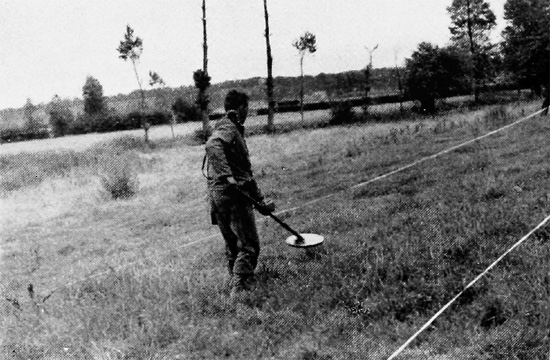
Prior to setting up at Airel, France. Engineer at work with clearing mines, 24 July 1944.
During the first week of actual function in combat valuable lessons were learned. The physical setup of the Operating Section functioned very satisfactorily and hardly any changes were made in the section. Central Supply deserved untold credit for their operation during this period. At no time was any Department of the 41st wanting for sterile supplies. The forethought in overstocking paid great dividends. At the time the ready-prepared supplies were beginning to get dangerously low, the laundry began to function and relieved this situation. During this entire time considerable trouble was experienced with the Coleman burners of both the autoclaves and the instrument sterilizers, this trouble being apparently due to the fact that they were not prepared for use of leaded gasoline and not made to stand the punishment of long continuous use. A most suitable substitute for the sterilizer burners was found in the burner unit of field ranges. The personnel of the Operating Section was found to be inadequate for the number of surgical cases to be handled. The assignment of Captain William D. Monahan, attachment of Major D. Haynes, and personnel from a Medical Collecting Company to serve as extra litter bearers proved a great help. It required a set of litter bearers for each two tables to handle patients. The Officer staff was found to be insufficient, and to handle the number of patients being admitted would in fact have required four additional Auxiliary Surgical Teams with their Enlisted personnel. One more anesthetist was needed to adequately staff the unit’s own teams, making a total of five teams formed by the 41st.
It was learned early that the patients awaiting surgery had to be grouped. The scattering of patients throughout the hospital made triage of patients extremely difficult, and resulted in the inability to properly assign priority to the patient. This situation resulted in several bottlenecks, which were corrected by re-designation of the wards. The post-operative care of the patients and the early evacuation of transportable cases were greatly improved with the instigation of ward rounds by the operating surgeons before and after their normal tour of duty. In the first week of operation there was considerable difficulty in maintaining a steady flow of X-Rays and at one time the triage Officers were spending 40% of their time in getting X-Rays of the patients. This error was not corrected during the first week, but as time went on, it did improve a great deal.
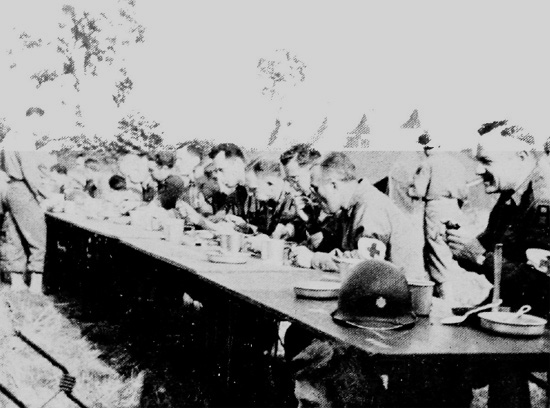
Officers enjoy dinner in the open while bivouacking. Officers’ Mess, Guilberville, France, 7 August 1944.
Stations – France – 41st Evacuation Hospital
Le Molay – 14 June 1944 > 29 June 1944
Airel – 24 July 1944 > 6 August 1944
Guilberville – 7 August 1944 > 9 August 1944 (bivouac)
Vernix – 9 August 1944 > 19 August 1944
Sées – 20 August 1944 > 29 August 1944
Senonches – 31 August 1944 > 10 September 1944
Like most other Departments of the 41st Evac during the first week of operation, the wards were almost “snowed under” by the deluge of casualties which the hospital received during the first seventy-two hours. Three major difficulties developed in the Ward Section during the first week. Within three hours of beginning operation the shock ward was filled with pre-operative cases, only a few of which were in a state of shock. As the casualties continued to pour in, other wards were rapidly filled with pre-operative patients in a manner which had not been foreseen in pre-invasion planning, and the pre-arranged division of the wards into various categories was blitzed into the discard. The second major difficulty, which became apparent early in the action, was the inadequacy of the number of Ward Officers, as well as Operating Surgeons. With the Ward Officers divided into two shifts to work on a twenty-four hours basis, each Officer was loaded with at least 100 patients to care for, which was too many. The third problem encountered was the uncertainty which existed in the minds of some Ward Officers as to just what they were to do with the patients in the way of professional care. With their current inexperience, none of them knew how long any given case would wait on the ward for definitive treatment. There was confusion as to whether the Ward Officer, or the Surgeon, should examine the wounds, who should order what treatment, who should order the patients to the operating rooms, etc. After the first few days, however, the Ward Section functioned very well, in spite of the large number of casualties being admitted to the Hospital. The Nurses and Enlisted Men of the section deserved a lot of credit for their initiative, skill and willingness displayed during this difficult period. These difficulties and problems were the birth pains of a real, combat effective, Ward Section. No doubt all other Departments faced other and equally distressing problems. During the period of severe stress, the entire personnel of the hospital labored heroically to meet the task at hand, and the freely expended energies of the personnel contributed in great measure to the eventual restoration of order.
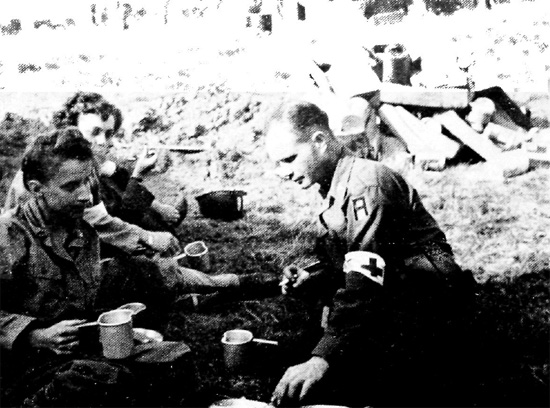
ANC Officers First Lieutenant Helen E. Callesen; Second Lieutenant Phyllis N. Richardson; and First Lieutenant Howard E. Thompson, MAC, enjoy a coffee after dinner. Guilberville, France, 8 August 1944.
The Ward Section had by D+15 succeeded in ironing out the major difficulties arising during the initial phase of operation. From 21 June until 30 June 1944 the handling of patients on the wards proceeded in a more orderly and systematic manner. From 19 June on the organization ceased admitting Neuro-Psychiatric cases in accordance with orders issued by the Surgeon, First US Army. On 23 June 1944, an entirely new ward was opened, designated the Neuro-Surgical Ward. The purpose of this action was to group together all neuro-surgical cases, so that they might receive the benefit of special attention and it was further thought that this measure would also help to lighten the burden of the general post-operative wards by relieving them of the care of difficult and complex neuro-surgical cases. The new ward was equipped and staffed by the Ward Section, except that no Ward Officer was assigned to duty in it. From 23 June to the end of June the Neuro-Surgical Ward admitted 26 cases.
During the period from beginning of operation to D+15, the great majority of the patients admitted to the wards were traumatic surgical cases (mainly battle casualties). Out of 958 cases, 268 were non-surgical, and among these, 118 were neuro-psychiatric cases. Of the 151 medical cases, 61 patients were ill with recurrent malaria, contracted earlier in the Mediterranean Theater. Malaria was the principle medical problem and in point of view of numbers, malaria cases outranked any other medical disease encountered during the stay in France. A total of 215 cases of malaria were admitted up to the end of June. Of this number, 97 were evacuated to the UK. This figure seems high, but it is to be remembered that many patients were evacuated during the first week or ten days of operation on the continent, and precisely at Le Molay when the evacuation policy was much shorter. Of the total of 215, 118 cases were discharged to duty or transferred to a Convalescent Hospital with the expectation that they would soon be ready for duty again. All the cases of malaria were presumably recurrences, occurring in troops who had seen previous action in Africa and Sicily. The great majority were of only moderate severity, readily brought under control with quinine therapy. Most of these men exhibited none of the stigmata of chronic malaria, and were able to return to duty following 10 to 15 days of therapy and rest. Some, however, exhibited anemia, splenomegaly, or general debility to such a degree that evacuation was obviously indicated.
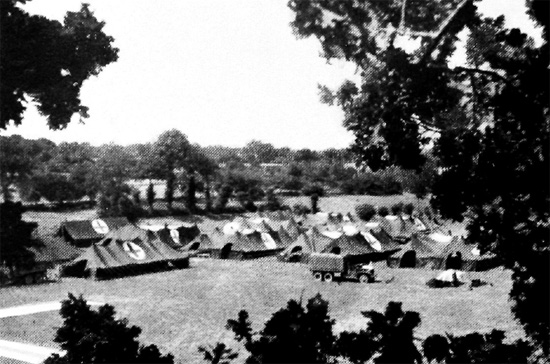
41st Evacuation Hospital area, Brécey (Vernix), France. Picture taken 10 August 1944.
During June 1944 the total bed capacity of the Hospital was increased from 400 to 488. The evacuation policy came down from a 24-hour to a 10-day policy. For a while after the inauguration of the latter day policy, the census did not at any time exceed 400 patients. Laboratory, Pharmacy and Dispensary personnel immediately began to work after official opening.
Laboratory Tests – 41st Evacuation Hospital From 14 through 21 June 1944, the Laboratory performed 179 urinalysis tests, 216 hematology tests, 21 serology tests, 46 blood chemistry tests, 69 bacteriology tests, and 414 parasitology tests. The Pharmacy filled 282 narcotic and 424 regular prescriptions.
The Dispensary treated 94 men from over twenty different units during the first month of combat in France, involving units such as: 1st Medical Depot; Service Battery, 195th Antiaircraft Artillery Automatic Weapons Battalion (SP); 1340th Engineer Combat Battalion; Headquarters, 41st Replacement Battalion; Headquarters, 56th Medical Battalion; 3518th Ordnance MAM Company; 3914th Quartermaster Corps Company; Headquarters, V Corps; Battery C, 92d Armored Field Artillery Battalion; 507th Ordnance Company; 486th Ordnance Evacuation Battalion; 84th Ordnance Battalion; 3168th Quartermaster Corps Battalion; 452d Medical Collecting Company; 127th Ordnance Company; 324th Engineer Combat Battalion; and the 2d Armored Division.
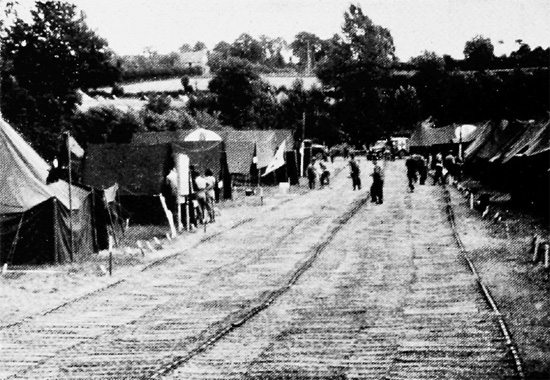
View of ‘main street’, 41st Evacuation Hospital setup at Brécey (Vernix), France, 17 August 1944.
On 19 June 1944, Major Esther R. McCafferty, Chief Nurse, First United States Army, arrived to pay the unit a three-day visit. She visited the wards, operating rooms and patients’ mess. She also helped with the nursing on one of the busiest wards. At the end of her visit she told both the staff and personnel that she had no criticism, constructive or otherwise, to make and that she had picked up some pointers that she would readily pass on to other Evacuation Hospital nursing staffs.
It was here at Le Molay that the American Red Cross girls were immediately precipitated into the rush of receiving and worked in the admission tent, forgetting their social work and recreation training to become canteen girls, since that need was indicated. There they served hot cocoa and coffee and occasional snacks of biscuits and jam to the incoming patients. In their spare moments they washed dirty faces, held vomiting heads, and found themselves the well-known emergency aid in surprising ways. They managed to whip around the wards and handed out such supplies as were necessary to the patients. On 26 June 1944 while the Hospital was still established at Le Molay, France, 10 German Prisoners of War were obtained to work in the installation. Two days later, 9 French civilians were sent by the Civil Affairs Officer in La Mine to help the prisoners. To supplement the personnel, one team from the 3d Auxiliary Surgical Group, 1 Medical Officer from the 176th Medical Battalion, 3 Medical Officers from the 1st Auxiliary Surgical Group and 1 Nurse from the 1st Auxiliary Surgical Group, served with the Hospital from 14 to 30 June 1944.
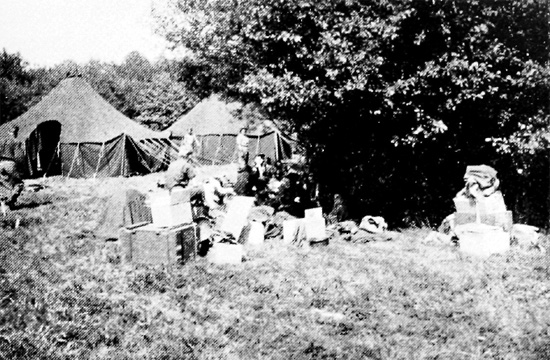
Moving day at Brécey (Vernix), France, 20 August 1944. Nurses and baggage wait for a ride …
The Chaplain buried over 100 American soldiers in the American Military Cemetery No. 3 at La Cambe, Normandy. Special interest had been given to rendering a spiritual ministry to the enemy PWs in their native tongue.
During the unit’s stay at Le Molay there was considerable aerial activity in and around the area. On 20 June 1944 an enemy fighter strafed the road in front of the hospital, with the plane being finally shot down by Allied aircraft. During the dogfight, however, several stray bullets entered the hospital area, one passing through a ward tent and one through the recreation tent. Fortunately there were no casualties. On 22 June there was even more aerial activity overhead and a stray bullet passed over the hospital and went through the mail tent. At 1900 hours 30 June, a large formation of Allied bombers passed over the facility and bombed a target some fifteen miles southeast of the hospital’s site and then returned to England. Shortly afterwards an enemy plane flew over the area, but antiaircraft fire drove it off, although it did not appear to have been hit. The 41st closed for operations from 29 June until 19 July 1944 with everyone enjoying a good rest.
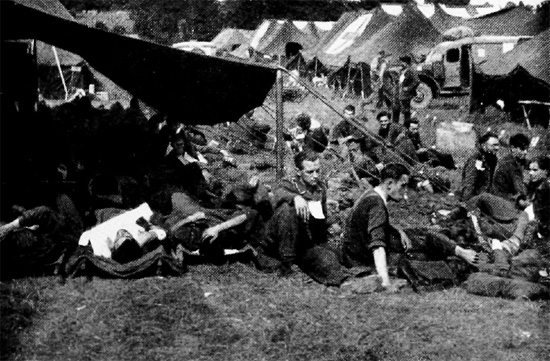
German PWs wait to be triaged for medical treatment. Picture taken at the 41st Evacuation Hospital facilities, Sées, France, 20 August 1944.
At 1000 hours, 19 July 1944, the Hospital and personnel moved by convoy in two shuttles from Le Molay to Airel, France, a distance of about twenty miles, detrucked, set up the hospital, and opened for receipt of patients at 1800 hours, although ‘official’ opening would only be at 1200 hours, 24 July 1944. Admission was not flooded the first day, although later on the capacity of the unit was taxed considerably. At this location, only a few miles directly north of St. Lô, there was continuous aerial and ground activity only a few miles directly in front of the installation. In fact, the 41st was too close to the front, for the billeting detail had to wait for a cleanup party to rout snipers out of the field before the hospital could be laid out. Then it was necessary for everyone to move in and begin work before the field could even be cleared of mines. At this location the unit had been told to prepare for a considerable number of casualties, for the big breakthrough at St. Lô was about to begin. While the men were pitching the numerous tents, enemy planes came over and began to strafe. Everyone “hit the dirt,” as bullets were flying all around. One member of a Motor Ambulance Company was hit in the thigh and immediately admitted to the hospital. A live German “potato masher” was also found the same afternoon in the Officers’ area. One of the German Prisoners of War picked it up, inspected it and made sure it would not explode. While setting up the hospital tentage, the Engineers came in to de-mine the place and many of the Enlisted Men were amused when they went around their pup tents to see if any mines were laid nearby. Fortunately, no mines were found. In the evening of 19 July 1944 after supper Colonel J. Harrell held a formation for the EM and it was again interrupted by enemy aircraft. Everybody fled in different directions for cover, with the purpose of the formation entirely forgotten in the excitement. On 24 July, there was a band concert, the second to be held since the Hospital arrived on the European Continent. The same night there was a very heavy artillery fire, followed by four air attacks. Many personnel lay awake practically all night, prepared to make a “bee-line” for the foxholes. On 25 July 1944, approximately 3,000 American, British and Canadian planes, launching a coordinated attack on both flanks of the Normandy battlefront, passed over the 41st Evac. The target was south and a little west of the Hospital in the vicinity of St. Lô. The aircraft signaled the beginning of the big Allied breakthrough. Blasts and concussions shook the ground and made the tents shake. In a short time (almost four hours) casualties began rolling in, consisting of American troops, French civilians and some German soldiers. The greater portion of the casualties that day and the next day were GIs, as the bombers apparently let their loads loose a little too soon, and quite a number of the soldiers who were in the lead suffered considerably. A casualty was brought in, accompanied by his buddy. The lad was in great grievance for his fellow soldier and kneeled down outside the receiving tent and began to pray. Chaplain William H. Barsh came over to where the lad was kneeling and took him over to his tent. His buddy did not survive the Allied bombing.
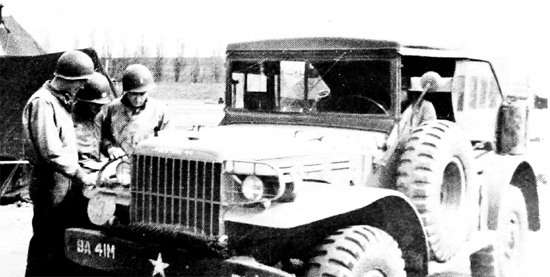
Somewhere in the ETO, 1944. From L to R: Captain William A. Greene, Jr.; Captain William P. Gaynor; and First Lieutenant William V. Ivery, next to a ¾-ton 4 x 4 Command Truck.
On 25 July 1944, Lieutenant General Leslie J. McNair (CG First Army Group, bogus force destined to hold enemy forces in the Pas de Calais area, former Army Ground Forces Commander responsible for organization & training in the ZI –ed), was killed during the carpet bombing and his body brought to the hospital and kept under guard until arrangements were made for his burial.
On 28 July 1944, enemy planes were over the hospital again and dropped bombs nearby, striking an armored unit. Among other things, Miss Bebe Daniels visited the Hospital at Airel, spending 8 hours at the site, where she made an electrical transcription which she later broadcasted in the States. On 29 July 10 more enemy PWs were secured from a PW enclosure and began to work with the organization as labor details. During July 1944, Captains W. D. Monahan and S. R. Sherman left this organization for assignment with the 30th Infantry Division. The Operative Section functioned continuously throughout the remainder of July. Due to the fact that all patients had to be admitted and given definitive treatment, the backlog reached its greatest peak ever on 28 July, at which time it was recorded as 244. Sufficient Auxiliary Surgical Teams were obtained and attached to maintain an average output of approximately 100 patients through the operative section per twenty-four hour period. The output could have been increased by 10 to 15% had the original auxiliary teams assigned this unit been allowed to stay. More personnel was assigned and joined the Hospital in the course of July 1944.
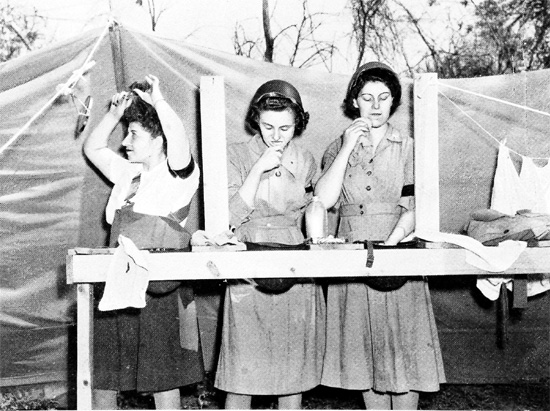
Brushing up and preparing for a “date” ? From L to R: ANC Officers Second Lieutenant Maria G. Cinelli; First Lieutenant Mary E. Brown; and First Lieutenant Mary E. Twamley. Picture taken somewhere in the ETO, during spring or summer of 1944.
It is interesting to note that only a single case of gas gangrene was encountered during this part of the Airel operation and this case was a German PW who was admitted to the Hospital over 48 hours subsequent to his injury, with the infection present at the time of admission. No case developed after admission to the hospital in spite of the fact that some patients did not go to surgery for a period of 48 hours. This record was attributable to several factors which it was believed were of vital importance. The first factor was that patients were admitted to the installation by wards containing 36 beds each. Admissions were to a single ward until it was completely filled, at which time admissions began on a second ward. This process was continued until such time as the ward first receiving patients had been completely emptied by processing those patients through the operating rooms. No patients were admitted to the ward from which patients were being processed to the OR, and no patients were taken from other wards during that time, except on order of the Chief of Surgery, or his assistant. By following this procedure the oldest patients in the hospital were always referred to the OR first. This, of course, did not include the Shock Ward from which patients were removed as soon as their condition became stabilized. The second factor was that of triage. The system then being used on this service rendered it possible for the Chief of Surgery or his assistant to triage each ward as it filled with patients, thereby getting those patients to surgery first who would most likely develop gas infection if allowed to go long untreated. The third factor was that penicillin and sulfadiazine were administered routinely in pre-operative patients, so that in spite of the fact that some patients reached the operating rooms only 24 to 48 hours after admission, the incidence of all types of infection was very low. The fourth factor was that the Chief of Surgery insisted that wounds be debrided to their depth, that all devitalized muscles be removed and that facial layers be adequately incised. The fifth and final factor was the splendid cooperation received from the Chief of the Ward Section and his staff in reporting to the Chief of Surgery any pre-operative cases which, in their opinion, were going “sour.”
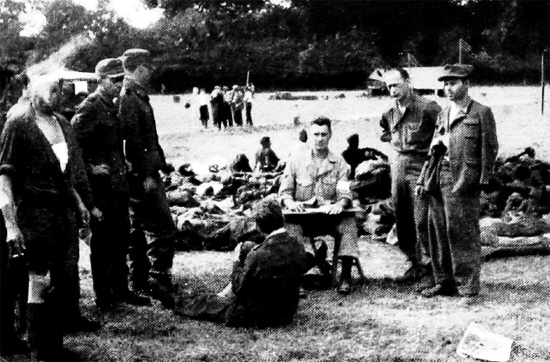
Staff Sergeant Arthur W. James checks and registers German patients at Sées, France, 20-21 August 1944.
Evacuation presented somewhat of a bottleneck and caused considerable difficulty in maintaining an adequate number of post-operative beds while at Airel, France. It was therefore decided to leave pre-operative patients on the litters, placing the litters on the cots when the patients entered the ward; patients then were to remain on the litter until they reached their ultimate destination in a post-operative ward. This change in procedure was designed to save much time lost in handling patients back and forth between litters and folding cots, and also it spared the patient the trauma incidental to the handling. The Ward Officers at Airel found it to be very difficult to keep the various categories of patients (as pre-operative, post-operative, high-priority, transportable, non-transportable, and medical) properly separated when the organization was subjected to a large number of admissions within a short time, and when the census exceeded 300 cases. This problem was solved as well as possible by frequent re-arrangement of the patients within certain wards, and by changing the designation of certain wards frequently.
During the time spent at Airel it was apparent that the number of Medical Officers available as well as the Enlisted personnel of the Ward Sections was inadequate. It was necessary for them to work from 14 to 20 hours daily to accomplish their work. This was done willingly by all personnel, but had it continued it would have affected their stamina and decreased their efficiency.
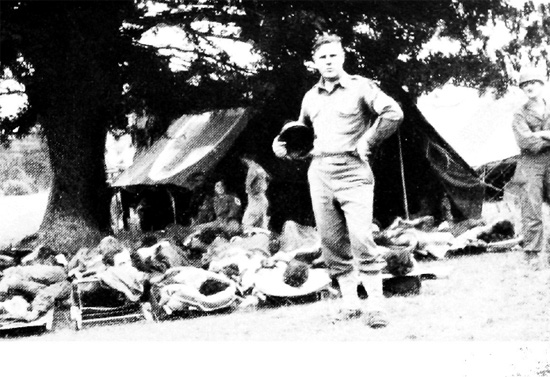
Chaplain William H. Barsh with German Prisoners of War, 20-21 August 1944. He supplied them with religious literature in their own language, and provided the necessary spiritual comfort too.
Laboratory Tests – 41st Evacuation Hospital When stationed at Airel, France, the Laboratory performed 221 urinalysis tests, 117 hematology tests, 21 serology tests, 29 blood chemistry tests, 27 bacteriology tests, and 34 parasitology tests. The Pharmacy filled 311 regular prescriptions and 252 narcotic prescriptions. During the same period 414 pints of whole blood were used and 169,800,000 units of penicillin.
At Airel it became necessary to have the auxiliary X-Ray unit pertaining to the 3d Auxiliary Surgical Group supplement the regular staff and equipment to turn out the required examinations required by the X-Ray Department. The group arrived on 24 July 1944 and commenced to function the same day. Special commendation was due the personnel of the X-Ray section for their sustained, uncomplaining and devoted attention to their duties. It was gratifying to witness the tender care, speed, efficiency and cheerfulness with which they handled the patients, even after long hours of work and continuous drive. In their endeavor to attain speed, numerous cautions were given for their lack of self-regard in subjecting themselves to exposure to irradiation.
On 6 August 1944, and following orders from the Surgeon, First United States Army, all transportable patients remaining in the hospital were evacuated to the 106th Evacuation Hospital nearby, and the personnel took down all tentage and equipment and prepared for movement on the following day. A holding detachment, with Captain James T. Williams in charge, was established to care for the remaining patients at the facility until such time as they became transportable. The following day, 7 August, the unit moved in convoy from Airel, France, through St. Lô, to Guilberville, France, south of Torigni-sur-Vire. Practically all of the tentage was set up that day when orders were received to stop pitching, look for a site farther south and west, as the Germans were counter-attacking in the sector and it appeared that the location might become exposed. So the unit remained in bivouac at Guilberville until 9 August, at which time it moved to a location in Vernix, France, about four miles west of Brécey, moving by convoy. The Hospital was set up and opened at 1000 hours on 9 August 1944.
The organization actively received patients at this location from 9 August to 19 August 1944. This was one the most satisfactory sites and function was much better than it had ever been before. The organization was however installed directly in the path of the German counter-attack, the objective of which was to break through to Avranches. On 11 August at 0300 hours, enemy planes dropped flares and bombs approximately two miles from the site in a concentrated bombing of an Army Ordnance Depot. This was one of the biggest enemy bombings ever witnessed and the complete installation was plainly lit up by the flares and the fires they started. Patients and personnel alike were frightened and sought refuge in foxholes and anything else they felt safe beneath. By 15 August, however, the Germans were on the run again and the 41st Evac was left far behind. At Vernix, the 41st was ordered to support largely the 2d and 3d Armored Divisions, as well as their organic units. As these armored elements moved further to the east, the line of evacuation became longer and soon the unit remained far behind the front. The long haul was not good for the more seriously injured patients and a number of them were in very bad condition on arrival at the hospital. There was a continuous flow of casualties of the more serious type, and it was always a difficult matter to keep the backlog down, and evacuation going. The 91st Evacuation Hospital was set up within 500 yards and shared equally in the care of casualties from the sector. The Operative Section’s installation was exceptionally smooth at Brécey and it was ready for operation as soon as patients started coming in at 1800 hours. However, surgery did not actually get under way until 0100 hours, 10 August 1944, because of the type of cases being admitted and of which at least 75% were of the more serious type. Admission of patients being extremely rapid, the backlog reached 280 at 0500 hours, 11 August. At this time three Auxiliary Surgical Teams were attached, the teams being headed by Major Young, Captain Montanus and Major Morgan. With the help of the attached teams the admission rate was approximately equal to the output of the operative section.
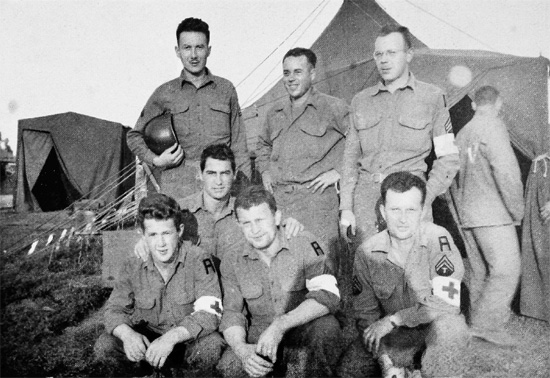
Personnel of the X-Ray Department. Back row, from L to R: Corporal Andrew G. Yanicak; Private Galen J. Lines; Staff Sergeant Tony S. Zigala. Front row, from L to R: Private First Class Dennis J. Tracey; Corporal Rubin Shapiro; Staff Sergeant John J. Kish; and Technician 5th Grade William J. Mueller, France, August 1944.
A total of 656 patients were operated on from 0100 hours, 10 August, to 0100 hours, 17 August, an average of 95 patients per day. Triage during this period was difficult, yet effective and no cases of gas gangrene were encountered. The new setup of wards was used at this location; each ward consisting of two tents joined at the sides, rather than at the ends. The placing of such a great number of pre-operative casualties in the wards presented an acute problem. Wards 1, 2, 3, 4, 5 and 9 were filled to capacity, after which Ward 10 (previously designated as non-surgical disease ward) was completely filled. Meanwhile, the Special Services tent was cleared, and hurried preparations made for its use as an extra ward; lightly wounded cases were sent to this tent and placed on litters and by 0500 hours on 11 August this emergency tent was filled with 38 patients. In addition, Ward 11 (another medical ward) held 34 patients, more than half of whom were wounded pre-operative cases. Wards 6, 7 and 8 were kept clear for the reception of post-operatives. Needless to say, considerable difficulty was experienced in operating the extra Wards listed as 10, 11 and SS as the T/O hardly furnished adequate personnel for such a large number (536) of beds. That the task was accomplished to the extent of satisfactory care of the patients reflected credit upon the entire personnel complement of the Ward Section, all of whom willingly made the necessary extra effort. After this first deluge of casualties, the rate of admissions slowed somewhat, and the Hospital was able gradually to work itself out of the problem.
During August the 41st was given additional Enlisted personnel from the 493rd Medical Collecting Company, surgical teams from the 3d Auxiliary Surgical Group, and from the 56th General Hospital, as well as several groups of Nurses temporarily assigned from the 32d General Hospital, 97th Evacuation Hospital, 30th General Hospital, 108th General Hospital, 58th General Hospital, 25th General Hospital and the 2d General Hospital. The personnel were also supplemented by some Enlisted Men from the 495th Medical Collecting Company and the 175th Medical Battalion.
The mobile X-Ray unit from the 3d Auxiliary Surgical Group was continuously used to supplement the unit’s own X-Ray department and it was extensively. Approximately 40 enemy Prisoners of War were used as laborers. At Brécey, 10-day duty cases and VD cases were transferred to the 4th Convalescent Hospital; contagious diseases, malaria and SIWs (self-inflicted wounds –ed) went to the 91st Medical Gas Treatment Battalion. All N-P (neuro-psychiatric –ed) cases, including combat exhaustion, were transferred to the Combat Exhaustion Center. Definitive surgical care was given to all Allied wounded, although a few of the lightly wounded cases were admitted, re-dressed, given penicillin, sulfa drugs, prepared for further evacuation and transferred without the benefit of surgery. This was necessary under the conditions. Injured PWs if at all transportable, were not given the benefit of definitive surgery, unless the backlog was such as to permit it without requiring American patients to wait. All patients for evacuation were transported by ambulance to the Omaha Beach Air Holding Unit, a distance of some 75 miles, until 15 August, when evacuation to the Air Holding Unit at Avranches, a distance of only 14 miles was started.
While at this location, the unit still had its organic transportation though most of it was on the road moving other medical units continuously. Therefore, for moving the 41st had to borrow vehicles from other hospitals. The Hospital was closed for admission of patients from Clearing Stations on 17 August, although a few of the more seriously injured cases were still accepted. It remained in bivouac near Brécey until 20 August, still caring for approximately hundred or more non-transportable patients. This number was reduced to 75, at which time they were transferred without removing them from their cots to the 91st Evacuation Hospital, some five hundred yards away. No difficulties were encountered, although some very seriously ill patients were in the group. Following a difficult reconnaissance in the vicinity of Sées, France, a fairly satisfactory site was found for a new setup. Following orders from the Surgeon, First US Army, the equipment was loaded onto trucks, personnel was dispersed over ambulances, jeeps, and other available vehicles and the convoy formed ready to move out on the afternoon of 19 August 1945. At the last minute, however, Major Kelly from the Surgeon’s Office arrived with orders to delay the move until the next day, stating that it had been impossible to get road and mine clearance. This was quite upsetting, particularly since the billeting party had already left and the mess was packed and loaded. Nevertheless, the unit had to wait overnight and thus only departed at 0730 hours, 20 August, moving by infiltration, with vehicles departing at five minute intervals in groups of nine or less. Sées was approximately 75 miles distant and the roads were rough, congested and dangerous. Enroute, the organization ran into a Division convoy which delayed the hospital considerably, yet, most of the elements arrived in time to set up before dark. The Hospital opened at 2000 hours at this new location 20 August 1944. Before midnight 41 wounded PWs were admitted; this was not a particularly good area and considerable difficulty was experienced in installing the different Departments, this being due to several factors; indeed, Officers, Nurses and Enlisted Men alike, were tired and hungry from the long trip, delays enroute and generally unfavorable conditions. The area was not smooth, grass was very high and it had started to rain and from arrival until the unit stopped receiving patients on 26 August, the personnel never did manage to catch up with the work. More problems were to follow, for as soon as the 41st moved into the new area, the CO of the 103d Evacuation Hospital came by and requested, before the installation was anything like complete, that the unit take over the receiving of all patients in the area from both the First and Third US Armies, as his hospital was overflowing. He stated that he had 275 waiting cases on the ground outside the Receiving Tent and about 40 ambulances and 6 trucks lined up outside, filled with practically nothing but German wounded Prisoners of War! There being no other solution to the matter, this was done so long as the 41st Evac was able to handle them, as there were no other hospitals within 50 miles around. Among the casualties, for the first time, were a number of the French Second Armored Division personnel, this unit having entered the battle with the First Army in the Falaise Gap. For the first five days at Sées it rained daily, the ground and roads were muddy and almost impassible, while both day and night, ambulances, trucks, jeeps and other vehicles were waiting outside the Receiving Office with patients, the great majority of them being wounded German soldiers, injured while attempting to retreat from the Falaise Gap four to seven days before. Thus, most of them were suffering from exposure, in addition to their wounds. In attempting to render the best possible service, the transportable PWs were segregated in the Receiving Office and sent directly to the Evacuation Center at Chartres, France, without any treatment whatsoever, except a change in dressing if deemed necessary. In the afternoon of 23 August 1944 there were around 300 enemy wounded on litters and on the ground outside the unit’s Receiving Office, while there were at least another 150 patients in various types of vehicles lined up waiting to be admitted to the facility. Colonels Amspacher and Snyder, from the Surgeon’s Office, First US Army, came by and were alarmed over the situation. By nightfall, all of these patients had been checked, fed, and loaded into a fleet of ambulances and trucks, and were well on the road to the Evacuation Center. True, they had not received much medical attention, but the hospital at the time was full of wounded Allied soldiers and the medical staff’s first duty was to them. In addition to this, a number of wounded Germans were diverted to the 44th and 128th Evacuation Hospitals, over 50 miles to the rear. About ten cases of gas gangrene were encountered while at this location. In general, the function at the new site was far from ideal, although it was the best the organization could do under the difficult circumstances, as everybody seemed to be trying their best to keep up with General G. S. Patton’s Third Army and its rapid advance. At this particular time the unit was completely out of touch with First United States Army Headquarters. There was no telephone connection at all. There were many rumors to the effect that “Old Blood and Guts” was all the way across France and already entering Germany, which was about true. The civilians in nearby towns around Sées, and in Sées itself, were very friendly but there was little or no contact with them, except for a few families living around the hospital premises.
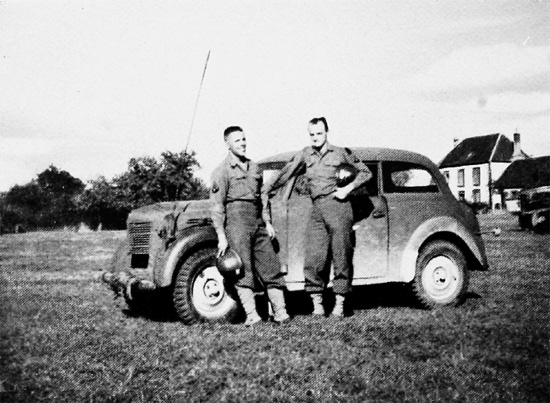
Medical Concentration Area, Senonches, France. Technicians Frederick E. Sittig and Lowell W. Rosenkjar with a captured vehicle, 9 September 1944.
The 41st Evac continued to support First US Army and more particularly V Corps, as well as the French Second Armored Division. Casualties from the Third Army were also received, though in smaller numbers. All of these units were in the vicinity of Sées and Argentan, France. Armored troops were moving so rapidly, however, that Evacuation Hospitals were unable to establish or maintain contact, but this was unnecessary for they were able to find them day and night and transfer ambulances full of patients. While at Sées (south of Argentan), some additional support was given by elements of a Medical Collecting Company, supplemented by 6 or 7 additional Nurses. The ANC Officers were soon recalled, however, for use at a General Hospital. The mobile X-Ray unit was still present and did good work. Mention should be made in the function of Sées and the great improvement it brought in the evacuation of patients. Prior to this, evacuation had always been a major problem whenever the hospital was nearly filled, and it had been difficult to maintain empty beds for the reception of post-operative patients. At Sées, it was decided by the unit’s CO that the records of patients to be evacuated should go directly to the Registrar’s Office. Whether the improvement in evacuation was due entirely to this change in procedure, or whether other factors were involved also, is not known; in any case, the speed of evacuation at Sées was noteworthy and many bed-hours were thus saved.
Laboratory Tests – 41st Evacuation Hospital During the month of August 1944 the Laboratory performed 458 urinalysis tests, 35 blood chemistry tests, 347 serology tests, 539 hematology tests, 39 bacteriology tests, and 41 parasitology tests. The Pharmacy filled 466 narcotic and 519 regular prescriptions; 314,200,000 units of penicillin and 638 pints of whole blood were used in the same month. The Dispensary gave 903 treatments.
It was here at Sées, France, that many members of the organization acted as blood donors. A total of 112,500cc of blood were collected from the hospital’s personnel and from some other units nearby to help the patients. During the month of August the Surgeon, First US Army, continued to control the unit’s vehicles and they were on the road most of the time hauling supplies and moving other units. Because of this extensive use, the vehicles began to show signs of lack of maintenance and the Motor Officer would deadline some of them, when he could get his hands on the trucks, in order to do the necessary maintenance and repair work. The Hospital was closed at 1800 hours, 26 August, and the next day all remaining patients were turned over to a Clearing Company Platoon, the Platoon taking over patients, equipment and tentage just as the 41st left. However, the Medical Officers continued to see their patients so long as the organization had not yet moved, and by the actual time of departure most of these patients had been disposed of. Although ready to move, the hospital remained in bivouac and in the rain until 31 August 1944.
By this time First and Third US Armies had advanced far beyond Paris and were in the north-eastern and eastern part of France. Other hospitals had moved forward and were operating in the field. Thus, there was no particular need for the 41st to set up farther forward. In the meantime it became increasingly difficult for the organization to secure rations and gasoline although the Army Surgeon wanted the 41st Evac Hosp up closer to the front. Pursuant to orders, the entire unit thus moved by infiltration to the Medical Concentration Area near Senonches, France on 31 August. The move followed no particular SOP with vehicles being furnished as they could be spared, as there were only 4 organic trucks left. The move was completed satisfactorily, however, and the new site proved well adapted to the purpose for which it had been selected. While in bivouac, the time was spent in working over equipment, repairs, rest and recreation. There were daily games of softball, football and volleyball. Many Officers, Nurses, and Enlisted Men took hikes about the countryside, visited the nearby town of Senonches, and other hospital units, many of them being within a three or four-mile radius. During the 10 days there, every member of the unit had an opportunity to visit Paris and most of the members of the organization took full advantage of this opportunity. The time passed fairly rapidly and when the 41st was needed once more, everybody had had a good rest and was ready to go to work again.
All of the hospital units experienced considerable difficulty in getting away from Senonches and the organization was no exception. The 41st Evac was ordered to move to La Capelle, France, and to go into bivouac there, but the move was to be made when and if transportation became available. As trucks gradually arrived, they were loaded and held. It required three days for sufficient vehicles to arrive, so the move was made by infiltration, some trucks departing 8 September, some 9 September, and the remainder on 10 September 1944.
Belgium:
The equipment was not unloaded at La Capelle, France, however, as the advance group had received orders that the unit proceed to Hannut, Belgium, a distance of over 200 miles from Senonches, France. This was quite a move, frought with difficulties, but the morale and spirit of the unit remained excellent and they arrived at Hannut in good order. The Hospital opened at 0800 on 12 September 1944. There was no evidence that the Germans had been in that part of Belgium at all; in fact, the 41st was the first American unit in the vicinity, and the men were hailed as conquering heroes. There was no need for clearing the area of mines, for people were walking across the grounds and had been doing so for some time. It was difficult to find a suitable site to set up the installation for most of the fields were in cultivation. The one selected was too small for all elements of the hospital, so the Officers’ tents and Motor Pool had to be placed some distance from the hospital proper. There was no particular difficulty in erecting the various elements of the Hospital, except that there were a number of visitors around watching the proceedings, a condition which was destined to get much worse as time went by. The German Prisoners of War had been previously returned to the PW enclosure on orders from the Surgeon, First US Army as it was not believed desirable to have them work in medical units so near to the German border. During the stay at Hannut, Belgium, 2 German soldiers who had been cut off from their unit on the way back to Germany surrendered to the guards of the area and were put to work in the kitchen, much to the amusement of the local Belgian population. The function and handling of patients at this site was entirely different from that at Sées. The patients were fresh battle casualties and consisted mostly of American soldiers with a sprinkling of civilians and a few German PWs. There was a gradual increase in the number of admissions, but the daily receiving rate seldom exceeded 105. The weather was not bad at all, even though the nights were cold and there was some rain. The 41st Evacuation Hospital was closed for admission of casualties at 1800 hours, 17 September 1944.
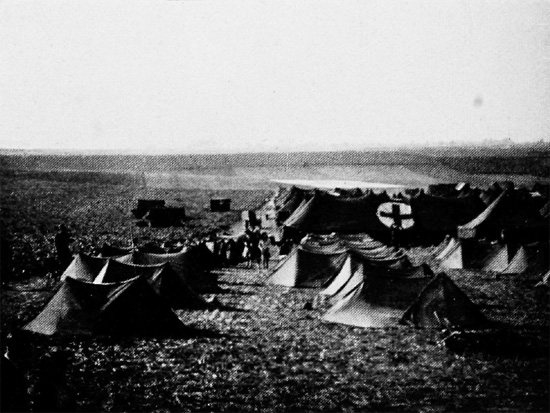
Detachment of Patients area at Hannut, Belgium, 12 September 1944. Enlisted personnel are still housed in pup tents.
By far the outstanding features of this period were the intense interest, evident friendliness and gratitude of the people in the surrounding communities. The Hospital was regularly swamped with gifts of eggs, bread, tomatoes, wine, potatoes and almost anything else that the people had. They desired nothing in return, stating that they remembered the American generosity to the Belgians in the Great War. So far as the organization was concerned, they won their point, for the men and women of the 41st Evac were never more royally received, or fêted. Fortunately, this did not interfere with the organization’s operation. Many members of the personnel were thus able to visit local homes and break the monotony of living under combat conditions. The Hospital mainly supported XIX Corps, First US Army during this period, this Corps attacking the Germans at the northern portion of the front and generally advancing towards Liège, Belgium, Maastricht and Venlo, Holland. Casualties were not heavy, although there was some severe fighting; nor were the casualties of a particularly serious nature, the majority of them being lightly wounded. Patients were received soon after being wounded so they were in much better condition for immediate surgery. Also, there were two Field Hospital units in front of the 41st which reduced the number of seriously wounded casualties admitted. There were no other Evacuation Hospitals in this sector, and therefore the 41st received all casualties from XIX Corps during this period. One Medical Collecting Company continued to support the organization and two surgical teams from the 45th Evacuation Hospital worked with them for three days, but were recalled two days later. Major Thomas E. Wyatt, MC, rejoined the unit. Captain Kramer and his mobile X-Ray unit continued to operate with the unit until 20 September, at which time he was ordered to another sector of the front. Approximately five Belgian civilians volunteered their services in any capacity and after a short investigation they were put to work in the hospital premises.
Station – Belgium – 41st Evacuation Hospital
Hannut – 12 September 1944 > 17 September 1944
During the action at Hannut, Belgium, a trial was made of a new method of utilizing the wards. This new method was, in brief, to use all wards of the hospital (except shock and medical) as combined pre-operative and post-operative wards. Pre-operative patients were to be admitted as follows: high-priority cases to Wards 1, 2, 4 and 5; low-priority cases to Wards 8, and 7; belly and chest cases to Ward 6. As the patients went to surgery, they were to be returned post-operatively to the same bed and ward which they occupied prior to operation. Ward 3 was kept in reserve for non-transportable post-operatives from shock and elsewhere.
The object of this plan was to provide a larger number of pre-operative beds. Previous experience had shown that the system of designating certain wards for pre-ops, and other for post-ops did not provide an adequate number of pre-operative beds to absorb the deluge of casualties received during the first 30 – 40 hours of operation so there always developed an acute shortage of pre-operative beds while post-operative beds lay fallow, awaiting patients. The circumstances for which this plan was designed did not materialize in the action during which it was tried. Instead of receiving a very large number of casualties within a short period the hospital received only a steady trickle of casualties and never did receive a large number. As a result, the plan was not adequately tried. However, a considerable objection to this new method was raised by the Nurses, the ward personnel, and the Chief of Surgery. The Nurses and aidmen felt that their management of the wards was complicated by having both pre-operative and post-operative patients, and the Chief of Surgery experienced more difficulty in executing triage of his patients. For these reasons, it was decided not to give this method any further trial and it was abandoned after the action at Hannut, Belgium. Along with the rest of the organization stationed at Hannut, the Laboratory, Pharmacy and Dispensary were not rushed a great deal.
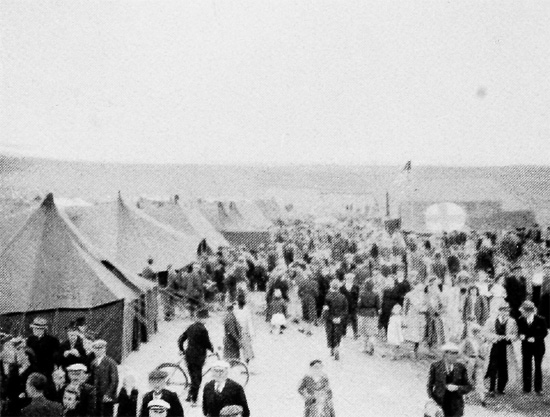
“Open Doors” at the 41st Evacuation Hospital, Hannut, Belgium, 15 September 1944.
Laboratory Tests – 41st Evacuation Hospital While stationed at Hannut, the Laboratory performed 571 tests of various types and the Laboratory Officer, Captain Lester E. Shapiro, performed 12 autopsies. In the Dispensary, 989 out-patients were treated and large numbers of immunization shots given to a number of American units in the vicinity. The Pharmacy filled 513 prescriptions in this period.
In the Supply Department, a few of the difficulties were met and mastered. In general, the supply situation was excellent, although at times it was far more difficult to procure certain supplies than it had been before. This was probably due to the frequent rains and rapid advances, making the journey to the depots longer and arduous. The procurement of medical supplies however proved much better and easier than the supplies of other services, such as Quartermaster and Ordnance. Clothing, soap and stationary were at one time almost unavailable.
No unusual difficulties were encountered during the month in the X-Ray Department, although it was regrettable to see the mobile unit depart for another unit, but all the organization’s own equipment was now functioning well and the volume of work was such that the personnel could handle it all with relative ease. At this location, this department made 719 X-Ray examinations on a total of 60% of the patients. The Surgeon, First US Army, continued to control transportation. In fact, with the exception of 5 vehicles, all trucks and drivers were placed on DS with the 68th Medical Group, and had been for three weeks, used for moving supplies and medical units. This arrangement was not at all satisfactory since it made maintenance of the trucks practically impossible.
Records of the Receiving Department indicate that there were 1,194 total admissions at Hannut, Belgium, of which 1,111 were American, 56 were enemy, 10 were Allied, and 17 were civilian. Prisoners were given sulfadiazine orally, tetanus anti-toxin, and wounds dressed when indicated and evacuated to the rear when they were considered transportable. Because of the fact that admissions were not too heavy, both admissions and dispositions proceeded without difficulty. On 22 September, the 3 remaining patients were moved to a small wall tent, a special detachment designated to care for them while the remainder of the hospital packed and made ready for movement. It had been raining continuously for three days and the taking down of the tents was somewhat complicated, but by the time the necessary transportation had arrived, all the tents were ready to be loaded and moved to the new location.
Holland:
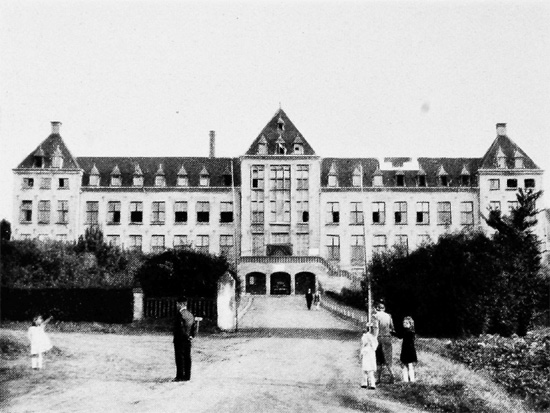
41st Evacuation Hospital building (Dutch Reformatory School), at Heer, (Maastricht), Holland, where the organization was established from 24 September 1944 to 2 March 1945.
Following instructions received from the Army Surgeon a reconnaissance was made in the vicinity of Heer, (near Maastricht –ed) Holland, in an effort to find a field large enough and suitable for the new setup. The reconnaissance party was unable to find a suitable spot, so they looked over the Catholic Reformatory building near Heer as a last resort. This site was decided upon, approved by the Surgeon and the unit ordered to move, although the 41st could only scrape up 5 trucks for the move. Begging and borrowing other trucks, the unit finally moved on 23 September 1944 (the last move actually made during 1944).
The 41st Evacuation Hospital officially opened at 1200 hours, 24 September 1944, at Heer, Holland, and continued to serve XIX Corps, this Corps occupying a north-south line running generally through Heerlen, Holland. The medical facility was very near the front, initially, and the buildings shook day and night from explosions of bombs and firing of large artillery guns. There was not a large influx of patients at first, but a gradual increase in the daily admission rate was to follow. Handling of patients in the building was not only much easier than in the tents, but they were much more comfortable inside the building which provided better protection and more comfort. The main building was particularly well adapted to the function of an Evacuation Hospital, in that there were four large wards on the ground floor which could handle all litter cases. From 24 September to 29 September 1944, the Operative Section’s backlog for the month reached its highest peak of approximately 15 patients. On 30 September, the influx of patients rapidly increased and the backlog reached 106 cases. Auxiliary Surgical Teams headed by Major Wood and Major Higgenbottom were assigned to duty. Major Haynes, Neuro-Surgical Consultant, First United States Army, was re-attached for a certain period. Many of the injuries were of an extremely severe nature. The major difficulty, insofar as the Ward Section was concerned, had to do with the architectural plan of the building, in that most of the rooms available for use as wards were rather small, accommodating only 20 cots; this fact necessitating the scattering of ward equipment among the numerous wards and increasing the demands for ward personnel. During the month of September, 24 Medical and Surgical Technicians were placed on detached service for an indefinite period with the 414th Convalescent Hospital, but they were re-called when they were badly needed at Heer.
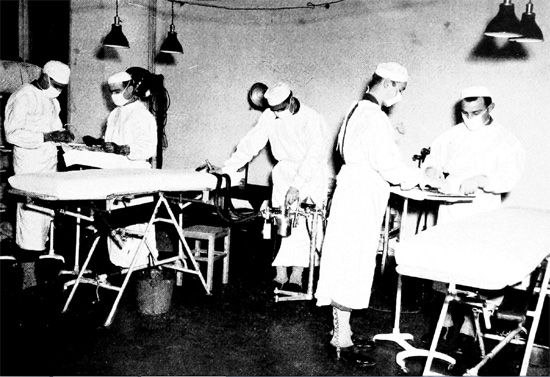
View of Operating Room No. 1, Heer, Holland.
Ten of the unit’s truck drivers were placed on DS during the month to the 68th Medical Group for an indefinite period. On 1 October 1944 the Hospital was well established in the main building of the former Dutch Reformatory for boys at Heer, near Maastricht, Holland. The main building had been found to be very satisfactory and perfectly adequate for a 400-bed Evacuation Hospital. There were some problems to solve in the way of plumbing, water supply, electricity, heating and cooking, but they were not insurmountable, however, and the organization was assisted considerably by Father Hovers, the Catholic Rector, who fully cooperated with the hospital unit in every way possible. Soon after the move to the new location a number of female camp followers started coming in and set up in some caves nearby, causing trouble until the 41st secured the services of some Dutch guards. These guards corrected the matter quickly and started patrolling the hospital area well.
It was during this period that the Siegfried Line came under attack, and resulting Allied casualties were heavy. The backlog of surgery reached its greatest peak on 1 and 2 October, each day reaching the level of 184 and more. Because of the tremendous influx of patients and the severity of the type of wounds, two additional Auxiliary Surgical Teams were attached for support. With this extra help the output of the Operative Section was greatly increased, reaching its peak of 143 processed through the OR in 24 hours on 4 October 1944. The average output of this section up to 9 October was greater than the inflow of patients with an average daily output of approximately 100. The Auxiliary Surgical Team of Major Peyton and the one of Major Higgenbottom were relieved from duty on 6 October. They were replaced the following day with an Auxiliary Surgical Team headed by Major Graves, who reported for duty the same day. On 9 October, two more surgical teams pertaining to the 111th Evacuation Hospital (teams commanded by Major McGuire and Captain Richman) were attached to the unit for training in war surgery, and remained with the 41st until 21 October 1944, at which time they were replaced by two other teams headed by Major Zeracke and Captain Jakeman.
During this period of operations there was a change in personnel of the Receiving Department. Staff Sergeant Jack DeGregario, who was awaiting transportation back to his unit, the 90th Infantry Division, was returned. Private Edward Fore, 1st Infantry Division, working in Property Exchange, was also returned to his outfit. Captain Charles R. Solbrig, was relieved of his duties as assistant Receiving and Evacuation Officer, and replaced by Captain George Nenner. Early October seven Enlisted Men were placed in the hospital due to colds and diarrhea, but they all recovered quickly.

First unit formation since D-Day, 15 November 1944, Heer, Holland. Awards are presented by Colonel William E. Shambora, Surgeon, Ninth US Army. From L to R: Captain Stefan S. Fajans, MC; First Lieutenant Elizabeth C. Hogan, ANC; Captain Miles J. Gullickson, MC; and Colonel W. E. Shambora.
The following Nurses were transferred out of the organization: Second Lieutenant Mary M. Jackson, to the 50th General Hospital for duty on 10 October 1944; Second Lieutenant Ruth E. Collins, to the 13th Field Hospital for duty on 19 October 1944; and Second Lieutenant Frances Davis, to the 15th General Hospital, Detachment of Patients. Two Nurses from the 3d Auxiliary Surgical Group, who had been attached since the 41st opened on 14 June 1944, First Lieutenants Mary Marsic and Clara H. Hubbard, returned to their Headquarters on 18 October 1944. Personnel from the 463d Medical Collecting Company, 501st Medical Collecting Company and 621st Medical Clearing Company were assigned to the Hospital for duty. Ambulance service for evacuation was furnished by the 463d Medical Collecting Company. Night evacuation was necessary at times, but was generally unsatisfactory, due particularly to bad weather conditions.
Station – Holland – 41st Evacuation Hospital
Heer – 24 September 1944 > 2 March 1945
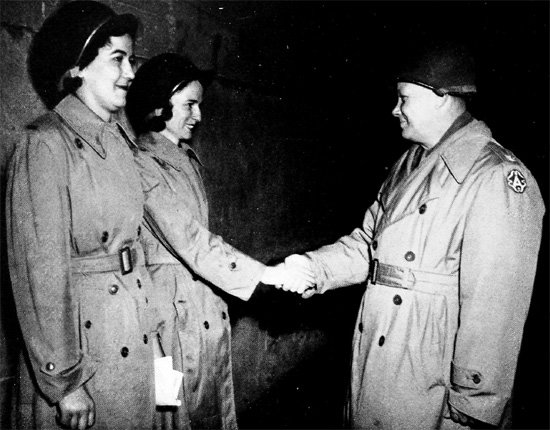
15 November 1944, awards ceremony. From L to R: First Lieutenants Margaret C. Denton and Agnes J. Allen, both ANC Officers from Tennessee.
During the interval of 1 October through 22 October 1944, there were a number of changes in the X-Ray Department worth reporting. The flow of patients was so great in the first days of function that again it became necessary to call for a mobile X-Ray unit to supplement the current equipment. Worth mentioning is the fact that when the Surgical Section of the Hospital expanded, the number of surgical teams available were often so great that the prospect of having the X-Ray Department finish films for eight tables working simultaneously became a practical impossibility, particularly with the sudden onrush of patients. Even the additional help provided by the mobile unit could not overcome the disproportion of two or three X-Ray machines trying to satisfy eight surgical tables. Since there was no satisfactory arrangement for the function of the mobile X-Ray unit as a separate group, due to lack of space for their setup, the personnel were incorporated into the X-Ray Department in such a manner that two machines were kept in constant use and two expert technicians handled the severe, complicated cases with great speed and efficiency, thus increasing comfort to the patient. One great concern was the safety factor which had to be observed in all X-Ray work. It had been established that no one should be subjected to more than 0.025 Roentgens daily or more than 1.25 Roentgens per week. It was possible for the X-Ray Department to calculate exposure to the body through the scatter of secondary irradiation. Functioning, however, over a great period of time it was imperative that rest periods, with outdoor atmosphere be enforced to counteract the insidious nature of the accumulating X-Rays. Protective devices such as leaded aprons and stands slowed work down considerably and were most uncomfortable if worn for more than a short period of time. The indoor nature of the X-Ray work increased the danger factors and every precaution was therefore observed.
A unique opportunity presented itself when some captured German X-Ray equipment was obtained. The films were “Colorless Base” compared to American “Blue Base” film and found great favor with the unit’s technicians, although the cassettes were not as well constructed as the American types and the screens were not nearly as fast or sensitive, requiring considerably longer exposures. Great quantities of Roentgen paper were obtained and tried with moderate success, due probably to the lack of experience with this medium. It was, unquestionably, far inferior at its best, to US film. Interesting however, were the hangers, cleverly made of plastic, light in weight, flexible and cheap. Among the film found there was no evidence of the use of a grid. The machine used was capable of far greater speed and higher milliamperage than the unit’s own field unit. The greatest advantage accruing to the X-Ray department during October was the acquisition of two new control panels which permitted function with either 110 or 220 voltage. The use of community electric current instead of generator current had obvious advantages.
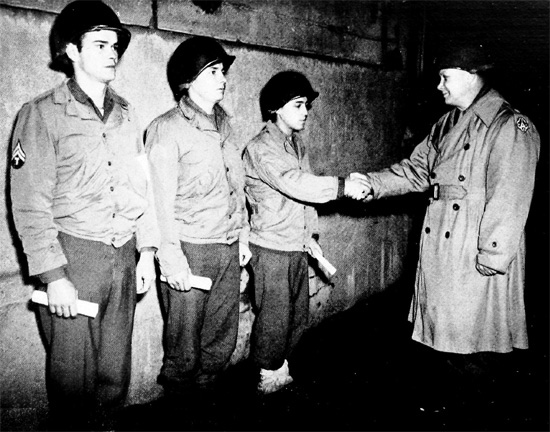
15 November 1944, awards ceremony. From L to R: Technician 5th Grade George J. Grauel; Private Ralph E. Cook; and Private Joseph Miceli.
As soon as the organization’s trucks were released from the 68th Medical Group a 6,000-mile maintenance inspection was started, as most of the trucks had been driven 6,000 to 7,000 miles, without any second echelon maintenance. The driver’s maintenance (first echelon) was performed. After the first and second echelon maintenance were over all the trucks had to be moved to the third echelon shops (run by Ordnance Companies) at which time they returned to excellent running condition. By 22 October more inspections took place; one 6,000-mile maintenance and two 1,000-mile inspections. The availability of spare parts had become very acute at the Ordnance Depots. This situation was relieved considerably by procuring used parts from wrecked vehicles collected in the Ordnance Collecting Points. This was done as much as possible to keep the trucks in the very best condition, as they were indispensable. The changing from summer grade oil (SAE No. 30) to winter grade (SAE No. 10) as prescribed in Letter, Headquarters, First United States Army, dated 8 October 1944, was complied with as soon as the supply of summer grade oil was consumed.
Laboratory Tests – 41st Evacuation Hospital The Laboratory completed 1,618 tests of various kinds during the month of October 1944. The Pharmacy filled 796 narcotic and regular prescriptions, and 288,700,000 units of penicillin were used during the above period.
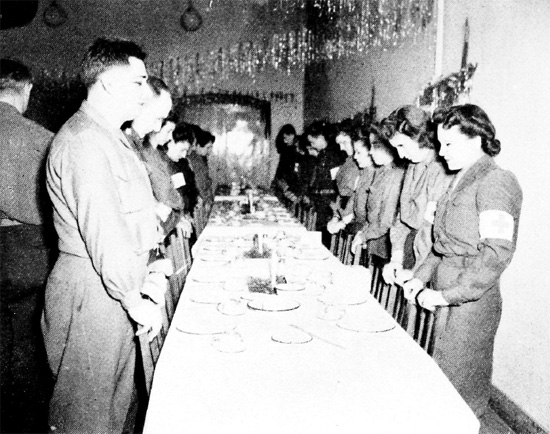
Christmas Day 1944, Heer, Holland. Scene taken in Officers’ Mess.
As from 1200 hours, 22 October 1944, the unit was relieved of assignment to the First United States Army and assigned to Ninth US Army, which had just arrived in this sector from the Brest Peninsula. During the period Ninth Army units moved into their sector in Holland and made some progress in their initial offensive. The southern boundary was generally from a point several miles north of Liège (Belgium), through Aachen and Cologne (Germany); the northern boundary from a point approximately five miles north of Maastricht (Holland), through Geilenkirchen and Düsseldorf (Germany), while the front was on a north-south line just east of Aachen (Germany) and between these two boundaries. The British took over the area generally north of Maastricht and west of the Maas River (Holland). There was one limited Allied offensive during the period 15 November to 1 December 1944 and the front line was advanced from between five and fifteen miles in various points. The 41st and the 91st Evacuation Hospitals were the only two hospitals in the sector, initially, but soon the 105th Evacuation opened, followed by the 111th and still later, the 108th Evacuation Hospital.
On 22 October there were 110 patients in the Hospital. As First US Army medical units were released, the Evacuation Hospitals received all types of patients from Field Hospitals and Clearing Stations, including VD patients, combat exhaustion cases, contagious diseases, SIWs, and malaria cases, and they operated on a 21-day evacuation policy. As a result, the hospital census mounted rapidly and the condition was only relieved when another disposition was made of the above types of cases and the evacuation policy reduced to 10 days. From 22 October to 18 November 1944 the average daily admission to the hospital was 100. As from 17 October 1944, admissions jumped to 269, and remained over 100 daily for several days, then gradually increased once more to approximately 500 per day for the remainder of the month. The manner in which patients were received at the hospital from other installations operated smoothly during the entire time. During the push, patients were received all night long, the number gradually dropping off after midnight. Patients disposed off were either evacuated to Communications Zone Hospitals at Liège (Belgium) by the 571st Motor Ambulance Company; transferred to other Ninth US Army medical installations by the 463d Medical Collecting Company, or removed to designated hospitals for the treatment of civilians. The evacuation was continuous day and night when there was a need for it. There was no particular difficulty involved, as ambulances were allowed to use full vehicle lights most of the way. There seemed to be some confusion at the General Hospitals, initially, for on numerous occasions ambulance drivers reported being sent to one or more General Hospitals before finally being able to dispose of their patients. With the assistance of Army Engineers, a winterized basic section of a 400-bed Evacuation Hospital was built nearby and tents pitched. It was undoubtedly an improvement and much better than having to operate in mud and rain, although most of those who inspected the new setup were not too enthusiastic over it.
By the morning of 29 October there were slightly more than 300 patients in the 41st Evac, and the only bed space available for pre-operative cases consisted of Wards 1 and 2. On this day there was a flurry of activity at the front, and wounded casualties admitted to the Hospital showed a sharp increase in numbers. For a time it appeared as though the organization would experience some difficulties because of the immobilization of 300 beds by medical and surgical non-operative cases. However, the Surgeon’s Office, Ninth US Army, opened the 105th Evacuation Hospital and used it as a medical Holding Unit starting at 1600 hours, 29 October 1944, and the 41st immediately transferred 60 medical convalescent cases to the 105th. This reduction of the census, further augmented by regular evacuation, made it possible to clear 40 beds in Ward 9 and designate this ward for low-priority pre-operative cases while reserving Wards 1 and 2 for high-priority cases. The unit was required to admit and care for VD cases as from 23 October through 1 November. During this time 16 cases of acute gonorrhea and six cases of primary syphilis were diagnosed and treated. An interesting observation was made with regard to the treatment of gonorrhea. It was found that the treatment as directed in Circular Letter No. 107, Office of the Chief Surgeon, ETOUSA, consisting of 100,000 units of penicillin in four subsequent doses administered at three-hour intervals, failed to cure approximately 50% of the cases, as evidenced by persistence of discharge and gonococci in the smear. A different procedure was therefore adopted by promptly taking a routine smear after the fourth dose of penicillin and whenever this smear was positive, it was decided to simply continue the treatment in the same dosage for 12 more hours. After this amount of treatment, no smears remained positive for gonococci and there was a cessation of discharge in all instances. This point was considered worthy of mention, because Circular Letter No. 107 suggested that if the first 100,000 units of penicillin failed to cure, the patient should be given a second course of treatment over another period of 24 hours. The modification of this procedure resulted in a 100% cure and a saving of 100,000 units of penicillin; including an extra saving of hospital bed-hours. There were 210 beds on the second floor wards and more bed space was available downstairs, in Wards 7, 8 and 9, but throughout the week an effort was made to keep these wards relatively clear in anticipation of the expected drive into Germany. The disposition of these patients was considerably complicated by the closing of the 105th Evac Hosp which had been operating as a holding hospital, and to which the 41st Evac had been transferring a large number of patients with minor diseases. Coincidently with the closing of the 105th Evac to this type of patients, the organization received orders to reduce the census and “clear the decks” for battle casualties. Thus placed upon the horns of a dilemma, the 41st with the approval of the Surgeon’s Office, Ninth US Army, adopted a 3-day policy for medical patients; those who would be ready for duty within three days being held in the hospital for treatment while all others were, out of necessity, evacuated.
The Medical Officer personnel of the Ward Section was bolstered, in anticipation of an incoming rush of battle casualties, by the assignment to the section of Captain James T. Williams of the unit and Captain Waufman of the 621st Medical Clearing Company.

25 December 1944, Heer, Holland. Distribution of Christmas packages to patients.
The new Surgical Consultants, Lieutenant Colonel Gordon K. Smith and Lieutenant Colonel John Manning, were extremely co-operative and helpful; they made many informal visits during which they rendered valuable aid, through their willingness to discuss internal problems, and in assisting in reaching satisfactory solutions. It was felt that this type of consultation enabled the consultant to better understand any local problems and, in turn, to better advise medical units regarding both administrative and professional matters. Until 16 November 1944 the rate of admissions was very much slowing down, and surgery was able, without difficulty, to reduce the surgical backlog to zero daily. With the advent of the Ninth United States Army’s forward push on 16 November, the influx of patients began to rapidly increase late in the afternoon and, in spite of the fact that 72 operations were performed on 17 November alone, the backlog reached a peak of 103. At this time the organization was operating with its own personnel plus one orthopedic, one general surgical, and one maxillo-facial surgical team from the 5th Auxiliary Surgical Group. As the types of injuries received were severe, they affected the total daily output of the operative section considerably. On 18 November 1944, the rate of admissions continued to be heavy. Eighty-one major surgical procedures were performed and the backlog reached a peak of 133. It was at this time that the low priority cases were triaged and minor surgical wounds, which would not receive definitive treatment at this Hospital within a period of 24 hours, were transferred to a General Hospital. On this date two additional Auxiliary Surgical Teams, headed by Major Romack and Major Johnson, reported for duty. The backlog was completely overcome by 19 November. Following receipt of VO from Lieutenant Colonel J. Manning, Orthopedic Consultant, Ninth United States Army, the policy was established that all fractured femora, regardless of level, would be immobilized by means of a Tobruk splint. The type of Tobruk splint to be used was worked out and demonstrated at the hospital by the Consultant Officer himself. The use of this splint proved to be a great help in time saving alone. Patients so treated left the facility very comfortable and, in so far as the personnel were able to ascertain, transported well. It was necessary at this time to enlarge the medical side of the hospital considerably, and at the expense of surgical beds, and also to shift much of the Ward Officer staff from surgical to medical wards.
There was a crisis precipitated by the arrest of evacuation caused by the closing of General Hospitals in Liège, Belgium, on the morning of Friday, 24 November 1944. Upon receipt of this message, it became apparent that if the day’s admissions equalled those of the preceding 232 days, a rapid expansion of the total bed capacity was essential. The Commanding Officer acted promptly and energetically and secured the services of a number of Enlisted Men from the 620th Medical Clearing Company. Those men, working with the Utilities personnel, raised 6 ward tents in the courtyards adjacent to the building, thus adding 120 beds to the hospital and increasing the total capacity over 600 beds. As it turned out, admissions were not as heavy as expected and late in the day it became possible to evacuate 75 cases to Company C, 95th Medical Gas Treatment Battalion, so that it was not necessary to make use of the extra emergency facilities. During this time there was a sharp increase in the number of cases of trenchfoot admitted. It was decided to establish a separate ward for these cases and a tent in the courtyard (Ward 11) was set up for this purpose. A routine procedure was instituted in accordance with Memorandum No. 125, Headquarters, Ninth US Army; the essential feature of this procedure being rapid evacuation of cases of trenchfoot. As soon as possible after admission, each case was examined and the records promptly forwarded for evacuation. Treatment was minimal, consisting of the following points: all cases were handled as litter patients; routine administration of sulfadiazine was applied prophylactically; gentle cleansing of the feet was essential; use of light cotton “wisps” between the toes was recommended; leaving the feet exposed and uncovered was preferred. By far the greater percentage of cases of trenchfoot seen during this time were classified as mild and it was observed that about half were still in the pre-hyperemic stage, while the others were admitted in the reactive or hyperemic stage. Very few cases exhibited ecchymosis and some exhibited blebs.
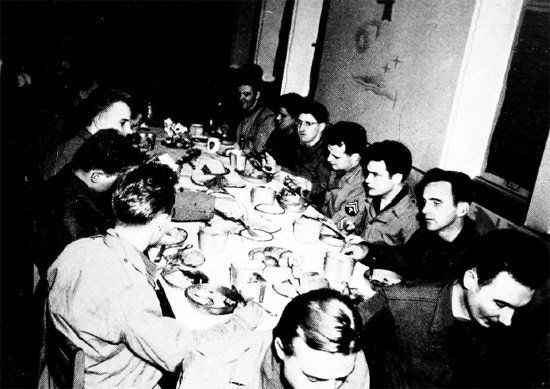
Christmas Day 1944, Heer, Holland. Dinner in the Enlisted Men’s Mess.
Laboratory Tests – 41st Evacuation Hospital During the past period the Laboratory performed 1,203 various tests. The Pharmacy used 535 units of whole blood, 512,600,000 units of penicillin and filled 984 regular and 520 narcotic prescriptions. The Dispensary treated 1,230 out-patients.
Captain Martha Smith, ANC, and nine of her 5th Auxiliary Surgical Group Nurses joined for quarters and rations for about a week when they first arrived in Holland. After they became settled in their own headquarters the following Nurses from the group were attached to this organization for temporary duty: First Lieutenant Olive L. Zimmer with a shock team; Second Lieutenants Lt. Rachel J. Otis, Mary Y. Kristof, Edna M. Grant, Elizabeth Suppers, Olga D. Raitanen, and Mary T. Koch with surgical teams.
The month of November 1944 brought some changes in the organization’s own ANC personnel. Three new Nurses reported for duty from the Ninth US Army Replacement Pool: Second Lieutenant Marjorie E. LaPalme, Second Lieutenant Marjorie B. Kent, on 14 November 1944 and Second Lieutenant Mildred M. Fitzpatrick on 24 November 1944. Two of the current ANC Officers left during the month: First Lieutenant Phyllis H. Richardson on 7 November as a patient, and First Lieutenant Katharin Dewey on 24 November 1944.
Second Lieutenants Doris V. Donofrio and Mary E. Buck were attached on DS from the Ninth US Army Replacement Pool while awaiting permanent assignments. First Lieutenant Mary E. Buck studied anesthesia under the able guidance of Captain Robert E. Eby, but it was expected that she would soon join the 108th Evacuation Hospital staff.
The Dental Clinic serviced a large number of patients, the majority of them being out-patients. In fact the number of out-patients was so great at the beginning of the month, that the clinic was unable to do more than a limited amount of restorative work, giving priority to emergency cases. Each man from the 41st organization was called in for a complete dental examination. If the person required work to be done, he was given the required attention and put in Class IV as quickly as possible. By the end of November 1944 every man had been called in and the required work completed. The Dental Section was visited twice by Colonel Eberley, Dental Surgeon, Ninth United States Army. The unit was about the only hospital in the Ninth US Army with a Dental X-Ray machine and for this reason a large number of patients were referred to it for dental examinations.
The Chaplain’s activities were expressed in various ways as he came in contact with the personnel and patients in the Hospital. He conducted 49 various religious services, held 384 conferences, gave special and prayerful attention to 76 seriously sick and dying, held 3 civilian services, gave 4 sex-lectures and dealt with 7 disciplinary cases. Chaplain William H. Barsh gave out 3,200 New Testaments, 500 Missals, 40 Rosaries and some 24 New Testaments in the German language to PW groups. Considerable time was spent in conferences with civilian priests, Army Chaplains and the Dutch Ministers.
When the unit was transferred to Ninth US Army, all contact with First United States Army installations was discontinued and the Supply Section dealt only with Ninth US Army Depots and Service units. Considerable confusion was experienced at first, since many of the new service units had not arrived and the ones already there were not fully set up to issue supplies, or do any repair work. The procedure for requisitioning supplies from Ninth Army Depots was quite different from that adopted by First US Army. It appeared to be more complicated and considerable time was consumed in preparing the required forms. For some unknown reason it was more difficult to procure supplies than it had ever been prior to that time. Also, the Medical Supply Depot was short of certain items that were critically needed for the proper functioning of the Hospital. Some essential items were deleted on requisitions as they were not available at the depot. These deficiencies were soon corrected, however.
In the meantime, the Optical Section of the Depot gave the unit excellent service. At the time of transfer sixty-nine prescriptions for glasses were left unfilled. These were delivered to the optical section, and they were filled in two days. Also, on many occasions repair work on glasses was completed at the time it was requested, even without formal request.
The loss of the Quartermaster Laundry Platoon did create some difficulty that was hard to overcome. Second Lieutenant Alfred Ettinger, QMC, and his men had been attached to the 41st back in England before the invasion of the continent and they had become intrinsic part of the unit. They provided excellent laundry service and everyone was sorry to see them go. Ninth United States Army did not attach laundry units to their hospitals, but arranged for hospitals to be provided with the necessary laundry service at larger Quartermaster Laundry installations in centrally-located places in the rear. This arrangement did not prove entirely satisfactory, although it worked in this manner for the remainder of the war.
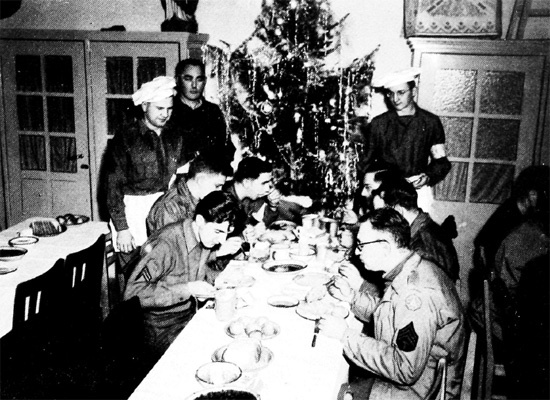
Christmas Day 1944, Heer, Holland. Christmas dinner in the Non-commissioned Officers’ Mess.
During the period 22 October to 30 November 1944, the X-Ray Department was supplemented by the mobile X-Ray unit on loan from the 5th Auxiliary Surgical Group. A total of 2,908 patients were x-rayed during the period. A protective device was constructed to be used by the Technicians, which deserves a description. It consisted of a steel rod bent into an inverted “L” shape. This was secured to the control panel and a lead apron hung over the horizontal arm, which was at about a five-foot level. This could be swung about its vertical axis in such a manner that it offered protection to the Technician, regardless of how he turned the machine, or tube. The advantage of the device was simplicity, practicability, and ease of construction.
During this period, the Utilities Department turned out a number of things to improve general setup. Seventy-five window panes were replaced, fifty new blackouts made, four switch boxes repaired for the OR and five main fuses replaced at transformers. The secondary fuses were replaced in the building and fifty light bulbs replaced. A generator and wiring was furnished for two USO shows. In addition, Utilities overhauled four generators each week, repaired four telephone lines, investigated and repaired two telephones, made three trays for the Laboratory, built a stage for USO shows, constructed wooden floors for two ward tents and one pyramidal tent, adjusted six gauges and cleaned four oxygen tanks in the operating section, repaired three steam valves for central heating, replaced twenty tiles on the roof of the building, repaired four lamps in the operating room, checked water pump and reservoir every day, built four new armboards for administering of Sodium Penthothal, cleaned and painted one 15 KW and one 5 KW generator, fired the boiler consuming eighty tons of coal, and shut twelve hundred and fifty doors in an effort to conserve precious heat and fuel. Lieutenant Colonel Clinton E. Adams supervised closing of all the doors in the hospital building.
Being short of the authorized T/O strength, the organization tried, through all available channels, to secure more men, but met with no success. The problem was partially solved by hiring 13 Dutch civilians and using them as litter bearers and technicians. They soon became proficient in their work and when the period of increased activity arrived they proved to be of immense help. The rest of the shortage in manpower was made up by greater effort on the part of the personnel. The situation was relieved toward the end of the period when a number of men from the 620th Medical Clearing Company were attached for duty. During this period, 9 Dutch guards were retained for security and traffic control. They did a fine job and deserved a lot of credit. Fifteen men pertaining to the organization were admitted to the hospital with minor ailments and two men underwent operations for appendicitis. Three cooks came from the 18th Replacement Depot. This brought the Mess Department up to full T/O strength.
From 27 October to 3 November there was an International Religious Orientation held in the Chapel of the 41st Evacuation Hospital. On 12 November, a Vocal Concert was gratefully offered to the patients and hospital staff by the St. Anthony Church Choir. The conductor was Martin Kokelkoren and the organist Willy Timmermans. Fourteen musical pauses were sung by the choir. Those who attended the concert praised it very much.
Disciplinary problems were not extraordinary, and despite the fact that there was one Special Courts-Martial and three Summary Courts-Martial, this was not interpreted as evidence of laxity in discipline or a let-down in general morale, as both remained high.
On 15 November 1944, at the first unit formation since D-Day, awards of twelve Bronze Stars, sixteen Certificates of Merit and seven Good Conduct Ribbons were made. It was an impressive ceremony and the presentations were made by Colonel William E. Shambora, Surgeon, Ninth US Army. The formation was held in the courtyard and over 200 Officers and Enlisted Men attended. After the formation the recipients of the awards were interviewed and photographed by war correspondents representing a great number of newspapers, including Associated Press and United Press. The interviews were recorded for re-broadcasting over the home-town radio stations. The day marked the end of the organization’s first year overseas and following the ceremony the Enlisted Men enjoyed a special supper with beer in a splendidly decorated mess hall. The Officers and Nurses had a buffet supper, with the Ninth Army Surgeon, members of his staff and approximately twenty-five members of the press as special guests.
Another ‘special’ day to be remembered was Thanksgiving Day. A fine menu was prepared by the Mess Department with turkey as the main dish and ice cream for dessert. Many compliments were heard on the excellence of the feast. The Mess Department did a fine job on this occasion. In the evening a short Thanksgiving service was held in the unit’s Chapel, with Chaplain W. H. Barsh presiding.
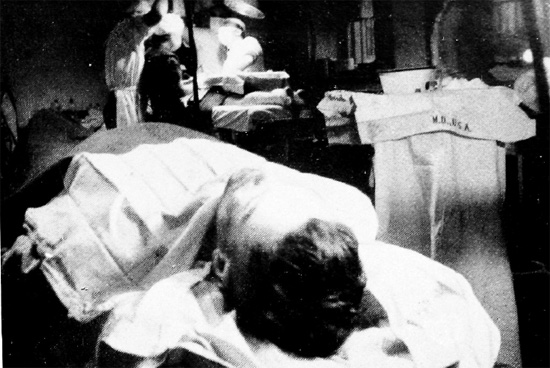
Scene of a maxillo-facial patient awaiting surgery. Heer, Holland, spring 1945.
Free time was made as pleasant as possible by the organization’s Special Services Department. Under First US Army regular access to materials made for an attractive program. Not knowing what to expect after the transfer to Ninth United States Army, the men and women were delighted to learn that the regular programs would not be hindered and, in some ways, even helped and supported. The first official USO show on the continent was organized in November 1944 and it was enthusiastically received. It was an excellent show, with three well- known stars performing: Frank McHugh, Mary Brian and June Clyde. They provided a hilarious evening for the organization and the men long talked about it. The attendance for this show was well over 500. There were other shows, mostly of the GI variety, that were very good, too.
Besides the USO shows, the Hospital ran a regular schedule of movies with two showings each evening, so that both day and night shifts had ample opportunity to attend. Movies were very popular with the organization and it was fortunate in being able to procure new films daily. The average daily attendance was 250 people. For those not caring to attend the shows, the day rooms were always available. They were furnished with comfortable chairs and desks, and the bookcases were stocked with the latest council books. The radio also attracted many men to this room. The day rooms were also used as a distributing point of Army Publications, such as “Yank” and “Stars and Stripes”. V-1 and V-2 “buzz-bombs” had been going over the hospital ever since it moved into the buildings at Heer, but none had landed any closer than three miles distant. The 41st did, however, receive a considerable number of casualties at times, as a result of these deadly weapons striking nearby towns. There was also sporadic aerial activity over the hospital and antiaircraft fire was intense at times, particularly at dusk.
From 22 October to 31 October 1944, there were 904 admissions to the Hospital with 12 deaths. There were 3,517 admissions with 25 deaths during the month of November. The greatest number of wounded received was on 17 November when 269 patients were admitted. The greatest number of dispositions on any one day was 231, on 19 November 1944. The next highest number of dispositions was on 18 November when 208 patients were evacuated. It had been evident, even for a casual observer that the front taken over by Ninth United States Army was being prepared for an offensive effort of major proportions. The number of troops, the narrow sector, along with other activities, all pointed to an early effort to cross the Roer River in the sector where the 41st Evac was stationed. Whatever they were, these plans were rudely upset by a major German offensive in the First US Army sector, lightly held at the time; the region: the Belgian Ardennes.
The Germans struck quickly and in force, on 16 December, taking the troops in the sector by surprise and making a considerable penetration. The offensive continued, with Spa, Belgium, as a local objective, with the major objective of capturing Liège and driving the Allies back across the Meuse River. The Germans did make considerable progress and established a bulge, the western tip of which reached the Meuse River at Dinant (they never went beyond Celles –ed), and formed a triangle with the base to the east, the base being about thirty-five miles across. However, First and Third US Armies rushed to the scene and limited the bulge both north and south, leaving the only pathway open to the west. This sort of “channelized” the enemy offensive and by the end of the year the Allies had things well in hand. In fact, it began to look as if the Germans had a “hot potato” on their hands, which everyone felt would eventually result in a major victory for the Allies.
Ninth US Army was fairly inactive during December insofar as real fighting was concerned, although considerable aid was given to the First US Army. In addition, the front along the Roer River was kept intact, from below Düren to the vicinity of Geilenkirchen, with German all counter-attacks being repulsed in this sector.
The 41st, 91st, and 111th Evacuation Hospitals functioned continuously during December 1944, but were only moderately active. The 105th Evacuation Hospital closed before Christmas and was alerted for possible duty with First US Army. The 24th and 100th Evacuation Hospitals were kept in reserve, although the 24th moved to Brand, Germany and opened on the last day of the month. The 100th was ready to open at Tongres, Belgium when the month ended.
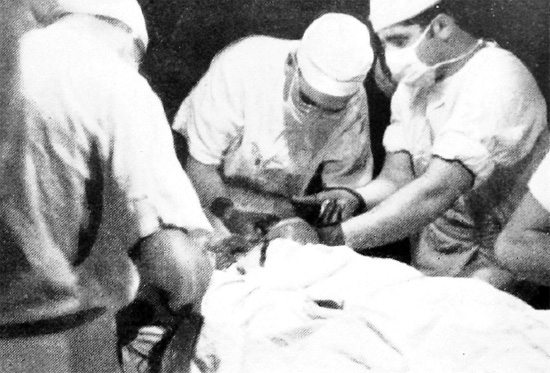
Medical personnel pertaining to the 5th Auxiliary Surgical Group at work in the 41st Evacuation Hospital’s premises, Heer, Holland
Stations – Evacuation Hospitals
24th Evacuation Hospital – Brand, Germany
41st Evacuation Hospital – Heer, Holland
100th Evacuation Hospital – Tongres, Belgium
105th Evacuation – Maastricht, Holland
108th Evacuation Hospital – Vaals, Holland
111th Evacuation Hospital – Heerlen, Holland
Unlike during the previous pushes, which were characterized by a sudden large influx of cases, admissions this time were more or less continuous, resulting in a backlog which at no time required more than twelve hours to overcome. On 3 December, 55 cases were operated and the backlog reduced to zero for the first time in five days. At no time during the remainder of the month was the backlog in excess of three hours and the greatest number of patients operated in any day for the remainder of the month was 41. With the advent of relative inactivity on the Ninth US Army front and a low rate of operative surgical admissions, evacuation policy was increased to 20 days, in order to hold more patients within the Army zone. As a result, the number of miscellaneous operative procedures during this month was greater than in any previous month reported.
The Ward Section lost the services of two Medical Officers; Captain Logan and Captain Levin of the 621st Medical Clearing Company, who had been on DS with the organization for some time. They were replaced by Captains Morton and Krettack and, inasmuch as the unit was not very busy during this period, the change in personnel caused no serious difficulty. There was also a considerable shifting about of Enlisted ward personnel during this time, as men from the 620th Medical Clearing Company were also relieved of duty with the Hospital and sent elsewhere; the twenty odd men thus lost were replaced, in part, by men of the 463d and 501st Medical Collecting Companies. Had the Hospital been receiving large numbers of casualties during these changes, matters would have been difficult. Fortunately, however, the number of daily admissions was not high. There was some decrease in the number of trenchfoot cases admitted during the first week of December as compared with the preceding week. During the last week in November, 151 cases had been admitted, while in the first week of December, they numbered 119. 11 December 1944, an order was received from the Surgeon’s Office, Ninth United States Army for all Evacuation Hospitals to operate on a longer evacuation policy. Under this new policy a patient could spend a 10-day period of hospitalization in the 41st Evac, plus 10 days in a Convalescent Hospital. The only patients evacuated were those who required more than three weeks to completely recover, or those whose condition demanded that they be evacuated to a General Hospital, in order to receive studies or treatment of a type not available in the hospital. In order to hold the greater number of patients expected with this policy, all upstairs wards were set aside for medical patients; Ward 9 was designated for non-operative surgical cases, and all wounded casualties were sent to Ward 2. Despite this liberal evacuation policy, the hospital census did not increase rapidly. This was due to the very small number of daily admissions during this particular period.

View of the 41st Evacuation Hospital’s Laboratory Department and personnel, Heer, Holland.
During the latter part of December 1944 there was an increase in the number of incoming patients, due to the closing of the 105th Evac. The greater portion of all admissions were medical or surgical cases, and the upstairs medical wards gradually filled up to approximately 70% capacity, at which level stabilization occurred; the same was true for the 55 beds of Ward 9, used for non-operative surgical disease cases. Throughout the time the patient census for the Hospital as a whole seemed to stabilize at a figure around 200. No events of unusual interest occurred in the Laboratory in the month of December. The supply situation eased up somewhat and, except for an occasional item, the needs in all departments were being well taken care of. The annual physical examination of the Officers and Nurses was conducted in December with excellent results.
Laboratory Tests – 41st Evacuation Hospital During the month of December 1944, the Laboratory performed 687 urinalysis tests, 794 hematology tests, 118 bacteriology tests, 38 parasitology tests, 236 blood chemistry tests, 133 serology tests; a grand total of 2,006 tests. The Pharmacy filled 521 regular and 446 narcotic prescriptions. 185 whole blood units and 166,000,000 penicillin units were used. The Dispensary treated 1,086 out-patients. 10 autopsies took place.
During the same month, the Supply Department encountered two problems. One was the difficulty in procuring parts to repair partially worn-out equipment which was in constant need. The second problem was individual clothing and equipment for patients and Enlisted personnel of the organization. It was the policy of the Ninth US Army Supply Departments to require that any unserviceable item be turned in for salvage and a credit slip obtained, which would then be presented with the new requisition. However, on various occasions, it was impossible to turn in the partially worn-out piece of equipment, as the item was in continuous use in the Hospital. Therefore, in order to get a replacement, a requisition had to be submitted to the Army Surgeon, requesting issue of another identical item over and above authorized allowances. All this involved a substantial loss of time, a trip to Army Headquarters, and the use of a vehicle. The problem of individual clothing and equipment was solved by conducting periodic salvage for Enlisted Men pertaining to the organization. The clothing for patients was controlled by having patients sign a receipt for all clothing issued to them before their departure.
From the time the 41st opened at Heer, Holland, on 23 September until 31 December 1944 over 6,000 patients were x-rayed. The number of re-studies numbered about 800, and approximately 16,000 X-Ray films were used. Since out-patient work was such an important part of the function of the X-Ray Department, a rather steady inflow of patients was the rule, even during periods when hospital admissions were at their lowest point.
Colonel K. Allen, Chief Radiological Consultant, ETOUSA visited the Hospital and inspected the X-Ray Department. After visiting he made a number of suggestions. These were carried out as completely as possible in accordance with his wishes and with an eye to the requirements for efficient function of the organization.
In December, twenty-two 1,000-mile maintenance inspections were made on the unit’s organic vehicles. The availability of vehicle spare parts was still critical. The parts that couldn’t be obtained were put on back order to be issued as soon as they became available. Tires were inspected on all vehicles regularly. They were changed around, rotated and properly matched so as to achieve the very best possible wear and service. Some tires had been sent in for replacement or repair. All drivers were given lectures on tire conservation. Inspections were made on all vehicles for proper tire maintenance and all deficiencies corrected. 15 unit vehicles were loaned to the 53d Field Hospital for movement from Kohleshind, to Stolberg, Germany.

Technician 5th Grade Howard W. Stamer, looks over his stock of Pharmaceuticals, Heer, Holland.
Fourteen members of the Nursing staff were given 48-hour leaves in Paris during December. All of the Nurses agreed that the long truck trip there and back was arduous, but the time in Paris was well worth the discomforts of the journey. During the month the Dental Clinic continued to function smoothly. The procedures consisted of treatment and removal of impacted third molars, and X-Rays. A fair number of restorations were inserted. Due to a shortage of Dental Chests No. 62 in the Ninth US Army, the one from the 41st Evac was requisitioned by the Dental Surgeon, Ninth US Army for re-issue to a Division dental clinic. Therefore, the dental clinic was unable to do any prosthetic work for quite some time. The 5th Auxiliary Surgical Group made a switch of personnel on their maxillo-facial team assigned to the Hospital, Major Eskin being replaced by Major Rankow, who was a former Instructor of Oral Surgery at the Columbia University Dental School (Major Rankow and Major Frank R. Pittman attended school together at the St. Louis School several years before they took the Army’s course on maxillo-facial surgery).
The Chaplain’s activities led into a variety of experiences different from any formerly encountered by him. Besides the various religious arrangements there were a number of personal demands on the part of both patients and some Enlisted Men. There were five preaching services with 763 people in attendance and fifty-six ward services with 1,408 men attending. The Chaplain’s Office distributed 942 Bibles and New Testaments and 2,400 pieces of religious literature. Every denomination was given proper and personal attention to their religious life. The Chaplain was called on to render personal service to the EM in keeping up their watches and in procuring various Christmas presents to be sent home to their loved ones. In December 1944, the Chaplain had fifty-four watches repaired for the Officers and Enlisted Men. He was also called upon to censor personal letters by a large group of individuals who did not wish to have their personal affairs known, or discussed. Probably one of the most difficult phases of the Chaplain’s service was in trying to solve some of the personal problems of the wounded soldiers. There were 115 such men who made various requests and asked for information concerning domestic affairs. Among the subjects were certain religious problems the men had neglected over all these years.
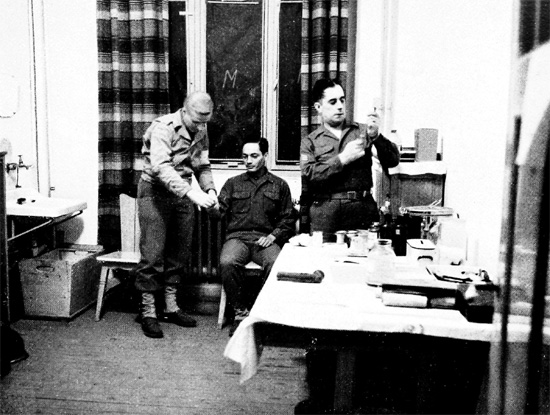
General view of the Out-Patients Department in Heer, Holland.
The Utilities Section fired the central heating plant, using approximately ninety tons of coal during the month. The personnel changed oil and checked generators daily; completely overhauled ten generators, which included valve grinding, cutting new gaskets, and regular maintenance work. They made five fire gongs, checked pump and reservoir daily, repaired leaks in water lines, repaired floors in kitchen, opened the main sewer and repaired stoves in the kitchen. They re-wired all the OR to facilitate changing from 220V to 110V, made and installed a new control box; set up a public address system for Christmas, replaced twenty-five light bulbs, repaired the unit’s movie projector; replaced nine fuses in three mains, installed one new transformer, arranged for lights for Christmas trees and made a new control board for the 15KW generator. They further constructed fifty-eight blackouts, repaired sixteen broken windows, seven broken doors, closed-in one jeep, made stands for fifteen Christmas trees, painted red and white signs for fifty fire points, and constructed two new boxes for X-Ray viewing and one for Supply.
The organization lost two men in December, who were transferred to the 102d Infantry Division, leaving it still with 5 men overstrength. There were 11 admissions to the Hospital from the Detachment of Patients; with most of these cases suffering from sore throats and miscellaneous injuries.
In December there were several successive nights of enemy aerial activity. It was soon evident that the lack of rest and increased tension resulting from this soon affected the temper of a number of Enlisted Men and Officers.
The period 8 to 14 December 1944 was characterized by marked quiescence on the combat front, and this was reflected in the work of the hospital. Admissions were lighter than any previous time in the hospitals history of active function, and only a small number of the patients were combat casualties, the majority being medical cases or non-operative surgical cases.
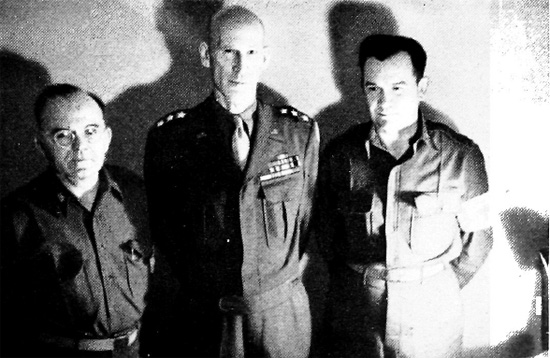
High brass visiting the 41st Evacuation Hospital. From L to R: Lieutenant Colonel Clinton E. Adams (XO); Lieutenant General William H. Simpson (CG Ninth US Army); and Colonel Joe Harrell (CO). Germany, January 1945.
On 10 December at 1400 hours, a jolly party was given for the men of the 41st in the Padre’s house by the Fathers of St. Gerlach. The program consisted of singing the “American National Anthem”, Christmas songs and others, performing pantomimes, followed by songs by the Dutch Farm Boys, and finally the “Dutch National Anthem”. During the session the Padres served beer and donuts to the American soldiers. Also on 8 December the Feast of the Immaculate Conception and a solemn High Mass were held in the Chapel with assistance from Father John A. Fector, Celebrant; Father Stephan P. Kenny, Deacon; and Father Morris N. Dummet, Sub-Deacon. Confessions were said before Father Godfrey Bollen. The Mass proper was in Gregorian Chant by the St. Joseph Choir of Holland. Religious observance was not neglected during Christmas and there was an overflow crowd at midnight mass on Christmas Eve, and almost everyone in the organization attended the Midnight Mass. The American Red Cross was able to secure a quantity of material for Christmas decoration. This material was distributed to the various departments which were then decorated by personnel and patients alike; as a result, the Hospital took on a very Christmas-like appearance. On 25 December 1944, Christmas Day, the Commanding Officer, Executive Officer, and the Principal Chief Nurse, judged the merits of the decorations of the several wards and selected Ward 22 as the best decorated place. A party was given in the ARC room that afternoon for the patients and personnel of the winning ward. During the day other small favors were arranged for the patients in the nature of Christmas celebrations. Presents supplied by the American Red Cross were distributed and a group of singers visited all wards performing Christmas carols and typical songs of the season. Lieutenant Lacey, the ARC Director, and Corporal Frederick E. Sittig, organist, did a splendid job in the preparation of a most effective and enjoyable program for the season. A choir of Dutch civilians also song carols for the patients. They sang in the halls and on the various wards and were followed by a Dutch civilian made up as St. Nicholas, with his daughter playing “Black Peter.” Black Peter distributed gifts to the sick and wounded men.
Christmas Dinner lacked nothing in quality or quantity and many compliments to this effect were heard from the Enlisted Men. The menu consisted of fruit cocktail, roast turkey, giblet gravy, sage dressing, mashed potatoes, buttered asparagus, carrot strips, cranberry jelly, apple pie, fruit, candy, coffee and ice cream. During dinner, some time was taken to announce the promotion of 33 Enlisted Men. This announcement, which came as a complete surprise, effectively substituted for Christmas gifts that would ordinarily have been received under normal circumstances. On Christmas Eve each man received a bottle of wine and a token of a souvenir gift to be received from the ARC at a later date. To further observe the holiday season, two very good GI shows were presented and several first rate movies shown. Also Special Services personnel continued to furnish whatever entertainment was available for recreation purposes. There was one USO show, two more GI shows and regular movies. Special Services further distributed the familiar Army publications, of which there were more than enough.
This period also saw the inauguration of an Orientation Program. One evening each week was set aside for this purpose and First Lieutenant Lacey of the 571st Motor Ambulance Company gave some excellent news and orientation talks. Each meeting lasted approximately an hour in duration and the attendance was close to one hundred percent.
The last act of special interest in this ‘festive’ period was the unit’s preparation for a sudden and unexpected move, a result of the German Ardennes offensive. All excess equipment was taken to St. Trond, Belgium, and stored in tents. Two Enlisted Men were left as guards. Personal equipment was packed and stored where it would be readily accessible. At the moment the entire organization was in a state of readiness to move, with nothing left except the shirts on the personnel’s backs.
No one in the 41st Evac Hosp did believe that the Germans could drive the Allies back across the Meuse, but no one was taking chances either. The Mail Department was flooded with Christmas parcels. By Christmas, the majority of packages had been received, but a few still were trickling in. Letters had been scarce, but with the package rush almost over it was anticipated that the receipt of first class mail would increase.
During the month of December there were 2,034 admissions to the Hospital which included 1,114 disease cases; 341 injured; 491 wounded; 38 Allied troops; 29 enemy troops and 21 civilians. There were 2,204 dispositions with 18 deaths.
On 11 December, Frankie Frisch, Dutch Leonard, Mel Oft and Bucky Walters paid a visit to the Hospital. They visited the wards, posed for pictures, autographed baseballs and “shot the breeze” with the boys. Another event of interest at this time was the wedding of Private Edward J. Waldron to First Lieutenant Betty A. Harris, ANC. During the afternoon of Christmas Day the Hospital received 68 Officers and EM from the 29th TAC, victims of food poisoning. Almost all of these men arrived in the hospital within the period of about an hour and were assimilated into Wards 9 and 10, overflowing into 7 and 8. Inevitably, a period of mild bedlam ensued, as sixty-eight men actively engaged in vomiting and passing frequent stools presented a problem to tax any group of medical personnel. However, the situation was adequately managed and was to be recorded in the unit’s history as only an ironical diversion that complicated an otherwise pleasant day. Some of these casualties of the “battle of Christmas” were severely ill at the time of admission, but all responded to therapy and made complete recoveries in due time.
As of 1 January 1945, Allied forces on the western front found themselves actively engaged in stemming the enemy counter-offensive in the First, Third and Seventh United States Army Sectors. During the month, however, American Forces recovered and, moving armor, infantry, and other supporting elements to the front lines, both north and south of the bulge, they soon stopped the German offensive. Then the American counter-offensive began, and within December 1944-January 1945, the Germans were driven back practically to the original line from which they started on 16 December 1944. During this period American troops, on the defensive for the first time on the continent, really proved their fighting ability; outnumbered and taken by surprise, they outfought and out-maneuvered the enemy. The great stand of the 101st Airborne Division at Bastogne, the defeat of the 2d German Panzer Division by the United States 2d Armored Division south of Liège and the rescue of besieged Bastogne by General Patton’s Third Army troops were highlights of the action. Field Marshal B. L. Montgomery threw British armor into the defense too, and their cooperation was of considerable help.
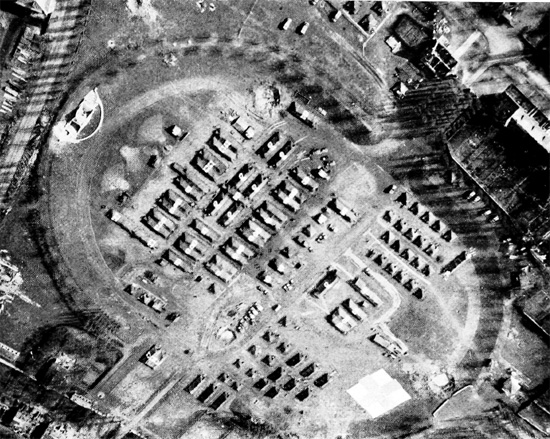
Aerial view of the 41st Evacuation Hospital setup at Rheydt, Germany, where it remained from 4 March 1945 to 2 April 1945.
There were many casualties on both sides. The Germans captured many US troops initially, many of which were ‘green’ soldiers, who had recently arrived in the European Theater. Their brutality, indiscriminate shooting of prisoners, shelling of, and firing upon medical installations and troops was proven on numerous occasions. Several Evacuation Hospitals were forced to move back, leaving their equipment to the Germans, and the personnel of one medical unit was captured, but within two hours all were retaken, so nothing was lost. As only a skeleton force remained on the Ninth US Army front, there was little activity, other than crossing of the Roer River by patrols. The Army did take over a greater section of the front, all the way down to Simerath, Germany. By the end of January, 21st Army Group was again regrouping its forces for an offensive, as soon as weather permitted. Heavy snows during the month and freezing weather most of the time hampered movements on the ground and in the air. There was no time during the month when snow was less than a foot deep. Insofar as the Ward Section was concerned, there were no happenings of particular note in this period. The work of the hospital continued to run along at what might accurately be described as a medium level, with daily admissions averaging between 50 and 75 patients, and the hospital census remaining between 100 and 175. The percentage of wounded patients was very low, with the bulk of them being medical and non-operative surgical cases. In the latter category the type of cases encountered continued to be pretty much the same as always. There was a moderate increase in the incidence of severe respiratory infections with fewer cases of simple nasopharyngitis and more cases of atypical and lobar pneumonia.
During the period 10 January to 18 January 1945, the tempo within the Hospital continued as for the preceding nine days. The Hospital was not rushed. There was an accumulation of non-transportable post-operative patients, which necessitated the opening of another ward for the care of that type of case. During this week the hospital admitted its second case of acute anterior poliomyelitis. This patient, like the one previously admitted, exhibited paralysis of the respiratory muscles at the time of admission. Colonel J. Harrell was able to make arrangements for the transfer of this patient to the British 108th General Hospital in Brussels, and the patient was removed to that hospital in the custody of Captain Stefan S. Fajans. The patient arrived in Brussels in fairly good condition, and was placed in a respirator and for a while he seemed to do well. However, a letter from the 108th General Hospital later stated that the patient had died after a few days in the respirator.
One medical condition encountered during this month was beginning to be somewhat of a problem. This was oropharyngeal diphtheria. One case of diphtheria was diagnosed positively by culture, but the significant and difficult aspect of these cases was that in neither one was the clinical picture at all typical of the type of diphtheria which was more common in America. Both of these patients exhibited throats without a typical membrane; the patients were not very sick, nor were they at all toxic. In brief, they could very well have been diagnosed as cases of tonsillitis and diphtheria missed altogether. Because of these experiences, it was made a routine policy on the medical wards to culture all throats showing any degree of inflammation, whether or not the appearance was such as to suggest diphtheria.
There was a considerable increase in the number of “injury” cases admitted, primarily as a result of motor vehicle accidents caused by inclement weather. The greatest backlog reached during the month was 18, and occurred on 10 January. On this date 47 cases were operated and constituted the largest number of cases operated during a single twenty-four hour period in January 1945. This sudden, but small, influx of patients was incident to an attack made by the 78th Infantry Division for the purpose of eliminating a few remaining pillboxes west of the Roer. During the month the organization was visited by Lieutenant Colonel Gordon K. Smith, Chief Surgical Consultant, Ninth US Army, and Lieutenant Colonel John Manning, Orthopedic Consultant, Ninth US Army. Helpful points were gained from their visits.
Laboratory Tests – 41st Evacuation Hospital The Laboratory performed 1,414 tests during the month of January 1945: 294 bacteriology tests, 95 blood chemistry tests, 527 hematology tests, 27 parasitology tests, 8 serology tests, and 436 urinalysis tests. The Pharmacy filled 338 regular and 190 narcotic prescriptions. The Hospital used 88 units of whole blood and 100,000,000 units of penicillin. The Dispensary treated 502 out-patients. The Pathologist performed 5 autopsies during the month.
The Dental Clinic started the month of January at a brisk pace and continued to be quite busy until 21 January. Many of the unit’s own personnel took advantage of the rest period to have their teeth checked and the necessary work done to keep them in good condition.
The Chaplain’s interest was devoted to the patients and to the organization. He conducted seven religious services, twenty-one ward services and had a special prayer with 38 seriously ill or dying patients. Much time was devoted to special conferences with the Enlisted Men. 182 individuals had either problems, or special matters of interest, which they wanted to discuss with the Chaplain. Twenty-two conferences were held with the Nurses and fifty-five with the Officers. The Chaplain’s Office sent out eight letters of condolences. The Officer distributed 661 New Testaments in English, 6 in German, and 2,000 pieces of religious literature. The Hospital held religious services twice daily for Catholics, at the regular time for the Jewish and every Sunday for the Protestants. Many favorable comments were expressed for the splendid organization giving the religious groups ample opportunity to participate in a worship service.
Utilities during the month of January checked the pump and reservoir daily, changed oil and checked generators daily, replaced valves and new gaskets on boilers, installed a new wash bowl in the Nurses’ quarters, repaired two main valves in the shower room, sharpened eighteen pair of scissors, repaired a frozen water pipe in the latrine opposite Ward 1, replaced five fuses, repaired the movie projector, rewired Ward 9 and 10 for movie projector use, installed a telephone for the ARC workers, replaced twenty light bulbs, replaced a break in the main line (electric), repaired light switches in the Officers’ Day Room, repaired twenty-five blackouts and twenty-three doors, changed screen for movies in Ward 9 and 10, repaired four windows and two closets for the Chief Nurse, made extensive repairs to the coal bin, built a ping-pong table for the Officers’ Day Room and fifteen food trays for the Mess, installed wooden floor in transportation tents, repaired the roof of the hospital building, replaced fifty-nine tiles and hung mirrors in the Officers’ Day Room.
The driver maintenance (first echelon) was performed daily on all vehicles. There were twenty-four 1,000-mile inspections and one 6,000-mile maintenance inspection made during the month. Two trucks were in the Ordnance MAM Company Shop (third echelon). One of these trucks was sent to Ordnance after being wrecked, necessitating a few minor repairs. Other trucks of the Transportation Department were in very satisfactory operating condition. There was one inspection made by Army Ordnance. Two trucks were inspected and showed no deficiencies. The records were well kept and in good condition, and they indicated that the vehicles had been driven approximately thirteen thousand miles each by the end of January 1945.
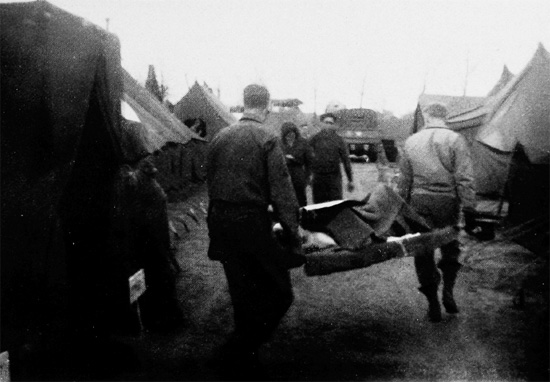
Litter bearers carry a patient into one of the Ward tents. 41st Evacuation Hospital, Rheydt, Germany, 7 March 1945.
There were a few changes in the nursing staff during this period. Second Lieutenant Virginia R. Thomas reported for duty; Second Lieutenants Twinabelle K. Wingert and Ouida L. Bigler were on TD with the 41st. First Lieutenant Grace E. Bradshaw was transferred to the 24th Evacuation Hospital on 6 January, and a number of Nurses received battle field promotions.
Supply had one major change during the month of January. On 17 January 1945, First Lieutenant Henry E. Zeranski was transferred to the 92d Chemical Mortar Battalion; Second Lieutenant Joel W. Rudd was assigned as Supply officer, in addition to his other duties as Assistant Adjutant. On 3 January, the duties of Receiving and Evacuation Officer had already been assumed by Captain James T. Williams.
In an effort to make the handling of valuables more efficient, the valuables slip was changed. The patient, on admission, signed that the articles checked were correct. When being evacuated he signed that the articles received were correct. If he had turned in no valuables, he signed his name denoting this. With this system, the burden of proof rested on the patient. However, every effort was made by the unit to not to betray the patient’s trust.
On 23 January 1945, Colonel J. Harrell, CO, was presented the Bronze Star Medal by Colonel William E. Shambora. The presentation took place in Ward 9, with the personnel of the organization present for the occasion.
On 31 January, Lieutenant Colonel Pasquale from the Inspector General’s Office visited the Receiving Department to see how patients’ valuables were handled. The standard methods (recently amended) were explained to him in detail, much to his satisfaction. As a move to deflect the stream of information seekers from the Receiving Office, a condition which decreased the Department’s efficiency, an “Information” sign was placed on the property exchange tent. Here a representative courteously directed his interrogators to their objective; in doing this, both they and the Receiving saved time and inconvenience.
Lieutenant General William H. Simpson, CG, Ninth United States Army, visited the 41st Evac during the month. His visit was entirely informal and of a social nature. Colonel Shambora, Lieutenant Colonels Smith, Manning, and McKie and other members of the Surgeon’s Staff, Ninth US Army came along too.
The services of the entire 463d Medical Collecting Company, supplemented by 30 civilian laborers were really appreciated. Since it was not a time of great activity this extra manpower was more than enough to meet the needs of he various departments (their services were lost when the Hospital closed). Privates Ralph M. Buckley and Winford Hill were lost to this organization by transfer to the 53d Field Hospital and the 102d Infantry Division, respectively. Technician 5th Grade Wesley K. Powers was transferred to a General Hospital as a patient. Technician 4th Grade Robert J. Harris went back to the States on the rotation furlough plan. He was the first man of the unit to receive the benefit of this social plan. Very few other men, eight in all, became ill enough to be admitted to the hospital during the month. The 41st was fortunate when two men, who had been given up for lost, were returned from General Hospitals in England. These two men, Corporal Frank J. Leff and Private George J. Peluso, were both capable men and the organization was certainly glad to get them back. Four more Dutch guards were assigned to cover an additional post designed to keep civilians out of the Hospital. Seven men from the 754th Motor Ambulance Company were assigned for possible use in evacuating emergency patients.
The month of January1945 brought a change of personnel in the American Red Cross Detachment. Miss Nancy Jones was the first to leave, and went to the 128th Evacuation Hospital. Miss Ruth Stenvick left later for the 4th Convalescent Hospital. During this period Miss R. Stenvick went over all correspondence with Miss Willa Blake who joined on 18 January. Miss W. Blake had the opportunity of getting acquainted with the personnel and the hospital setup before she assumed full charge. The American Red Cross had a supervisory visit from Miss Lois Duncan at which time she told the CO that he could expect another American Red Cross girl soon.
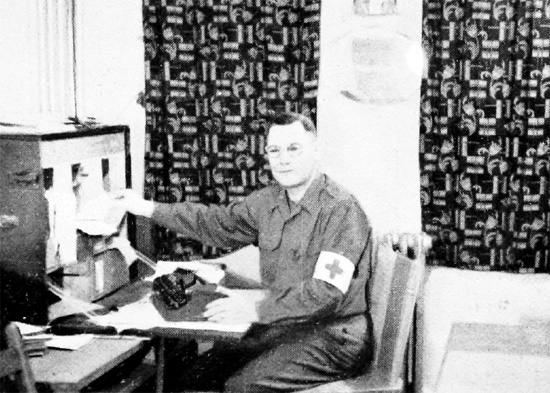
Chaplain (First Lieutenant) William H. Barsh, ChC, carries out general administration.
On 18 January 1945, the 41st Evacuation Hospital closed to further admissions by order of the Surgeon, Ninth US Army for a rest period. Patients then in the wards were gradually disposed of through the usual channels, and as soon as the hospital census was low enough to allow it, a Medical OD roster was instituted and all personnel entered upon a period of rest. There were a few Departments that however could not close down completely, but they managed to continue to operate with a “skeleton” group during the rest period.
The rest period was fully utilized by the men of the 41st; many of them used this time for ice skating, hiking, visiting Brussels, Paris, or just resting. A total of 174 men took the trip to Brussels and 7 men went to Paris. Others found the local facilities attractive enough to keep them in the area. There were eighteen movies shown during this period as well as one USO show, in which Don Rice and his troupe appeared, and three “GI” shows. Besides this, there was a dance held exclusively for the organization at the dance hall in Maastricht, Holland. Approximately 150 men attended and the 70 Dutch girls present were not allowed mush rest. Refreshments of ice cream and cookies were served and this with the service of the 131st Antiaircraft Artillery Battalion Dance Band, made it a very pleasant evening.
The total number of Hospital admissions for the month was one 1,237. There numbered: 260 wounded; 639 diseased; 295 injured; 25 Allied troops; 8 enemy and 10 civilians. The total number of deaths for the month was 10.
The first of February 1945 found the Ninth United States Army built up to strength and deployed along the Roer River from Linnich to the vicinity of Düren, Germany, and making preparations for a crossing of the river. In that the two forces had spent the greater part of the winter fortifying the Roer River, it was expected that the crossing would be a bloody and costly one. First United States Army had made some progress in the sector below Düren and had been engaging in some active fighting on their front. Patton’s Third United States Army, never to be outdone, was making some progress through Luxembourg, while Seventh United States Army had its hands full pushing the Germans back from Strasbourg with the help of Free French Forces. On 23 February Ninth US Army jumped off, following a heavy artillery barrage. They encountered severe artillery fire zeroed in at the crossing sites. The Roer River was almost at flood level, but the crossings were made along the front after the Engineers took a heavy pounding from the Germans. Within a week, Simpson’s Ninth US Army had reached the Rhine in some places, over-running many towns between the Roer and the Rhine. Ninth United States Army elements, in fact, were the first US troops to reach the Rhine, although some time was required to consolidate these gains. The 2d Armored, 8th Armored, 29th Infantry, 30th Infantry, 35th Infantry, 83d Infantry, 84th Infantry and 102d Infantry Division participated in the offensive action. The weather was not good. There was snow on the ground most of the month and there was a great deal of rain, but the action went right ahead, nevertheless.
Ninth US Army Evacuation Hospitals were located as follows:
24th Evacuation Hospital – Bardenberg, Germany
41st Evacuation Hospital – Heer, Holland
91st Evacuation Hospital – Valkenburg, Holland
100th Evacuation Hospital – Terwinselen, Holland
105th Evacuation Hospital – Sittard, Holland
108th Evacuation Hospital – Vaals, Holland
111th Evacuation Hospital – Heerlen, Holland
114th Evacuation Hospital – Herzogenrath, Germany (new unit)
Around mid-morning of 6 February, an order was received to re-open the Hospital at the same site, with reception of patients to begin at 1300 hours. By good fortune only two men of the Ward Section were out on a pass when this order was received and no great difficulty was experienced in resuming active function at the time specified. During the first forty-four hours of operation the unit possessed no personnel other than its own. This necessitated the Ward Section loaning 12 men to Receiving, OR and X-Ray to act as litter bearers. Inasmuch as the Section was already understrength, this further depletion of personnel seemed at first serious; however, no difficulty was encountered in adequately manning the wards, due to the fact that the rate of inflow of casualties was not too rapid. During the first twelve hours only 16 patients were admitted; during the ensuing three days the numbers admitted daily were: 125, 120, and 122. By the time the ward census had reached an appreciable figure, the unit was augmented by personnel of the 422d Medical Clearing Company, thus enabling the Detachment Commander to return to the Ward Section the twelve men temporarily used as litter bearers.
Very few battle casualties were received during these first few days of resumed function; the great majority of patients were medical or non-operative surgical cases. There was, in particular, a high proportion of respiratory cases, so that within forty-eight hours, three wards were entirely filled.
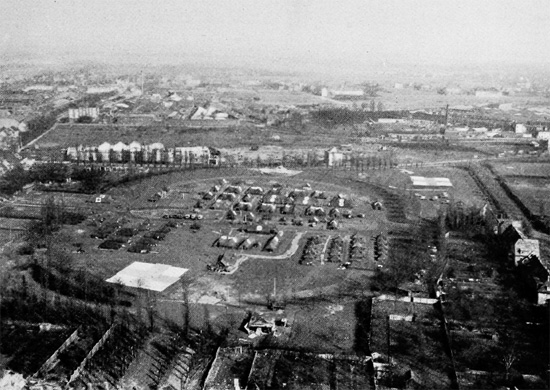
Another aerial view of the 41st Evacuation Hospital installations in the “Sportplatz”, Rheydt (Mönchengladbach), Germany, 1 April 1945.
On 10 February 1945, Captains Pearl and Harshbarger, of the 422d Medical Clearing Company, reported for duty on a detached service status, and were assigned to duty on the wards. The same day, Sergeant Norman Tesser, of the Ward Section, was transferred to the Supply Department. From 11 to 17 February admissions consisted, for the greater part, of medical and surgical disease cases with only a minor percentage of the admissions being battle casualties. The number of daily admissions was such as to keep the personnel comfortably busy, but not hard pressed. The twelve Enlisted Men of the 422d Medical Clearing Company, attached to the unit, were used as Ward Technicians and seemed to be an unusually competent and satisfactory group of men.
On 12 February, the Contagion Ward was moved from its former location to the room previously occupied by the ARC people. This was done at the request of the American Red Cross and the Detachment of Patients Commander. No particular difficulties were encountered other than the labor involved. While on the subject of contagion, it might be mentioned that during this period an unusually large number of patients with contagious diseases were admitted to the hospital, particularly mumps and measles cases. Some difficulty was experienced in accommodating all these patients. By conversation with Lieutenant Colonel McKie, Medical Consultant, Ninth US Army, arrangements were made by which cases of German measles could be transferred to the Convalescent Hospital after subsidence of the acute symptoms. This helped ease the pressure on the Contagion Ward.
On 14 February, at the request of the Commanding Officer, a small four-bed ward for female patients was prepared in Ward 7, consisting of a section of the room separated from the remainder of the patients by a partition, and equipped with iron beds with springs and mattresses. Prior to this time, female patients had been cared for in the various wards by screening off the individual cot, but this procedure had not been entirely satisfactory.
Throughout this week, as for several past weeks, work was continued on the field equipment of the Ward Section, in anticipation of the time when the Hospital would leave the present location in comfortable buildings and resume active campaigning under field conditions (read, under tentage –ed). Efforts were being made to recondition all the field equipment, to determine shortages due to loss and wear, and generally to put the section in such a condition that it would be able to take the field smoothly and well prepared. Due to the inevitable wear and tear of four months of active field function prior to setup in the present building, much of the equipment was worn and some unserviceable, so that this preparation seemed very much advisable.
On 21 February 1945, Chaplain William H. Barsh was transferred to the 79th Ordnance Group. Captain Clyde J. Verheyden, ChC, reported for duty with the organization on 23 February to replace Captain W. H. Barsh.
In February the Ward Section acquired forty iron beds of the type used in General Hospitals, complete with mattresses. These beds were installed in the non-transportable wards, as it was considered that these patients were most deserving of this luxury. The Ward Section also acquired, at the same time, one hundred mattress pads for use with the canvas folding cots. These were also put in use, being placed generally in the wards which handled the sickest patients. Six of the ward tents which had been erected in the courtyard some months before were struck and put in storage. This was done because it seemed no longer necessary to keep the tents up and also because a few days of good weather had dried the canvas, creating an optimal time for storing, and finally because movement of the unit to a new location seemed inevitable before long.
23 February 1945, Ninth US Army began its long expected offensive toward the Rhine River. The Hospital experienced a trying day on this occasion being “slugged” with 271 casualties at a time when they were moderately loaded with medical and surgical disease patients (one hundred and eighty-seven in the wards).
The casualties came in very rapidly, the two hundred and seventy-one patients being received within a period of only about 11 hours. At the onset of this “big business” there was only one pre-operative ward prepared, with a capacity of forty beds. However, through fast action and considerable juggling of patients and with the use of one outside ward tent, the staff managed to accommodate the influx of casualties with at least an outward appearance of calm and normalcy. It is at such times an this that one experienced personnel prove their worth, and on this occasion the Chief of Wards was thankful for the obvious efficiency of his personnel — an efficiency which was the result of seasoning and hard experience. By 24 February, admissions totaled 198 and on 25 + 26 February, 180 and 122 respectively
From 23 February to 0800 hours, 27 February, the Operative Section operated on 333 patients with the majority of the work being minor surgery, self-inflicted wounds, and injuries, with a proportionate increase in the number of appendectomies performed. The greatest number of operations performed on any one day during this period was 28. During this period there was one laparotomy for a gunshot wound of the abdomen and one thoracotomy for a shell wound of the chest. It was during this comparative lull that the evacuation policy for the Army Zone was increased to 15 days. This allowed the return to duty, via the Convalescent Hospital, of many patients with minor injuries. However, it was still impracticable to attempt to return operative cases to duty through this channel. Colonel Glenn Spurling, Neuro-Surgical Consultant, ETOUSA, visited the Hospital and gave the Operative Section some very helpful hints in the care of Neuro-Surgical patients received in forward areas.
During the month of February the Laboratory lost Private First Class Lewis A. Temple who was transferred from the Laboratory Section to fill a gap in the Pharmacy. As a replacement for the Laboratory, Private First Class Percy H. Augustus was recruited from the Ward Section. The Dispensary handled the physical examinations for re-classification of the entire Enlisted personnel of the unit and attached personnel.
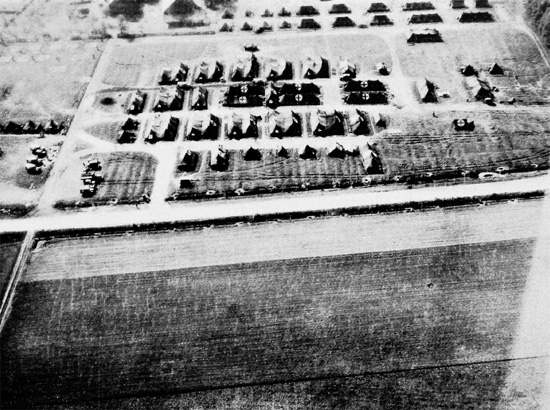
Partial aerial view of the 41st Evacuation Hospital at Dorsten, Germany, 6 April 1945.
Laboratory Tests – 41st Evacuation Hospital The Laboratory performed 2,338 tests of various types during the period. The Pharmacy filled 430 regular prescriptions and 324 narcotic prescriptions. They dispensed 125 units of blood and 94,000,000 units of penicillin. The Dispensary treated 672 out-patients during the same period.
A mobile X-Ray auxiliary unit arrived on 10 February to supplement the X-Ray personnel. The unit remained until the end of the month and proved to be a very valuable and highly skilled asset. The total number of patients x-rayed during the month of February 1945 amounted to 1,351.
The driver maintenance (first echelon) and either the 1,000-mile (monthly inspection) or the 6,000-mile maintenance was performed on all vehicles during the month. Four vehicles were in the Ordnance for higher echelon maintenance. All tires on the vehicles were examined by an Army inspection team. Ten percent of the tires were checked for proper maintenance. The inspection was very satisfactory. One vehicle, a 2½-ton 6 x 6 truck, was stolen in Brussels, Belgium, on 2 February. An investigation was made and a report of survey was conducted and sent to higher headquarters. Fortunately, this vehicle was later recovered.
During the month of February, Utilites checked the pump and reservoir daily, built thirty blackouts, overhauled four generators, put new grates in a boiler, constructed new illuminated road signs, built a door for the property exchange tent, built another door for the linen supply tent, put in new lights for the Receiving Department, wired lamps for the Headquarters area, set up a pool table in the EM’s Day Room, set up a pool table in the Officers’ Day Room, repaired the chimney to the big boiler, installed a radiator in the Registrar’s Section, repaired a door in the Mess Store Room, fixed four faucets, replaced old wire in wall plugs for Ward 9, replaced old wire in the conduits for Ward 22, built a viewbox for Colonel George R. Benton, made twenty signs for the American Red Cross, added new wiring for ARC lamps and radio, put in a new telephone line to Transportation, repaired a valve on a steam kettle for the kitchen, built two boxes for the Laboratory, repaired four doors, replaced six fuses and burned sixty tons of coal in the furnace.
The month of February brought with it the following changes in the Dental Department: electric dental engines replaced the old style engine, and an MD Chest No. 62 was issued to the Department. The Department was fairly busy.
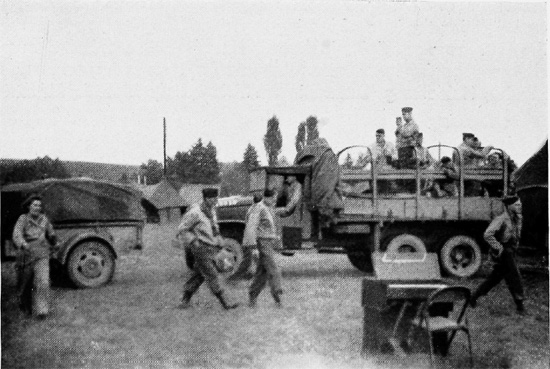
“85 pointers” prepare to leave the 41st at Bad Nauheim, Germany, July 1945.
During this period the personnel continued to take advantage of the Brussels trips and passes to Paris (France), Hannut (Belgium) and Maastricht (Holland). Privates Frank A. Paoletti and Willard H. Howard were transferred. Private First Class Salvatore Cuccinello joined the unit. The allotted quota for furloughs to the Zone of Interior allowed the 41st to send Technician 4th Grade Kenneth D. Lankford, who had more overseas service than anyone else in the unit, to the States.
The movies played to large attendances, as usual, and billiard and ping-pong tournaments were started. The basketball team played two games and won both easily. The 2d Armored Division Band played and Mickey Rooney put on a show that was very well attended by Officers and Enlisted Men. The dayroom was well equipped for reading and writing and the game room never remained unoccupied.
Miss Kay Sanborn, ARC Staff Aide, formerly with the 55th General Hospital, joined the organization. Her first few days were spent in getting acquainted with members of the of the unit and planning the working schedule. It was decided to divide the working load evenly between Kay Sanborn and Willa Blake. The Lounge room was to be kept open from 0900 to 2300 each day, and to be covered by Army Red Cross personnel at all times. The wards were divided evenly and each staff worker assumed responsibility for all services on the wards she was covering. The American Red Cross Recreation room was always full.
Under Sergeant Jay B. Schwartz and Corporal Wilbur R. Koons, newly appointed NCOs in charge of the Receiving and Evacuation Section, marked changes and switching of personnel on the first of the month resulted in better cooperation and efficiency between and among the personnel of both Departments. The Evacuation Section was reduced from four to two men, due to shortage of typists in Receiving. The shifting followed a plan to use all available personnel where maximum efficiency could be attained for the individual, the Department and the Hospital as well. All personnel were re-oriented and adjusted to more strict disciplinary measures complying with standards of the Medical Corps in the handling and receiving of patients through courteous, attentive, and non-boisterous actions. In order to make a more favorable impression upon visitors and incoming patients, the walls of the Receiving Office were painted white, pictures were re-hung and the floors were oiled. Not only was this act instrumental in raising any incoming patient’s morale, but it had a definite effect on the spirit of the personnel themselves. Pride was taken, voluntarily, in keeping the place clean and tidy. Personnel proudly listened to the praise of their fellow soldiers. They were proud to be a member of the unit. It was gratifying to note this improvement.
The total number of admissions for the month of February 1945 from all of the categories was 2,100; which included 1,164 disease cases, 350 injuries, 539 slightly wounded and 47 seriously wounded. There were 8 deaths, six dying of wounds and two of injuries. All of these occurred in the last five days of February during the Roer River crossing.
The files for US Army personnel admitted to the hospital were set up according to the classification of causes for admission. In general, this consisted of three main files: disease – injury – wound. There was a further breakdown made of the Army troops in that the records on colored troops were kept in a separate file (the US Armed Forces were still segregated during World War Two –ed). This was due mainly to the fact that all colored personnel were carried on a separate weekly statistical report, ETOUSA MD Form No. 310. In addition, a separate file was kept on US Navy personnel admitted to the Hospital. This file was broken down according to the cause for admission, also, but there were only a few cases for consideration.
On 27 February 1945 the 41st Evac Hosp ceased receiving, by order of the Surgeon, Ninth United States Army and began the task of closing down in preparation for movement.
Germany:
By the end of February, US forces on the western front were generally on a line extending from a point on the Rhine River, about ten miles south of Wesel, south along the Rhine, or within a few miles of it, to Duisburg, Düsseldorf, Cologne, Bonn, and Remagen. From here it dropped back to a point about eight miles west of Coblenz, then south and west of the Moselle River to Trier; to Saarbrücken; to a point just west of Karlsruhe; then south along the Rhine past Strasbourg and on to the Swiss-French-German border. Ninth US Army held the northern flank of the front, then the First United States Army; next the Third US Army, with the Seventh and the First French Armies on the southern flank. The arrival of the Fifteenth United States Army in the combat zone was announced by higher headquarters. First US Army advance elements captured a railroad bridge across the Rhine River in a spectacular dash forward at Remagen, poured troops across and secured a bridgehead on the east bank. The capture of this bridge intact was one of the “breaks” of the war which added materially to an early end of the conflict. Ninth US Army cleared up all the Germans still west of the Rhine in their sector of the front and proceeded to cross the Rhine between Wesel and Duisburg. The crossings were made without great losses, and the bridgehead was rapidly enlarged. The cities of Dinslaken, Hunze, Wesel, Dorsten, Haltern-am-See and Coesfeld were captured. By the end of the month, the Ninth Army front extended from Coesfeld on the north through Dülmen, Recklinghausen, and to a junction with the great Reichsautobahn leading south.
The 2d Armored Division, however, was pushing on beyond the line directly east toward Paderborn, to join up with the 3d Armored Division, pushing up from the south in an effort to close the gap through which all German troops in the Ruhr Valley were to escape or be cut off. Third US Army advanced to the Moselle River, crossed it west of Coblenz and quickly overcame all resistance between the Moselle and the Rhine, capturing large numbers of German troops. In a lightning maneuver, Patton’s forces crossed the Rhine south of Coblenz and by the end of the month, had advanced well into Germany, capturing Mainz, Wiesbaden and Frankfurt.
Seventh US Army finished cleaning out the area west of the Rhine in their sector, generally from Karlsruhe south to the Swiss-French-German border, and was ready for crossing the Rhine when the month ended.
The weather at this time had improved so much that everyone was saying that the winter was over, and spring was on its way. There were fourteen days of warm, sunshiny weather and, for once, the Allied Armies had weather favorably influencing further progress of the war.
This was the situation, then, during the month of March along the whole American front. The crossing of the Roer and subsequent dash to the Rhine by Ninth US Army forces was accomplished at a smaller cost in casualties than was expected and this fact made a great difference in the type of function that the hospital was to experience in March. On 2 March 1945, the organization finally left their nice warm winter quarters at Heer, Holland, and followed XIX Corps across the Roer River. Orders were to set up the medical facility under tentage in the vicinity of Mersch, Germany; but upon reaching that area the orders were changed because of the rapid advance of the forces pushing toward the Rhine, and the site selected would be too far to the rear to give the proper support. After spending the night at Mersch without unloading any of the equipment, the unit left the next day for Rheydt, Germany. The billeting party had made several unsuccessful attempts to find suitable buildings to move into, but none were available. The most suitable place within the area was the Rheydt Sportplatz. The plaza was well drained, level and of sufficient size for all installations to be set up according to plan. Although the 41st had been the first Evacuation Hospital to move into buildings in September 1944, the unit was the first to move out into tents in March 1945, and in both instances it was as much a matter of necessity as of choice. The unit opened at Rheydt 4 March and for the remainder of the month functioned generally as a Station Hospital. The flow of patients was so spread out over the month of March that the organization was never over-worked, nor was there a large backlog at any time.

From L to R: Second Lieutenant John W. Burrell, MAC, and Staff Sergeant Richard Jeson with vehicle, Stederdorf, Germany, 28 April 1945.
There was a continuous stream of visitors to the Hospital in March, for it looked like they had the best setup in the ETO and the best the unit ever had. The area was ideal for the purpose. After some of the Consultants from the Army Surgeon’s Office saw this setup, they advised other units to come and look over the physical layout of the 41st Evac. The Commanding Officers and key personnel of most of the other hospitals visited the unit during the month. In addition to regular Medical Officers, the following people visited the Hospital during March 1945: Brigadier General Parott, Surgical Consultant 21st Army Group; Brigadier General Bulmer, Medical Consultant, 21st Army Group; Major General Charles Gerhardt, Commanding General, 29th Infantry Division; Brigadier General Nugent, Commanding General, XXIXth Tactical Air Command; Colonel Shambora, Surgeon, Ninth United States Army; Colonel Wilkinson, Executive Officer, Fifteenth United States Army Surgeon’s Office; Colonel Rumph and Lieutenant Colonel Knapp, XIX Corps; Lieutenant Colonels Smith, Manning, McKie, Reinstein and Agnew and Major Walsh, Surgeon’s Office, Ninth US Army; Lieutenant Colonel Mike DeBakey, Surgeon General’s Office; Colonel Kidder, Commanding Officer, 134th Evacuation Hospital (Fifteenth US Army), and personnel of the 125th Evacuation Hospital, another Fifteenth US Army unit preparing to function for the first time.
The setup of the Operative Section was in accordance with the new winterization plan, and was found to be highly satisfactory. It offered the advantages of being more compact, being under a single lighting and heating system, and having a warm waiting room. Its only disadvantage was that it required approximately three hours additional work to complete the installation. With freezing temperature outside, the mean temperature of the Operating Ward varied from 64° to 70° F, which was found to be entirely satisfactory. A single lighting system was found to be of considerable help to both litter bearers and circulating personnel. The admission rate of operative patients to the Hospital during this month was rather low, with a total of 539 patients being operated. Of this total only 92 were combat injuries, the remainder being surgical diseases and non-combat injuries. Fifty-one appendectomies were performed during this period. The peak backlog reached was 11 and the greatest number of operations performed during a twenty-four hour period was 37. No cases of gas gangrene were encountered here, nor were there any problems of a remarkable nature. A task of considerable proportions confronted the Ward Section in closing the Maastricht (Heer) operation and preparing for movement to the field. All the equipment of the wards had been divided up and distributed to equip eighteen wards of varying size in the building at Maastricht. It was necessary to re-apportion all of the equipment for the equipping of eleven ward tents. This involved, in effect, the pooling of all equipment and a new breakdown. This work was carried out during the last days of February and the first week of March, and on the second day of March the trucks were loaded for movement. It was indeed fortunate that the Hospital was not rushed unduly during this task, as it was being involved in a special procedure which would have been chaotic, if hurried.
The actual work of setting up the wards in the field at Rheydt began about 1530 on 2 March and proceeded through the following day. A few patients were received on the afternoon of the 3rd, although the wards were not entirely ready at that time. The installation of the hospital in tents on this occasion seemed particularly difficult. There were several reasons for this, the principal ones being adverse weather conditions and shortage of manpower. The Ward Section’s original 75 men had been reduced, in one way or the other, to 62. In addition to this permanent loss of strength, another six men were left with the non-transportable cases at Heer, Holland. Several other men were detached from the section and used to perform other work which had nothing to do with the wards. As a result, the section was short thirty percent of its authorized manpower during the period of installation. Such a loss was naturally reflected in the length of time required to set up the wards. After the installation was erected, the hospital was not especially busy. Daily admissions were relatively low, and only a small percentage of these were battle casualties. The greater number of patients admitted were suffering from upper respiratory diseases. This was not unusual, in view of the inclement and harsh weather conditions prevailing at this time.
The problem of a work room for the EENT Specialist was solved during this setup by erecting two small wall tents directly behind Ward 7, connected directly with the ward by a blackout tunnel. This created a “room” of sufficient length for doing eye refractions, and had the great advantage of having the Ward Officer, who was also the EENT Specialist, under the same roof with his transportable post-operative patients. Another small, but vexing, problem was solved here. With the ward tents erected side by side there had been, in the past, much annoyance caused by the leaking of rain water into the tents at the front and rear and at the seams, caused by tying the tents together. Enough odd pieces of tin were found in this area to make tin gutters about thirty-six inches long, which, when put in place under the ends of the seams and projected outside the tent for drainage, proved very satisfactory in carrying off the water. During the week of March 10, the number of battle casualties received continued to be proportionately small, the greater portion of the patients being disease cases. There were a great many cases of severe throat infections due to streptococci and pneumococci; many of these patients were severely ill for several days. There was a moderate incidence of atypical pneumonia, and a miscellaneous assortment of medical and surgical diseases. One noticeable aspect of the disease cases admitted during this period was the absence of malingerers and psychoneurotics, it seemed that there were very few patients of this type being admitted to the hospital. Practically all of the disease cases received were in genuine need of hospitalization.
As March wore on, the census of the Hospital rose until a point of stabilization was reached in the neighborhood of 220 patients. It was necessary to employ Ward 2 for the receipt of surgical disease cases, in addition to Ward 8, as the forty beds of the latter were inadequate to handle the number of patients of this type admitted. Wards 3 and 4 were employed for miscellaneous medical disease cases. Shock Ward and Ward 1 were the only wards kept available for surgical pre-operative cases, while Wards 5, 6 and 7 retained their usual designation as post-operative wards. The transition of the Laboratory, Pharmacy and Dispensary from their spacious quarters in Heer to the rain-swept, windblown tent hospital at Rheydt was taken in stride by the “bloodhounds.” After becoming used to the deficiencies necessitated by this type of outdoor life, the unit began to feel that they could set up in igloos, if necessary. The function at Rheydt was notable for a large number of out-patient consultations handled by the Dispensary. The figure of 1,076 treatments indicates the number of cases actually treated, or examined, by the Dispensary personnel. At least two and a half times that number were routed through the Dispensary to other services, such as X-Ray, EENT, Surgical and so on. Dermatological and Neuropsychiatric cases, as well as general medical, were treated at the Dispensary. Particular mention was to be made of the Enlisted personnel of this Department, Sergeant Manuel R. Costa and Corporal George W. Scott, whose superior performances enabled the large volume of patients to be handled smoothly and efficiently.
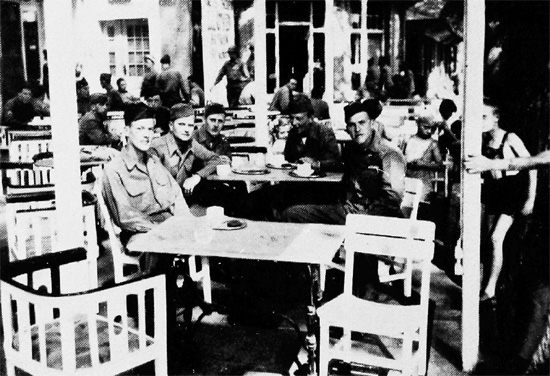
General view showing the American Red Cross Club at Bad Nauheim, Germany.
Laboratory Tests – 41st Evacuation Hospital The Laboratory personnel was also as busy as the proverbial bees and made 1,912 different tests while at Rheydt. Of these, the majority were in the field of hematology. 655 urinalysis tests and 277 bacteriology tests were made during this period. The Pharmacy did not waste any time either, and filled 465 regular prescriptions, as well as 210 narcotic prescriptions. 113 units of whole blood were used at this location, while 99,500,000 units of penicillin were distributed. Both the amount of whole blood and penicillin were far below the percentage used when the hospital was busy with a larger number of battle casualties. At Rheydt, Germany, the number of deaths was less than when the Hospital operated in support of units in actual combat. In all, there were 21 deaths of which fourteen were American soldiers, while the others were mostly German civilians or PWs. Autopsies performed by Captain L. E. Shapiro numbered 8 and there were 7 post mortem inspections.
The American Red Cross and Special Services encountered difficulties in erecting their tentage at Rheydt. The hospital personnel were not available for this purpose, but the men of the 501st Medical Collecting Company, attached to the hospital unit, volunteered their help and were of great assistance with such details as heavy lifting, putting up the tents and stoves, and general work to help them get ready. At this location, a change was made in the allotment and arrangement of tents for these Departments. Special Services and American Red Cross were set up in one ward tent each, so in order to make the most possible use of them, they were pitched end to end, both to be used by hospital personnel and patients alike. The first tent was utilized chiefly as a lounge while the rear tent was converted into a game room. Both tents were operated by the ARC. Although the Department was ready to function as soon as the hospital began to receive patients, the first few days were spent in re-packing of equipment and inventory of supplies. Then began the search for furniture to fill up the rather barren tents. With the help of some very willing soldiers, and the cooperation of the Military Government, it became possible to secure plenty of furniture, including tables, lounge chairs, sofas, bookcases, and a buffet. From the equipment secured the tents were furnished attractively and a cozy atmosphere was effectively created in spite of the canvas roof. Shortly after everything was in readiness, the Commander assigned a Dutch civilian to work with the ARC. His work was not satisfactory and he was replaced with another Dutch person. Since the Dutchman could not speak English, the ARC had to be covered by one of the workers at all times. This resulted in a decrease of ward coverage and waste of precious time, since only one worker was available for activities on the wards. However, in the middle of the month, Private Ray Higdon from the 501st Medical Collecting Company was assigned to work with the American Red Cross girls. The Dutchman was also permitted to remain, since Private Higdon’s assignment was only temporary. This setup was ideal, yet of short duration, as Private Higdon was hospitalized shortly thereafter. During the month, a large number of ambulatory patients frequented the American Red Cross. They came to relax, read, play cards, write letters, drink cocoa, or just plain “shoot the breeze.” Since the movement into Germany, more and more personnel began to frequent the ARC and Special Services facilities, and it was evident that because recreational activities within Germany were almost non-existent that these services would become increasingly important to the men and women of the unit.
Fortunately, as the 41st Evac was set up in a Sportplatz, tennis courts, volleyball courts and baseball diamonds were available, or were easily laid out, and all personnel of the organization made the most of the opportunity to use them while stationed in Rheydt. Special Services acquired a large assembly tent that proved just what they had been needing for movies, church services, and unit formations. The tent seated 300 spectators easily and was far better than any previous arrangement. During this period, there were several first rate movies, but they were extremely hard to get, because of the priority given to field divisions in rest periods and because of the distance from the film library. The unit was fortunate in being able to billet for the first time in ward, squad or pyramidal tents. The men were issued a folding cot each, and they acquired stoves from the ruins of nearby buildings. It was a satisfactory arrangement from every standpoint, as individual pup tents had not been satisfactory at all.
Being in enemy territory for the first time, it was necessary to place armed guards around the hospital area. The services of the Dutch guards were lost at Heer, so it was necessary to use the own men. Eight men were used for this purpose, although it meant using men from Departments that were fully functioning. The 501st Medical Collecting Company remained with the Hospital during the entire period, as was a Platoon of the 571st Motor Ambulance Company. Six civilians who were already employed at Heer, were joined by 23 Displaced Persons upon arrival at Rheydt. These were Dutch, Polish, Russian, and Italian DPs and their work proved to be very satisfactory.
Men continued to be sent on pass and, in addition, the unit received a quota of five men to go on a 7-day furlough to England. The names of all the men who wanted to go were put into a hat and a drawing was held. The lucky men were: Louis Woocher, Russel E. Covey, James H. Johnson, Joseph Miceli, and Louis J. Martarano. There was also a quota of one Officer, and that lucky man was Captain Stefan S. Fajans. These were the first furloughs that had been allotted to the 41st since leaving England and naturally everyone was trying hard for a place on the list.
The Supply Department remained in the buildings near Maastricht for two days after the rest of the unit left. It required eleven 2½-ton trucks and three 1-ton trailers to move all the equipment that had gradually accumulated during the long stay at Heer, Holland. Part of this equipment included three truckloads of German tables, benches, stools and fire extinguishers, and a great amount of personal and departmental equipment which was found lying about that the owners had left when moving in. At 1630, 4 March 1945, the Supply trucks finally arrived at Rheydt in the rain, and slush. First Lieutenant John W. Burrell, MC, organized a group to set up the tents and unload the equipment. The unloading was finished the next day and everything was set in place for normal functioning. The excess of GI and German equipment found in the buildings slowed down the general process, but the medical and linen supply section was set up and started functioning before the storage supply was unloaded. There was a change made in the allotment and arrangement of the tentage of this Department. Under this arrangement the tents were distributed as follows: one ward tent for Medical Supply, one for Storage Supply, one for Unit Supply, patient’s clothing and linen exchange; one large wall tent for storing and automatic sorting of hospital soiled linens and blankets, patients’ old clothing and equipment; and a storage fly for sorting of troop laundry. This new plan was more satisfactory and afforded better control and protection of property. The only serious drawback encountered was that of laundry. Laundry units had been instructed to do troop laundry by the bulk method only; therefore they would not accept bundle laundry. As it was impractical for the Hospital to sort bulk laundry, this proved quite a problem. After many contacts and much persuasion, a unit was located that agreed to do Officers’ and Nurses’ bundle laundry. Several methods of handling EM’s bundle laundry were tried, but all proved impractical. It was also difficult to find and keep in daily contact with the laundry units to do the Hospital’s laundry in view of possible moves. It had been experienced that they usually closed for movement before the hospital did, but never arrived at the new designated site until several days after the medical unit’s arrival. This necessitated long and searching trips and the situation at times became critical. The best solution was to have a laundry unit and personnel attached to the organization, as was the case when the 41st functioned under First US Army control.
An entirely new note was struck by the changed nature of the work that the X-Ray Department was called upon to do. This was characterized by a great increase in the number of out-patient cases. The chief reason for this unusual situation was caused by the fact that the Hospital’s central location among a large number of service troops gave opportunity for routine and dispensary-type examinations. The simplest solution to such a problem was the temporary assignment of additional personnel. It was so at the beginning, but the personnel of the mobile auxiliary unit that supported the organization was soon ordered to another area. It was the re-stated policy of the X-Ray Department to use a two X-Ray machine setup, with day and night shifts of personnel in order to handle the patients more efficiently and more quickly. The flashbox method of permanently identifying films proved to be most satisfactory. A number of items which were of little or no value to the efficient operation of the Department were therefore returned to Medical Supply. These items were the Biplane Marker, the Re-Orientation Device, the Air-flow X-Ray unit, the Auxiliary Wash Tank Unit, and the Grid Carriage. In addition, one dark room tent was returned to Medical Supply too. During the month, the Department performed X-Ray examinations on 1,480 patients, of which 624 were referred from the Dispensary. There were 2,454 films used for these examinations. To the great advantage of the Department was the hook-up of the X-Ray Department with the hospital generators for electrical power. This was an excellent arrangement and completely eliminated the headaches engendered by the gasoline generators being operated by the X-Ray Department.
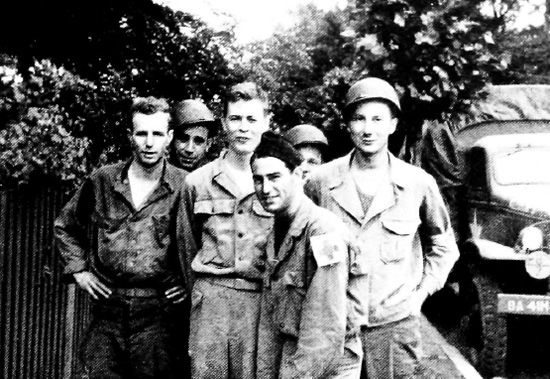
From L to R: Privates Wallace R. Curtis; William Jeli; Private First Class Wayne W. Rathbone; Corporal Rubin Shapiro; Private First Class Elmer E. Adams; and Corporal Andrew G. Yanicak, outside the Mess Hall, Iserlohn, Germany, 10 May 1945.
The proper maintenance was performed on all the vehicles of this unit by the Transportation Department. The driver maintenance and either the 1,000-mile, the 6,000-mile, and general maintenance inspections were all duly performed. Four vehicles were with Ordnance for higher echelon maintenance. All other vehicles were in a very satisfactory operating condition. An inspection of the motors was made by an Ordnance Inspection team. Ten percent of the vehicles were inspected. The inspection proved very satisfactory. A stolen vehicle which had been missing for a considerable period of time was found and returned. The vehicles had been away from this unit for the bigger part of the month, moving other units. Approximate total mileage driven was thirty-one thousand miles, considerably more than the average life of standard Army trucks.
During the period that the 41st Evac was stationed at Rheydt, Germany, eighteen religious worship services were held for the various faiths, with a total attendance of 1,382 worshipers. Chaplain Morris Dummett from the 621st Medical Clearing Company served two weeks in the unit on a detached service status and, along with Chaplain McEvoy of the 77th Evacuation Hospital, met the needs of the Catholic patients and personnel. Chaplain M. M. Poliankoff of the 29th Infantry Division came to the post and conducted services for the Jewish personnel and contacted the patients at the request of the Chaplain’s Office. Chaplain Bomhoeff conducted Communion Service for Lutheran personnel and looked after the special needs of his patients. Fathers Hovers and Von Zelst spent a few days with the Hospital too and everyone seemed to be happy to have them. During the month of March 1945, sixteen Chaplains from various units visited patients in the Hospital and registered at the Chaplain’s tent. Special services were held during the Holy Week, highlighted by a Good Friday Communion Service for Protestants and an Easter Sunrise Service. All services were well attended.
The move from solid buildings also presented different problems for the Utilities Department. All the factors of building maintenance were eliminated, but in their place was substituted the problem of wiring the hospital for electricity. The change from building to tentage also found many Departments requiring extra items such as bulletin boards, mail boxes, wooden doors for tents, laundry boxes, signs, and seats for mess halls. These were all supplied by Utilities. A lumber yard in the immediate vicinity of the hospital made the obtaining of material fairly easy. Two days after locating at the new area the hospital proper was equipped with overhead wiring. Telephone lines were installed shortly afterwards and wiring of outlying installations were completed. The receipt of a new 15 KW generator during the month proved invaluable in supplying power. By using two 15 KW generators alternately, in twelve-hour shifts, the lighting was much better than it was with one 15 KW generator and numerous smaller ones. X-Ray no longer required a separate generator and was able to run directly off the main generators. Location of the X-Ray Department as close to the generators as possible was of definite help in supplying power.
Spring weather caused everyone to get the “clean-up” feeling. Tent pegs were painted white and Red Cross markers repainted. The painting of the tent pegs white helped hospital personnel in moving around at night, without stumbling over the pegs or guy lines. Litter bearers especially benefited from this. Various Departments obtained paint from Utilities and painted boxes, tables, and other items of equipment. The Nurses spent the first two days of the month at Heer, waiting for the advance party to reach the new location and were then sent back for them. By the end of the second day they felt very much like orphans, but it was generally agreed that it was best for them to be left in a comfortable building until the necessary tents had been erected. On 3 March, they came along and joined the rest of the unit. 7 March, the Chief Nurse and 2 of the staff Nurses while attending a meeting at Heerlen, Holland, met with Colonel Florence A. Blanchfield, Superintendent, Army Nurse Corps, and Lieutenant Colonel Ida W. Danielson, Chief Nurse, ETOUSA. They had been visiting Nurses up and down the entire front, and everyone enjoyed meeting them and having a short chat at tea time. Many visitors were received at the Hospital during this period as the 41st Evacuation Hospital was the only one set up under canvas at that time. Among the visitors was Captain Ehrlett, Chief Nurse, 134th Evacuation Hospital, who spent a day and a half at Rheydt to experience the life of a Nurse under canvas. Social life in general was at a high peak and the comfortable recreation tents became a popular spot in the evenings for the Nurses and their friends, since, at this time, it was not safe to have the ladies leave the hospital area and be out alone in enemy territory. The recreation tent proved so popular that a second tent was set up, so that members of the group not entertaining visitors would have a place to spend the evenings too. Highlight of the month for the Officers and Nurses was the “41st party” held as soon as the Hospital closed for operations. It was the first one that organized in a very long time and everyone enjoyed themselves. The committee did an excellent job of decorating the hall (a bombed out bar room beneath a stadium) and served delicious hors d’oeuvres and dinner, complete with cocktails and wine. The 29th Infantry Division Band furnished the music for the occasion.
Shortly after arrival at Rheydt, a new directive came through that required several changes in the basic work of the Registrar’s Department, principally with regard to the Admission and Disposition Sheet. A new form had been prescribed for use by all hospitals operating outside the United States and as it was set up it differed substantially from the one that was formerly used in the ETO.
The total number of patients admitted to the Hospital in the new location was 1,794. The number was roughly six hundred more admissions than in February. A breakdown of these patients according to the cause for admissions and groups was as follows: 1,138 disease; 475 injury; 102 wounds; 20 Allied troops; 14 enemy and 45 civilians. As can be seen from the above figures, the number of wounded was very low, totalling one hundred and two only. The wounded admitted were the result of minor actions, as the Hospital received no casualties from the crossing of the Rhine River.
First Lieutenant Betty A. Harris left to begin her trip home and civilian life once more. A group of Officers and Nurses from the 5th Auxiliary Surgical Group, who had spent several months on TD with the organization, received orders to report back to their own unit. Included in this group were Major Samuel Grubin, Major Albert C. Eskin, Captain Hans Wolff, Captain Simon Zivin, Captain Eugene Sole, Second Lieutenant Edna Grand, Second Lieutenant Mary Kristoff, and Second Lieutenant Rachell J. Otis. On 22 March, Captain John J. Malee, who was on DS from the 63d Field Hospital, was assigned permanently. Captain George A. Friedman was put on temporary duty with the 113th Evacuation Hospital to take care of some especially difficult cases there. As the month drew to a close, Lieutenant Colonel Clinton E. Adams, Executive Officer, left for the United States on an emergency leave, due to the severe illness of Mrs. Adams. His absence was to be felt considerably, later on.
During the last few days of March 1945, the installation at Rheydt closed down and the organization prepared to move once more. The only hitch this time was that the billeting party discovered that the new site selected for establishing the 41st was still in German hands. Thus the personnel had to wait several more days before crossing the Rhine River to reach the newly designated site.
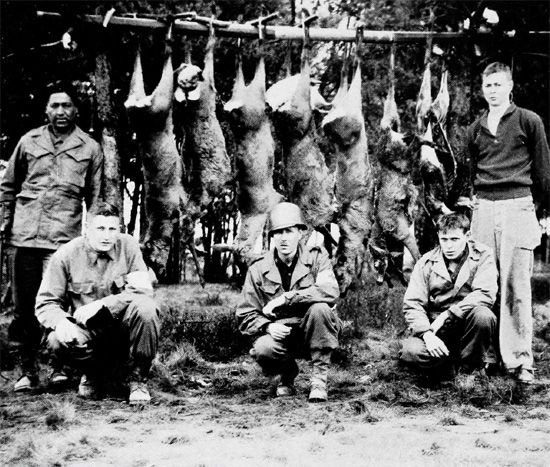
From L to R: Private First Class Mike Badboy; Technician 4th Grade Joseph G. Oertel; Major James G. Bogle; Private First Class Patrick A. Pickett; and Private First Class Wayne W. Rathbone, after a successful deer hunt, Stederdorf, Germany, May 1945.
By 1 April 1945, US Army troops were east of the Rhine all along the front and had made penetrations up to forty miles beyond. In the north, Ninth Army troops, spearheaded by the 2d Armored Division, pushed rapidly eastward from Coesfield, Dülmen, and Recklinghausen to a junction with the First US Army troops at Paderborn and proceeded, without stopping, to the Elbe River. Pockets of resistance were met all along the line, but were quickly overcome and soon wiped out. By the end of the month Ninth Army elements were on the Elbe from south of Magdeburg to Wittenberg, where they were in contact with the British. In addition, Ninth together with First United States Army troops, detached sufficient troops from the eastward drive to clean out the Ruhr pocket. Approximately three weeks were required to complete this mission. Over 300,000 prisoners were taken in this maneuver, which played a big part in rapidly bringing an end to organized resistance on the part of the German forces in the region.
When the month ended the Allied front extended from Dessau in the north, through Leipzig to Chemnitz. Third US Army advanced from the Rhine, in the south, to the Czechoslovak border south of Chemnitz, and held an irregular line between the First and Seventh US Armies. Seventh United States Army, holding the most southerly portion of the front, was in the vicinity of Munich and had overrun many large towns in their sector. In general, the advance across the Rhine River was more rapid than anticipated and the German forces put up little, if any, coordinated resistance. The Luftwaffe was gone and the German High Command was out of contact with large elements of their Field Armies. United States troops advanced some two hundred miles during the month. Ninth Army troops crossed the Elbe and headed for Berlin east of Magdeburg, but were recalled to the Elbe, as the Red Army had been assigned the sector east of the Elbe. Many high-ranking German Officers and Third Reich officials were captured and all agreed that the German cause was hopeless. First Army units linked with Soviet forces from the East at Torgau on 25 April 1945 and on the 30 April Ninth US Army made contact with Red Army units forty-five miles southwest of Berlin. This left only a small sector of Germany unoccupied: from Berlin north to the coast, a small sector of Berlin itself, part of Bavaria, Austria, and Czechoslovakia. The end of the war was near and there were several premature celebrations throughout the world following newspaper and radio reports of Germany’s surrender.
The unit moved from Rheydt to Dorsten, Germany, on 2 April, leaving Rheydt at 1630 and arriving at Dorsten at 1930 hours, crossing the Rhine south of Wesel enroute. This was a difficult move, but was effected without complications, the convoy moving better than on any previous occasion. The area was level and consisted of a barley field adjoining a farm house and adjacent buildings. The site was located five miles from Dorsten, out in the country and well away from other Army units. All the bridges across the Lippe Canal had been blown, so that all roads running north and south were effectively cut. This situation made evacuation to the 41st especially difficult from this area. As a result, the first patients started coming in from the south, as XVI Corps was driving south into the Ruhr. This switch left the hospital unit far behind one front, but placed it in an idea! position to service XVI Corps. The 41st Evac received a first number of liberated US Prisoners of War patients (RAMPs), who were very happy to be once more with their own Army. There were also a number of Russians, both military and civilians, as well as German PWs and civilians. American casualties soon dropped off considerably. However, a large number of previously non-transportable patients came in from other hospitals and holding units, so that at all times there were approximately fifty to one hundred non-transportable patients in the facility. The function at Dorsten was entirely satisfactory, and until closing on 26 April, there was a regular flow of patients which kept the staff comfortably busy. Immediately after arrival in the new area, the tents for the personnel were erected. This, in itself, was a departure from the usual practice, as formerly the hospital plant was always made ready for function before the personnel took care of its own needs. This time, however, plans for setting up the Hospital were deferred until the following morning. The weather behaved in the usual manner and it rained while the hospital was being set up. The installation of the hospital on this occasion went smoothly and easily. It was one of the few times that no pressure was in effect for an early opening.
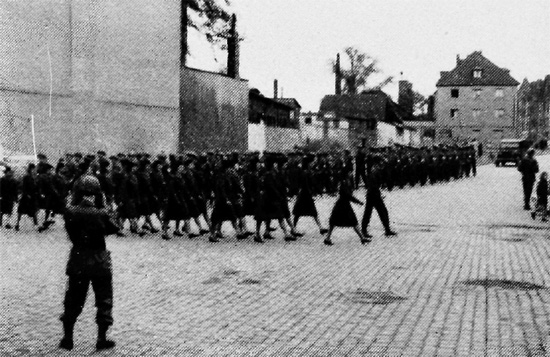
41st Evacuation Hospital staff marching on the Memorial Day Parade, Iserlohn, Germany.
The Hospital was officially opened for function at 0800 hours, 4 April 1945. The influx of patients was slow until in the afternoon when it increased sharply. From 6 to 13 April, the average number of operations performed daily was ninety-three, with a total of six hundred and seventy-seven for this period. In spite of the large number of operations performed, the peak backlog during this period was only fifty-three. The type of casualties received in this location was reminiscent of the Normandy campaign in severity and the high proportion of abdominal and chest wounds. No major problems were encountered in the Operating Section but a number of minor and trivial matters were solved without difficulty. There were no cases of gas gangrene. In the Ward Section, there was a shortage of available Medical Officers, as no Officers from Collecting or Clearing Companies were attached for duty, and Captain S. S. Fajans was away on leave in England. Fortunately, three Auxiliary Surgical Group teams arrived, plus one shock team; so with the Operating Section thus fortified, Lieutenant Colonel G. R. Benton was able to assign Captains G. F. Palmer and J. T. Williams to TD with the Ward Section. In this manner, the wards were adequately covered. During this period, Captain T. L. Jackson alone took care of all non-transportable post-operative patients. There were a large number of such cases, many of whom were critically ill, and Captain Jackson’s task was a difficult one. He worked many hours day and night, and his work at this time was exceptionally meritorious and worthy of mention. During the week of 14 April, the amount of work lessened appreciably, due to the collapse of German resistance within the Ruhr pocket. The number of wounded cases admitted declined sharply, as did the total admissions. The daily admission rate stayed consistently between forty and fifty, of which about two thirds were non-battle casualties.
Because of the decline in volume of patients handled, it was possible for the hospital personnel to enjoy a certain regulated amount of leisure. A schedule of softball games was begun, composed of teams from the various Departments. The Ward Section entered two teams, the “Hypodermics” and the “Bedpans”. There was nothing remarkable about the medical cases handled during this period. They consisted of a normally balanced mixture of all types of disease. From 21 April until 1800 hours, 28 April, the organization continued to receive patients in moderate numbers daily. The number of daily admissions ran about 45 to 50 of which the greater proportion were medical or surgical disease cases. Inasmuch as the fighting in the Ruhr pocket had been terminated by the surrender of the German forces there, the unit received very few battle casualties.
During this time, it was not considered practicable to institute a Medical Officer of the Day roster, as the number of medical cases being admitted daily was too great to be properly managed by a single Officer. All Medical Officers were kept on duty daily. However, the Officers thus employed were able, for the most part, to handle their duties and yet enjoy from two to four hours of leisure time each day. There was much recreational activity in progress during this time, in the form of an organized softball league within the unit. The Ward Section entered two teams in this league and they really acquitted themselves creditably; however, there was not enough good softball talent within the section to make up two good teams, so that neither of the teams came out in the top bracket of their respective divisions of the unit league.
The work of the Laboratory and Dispensary this month was characterized by the large number of examinations performed on men of other organizations applying for commissions, or OCS appointments. Since a relatively small percentage of these applicants would be appointed, it was felt that a lot of unnecessary work was done on these men. Over five hundred applicants were examined and not one disqualifying defect was discovered, so it would appear to be more feasible if the applicants were first screened out by the boards and the remainder given the physical examination. During this period, the departmental equipment was streamlined. Medical Department Chests No. 1 and No. 2 were turned in to Supply since all equipment contained in these chests could be drawn from Pharmacy and Unit Supply. Just when it began to look as if there was some skull duggery involved in the awarding of passes, the Department hit the jackpot and Sergeant Herbert M. Haskell and Technician 4th Grade Howard W. Stamer, and Corporal Scott went off to the bright lights of Maastricht, Holland, and returned looking well-rested and full of glowing praise for the rest center there.
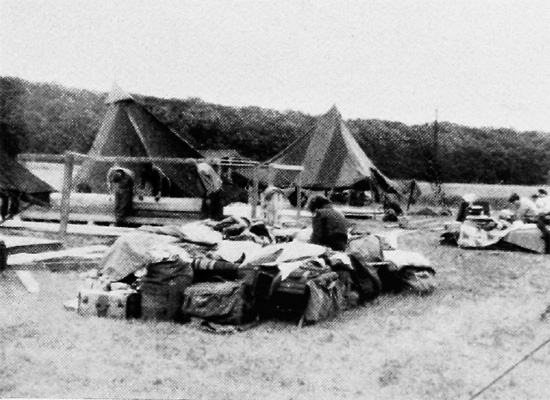
Engineers build wooden floors for the Nurses’ tents. Bad Nauheim, Germany, 10 June 1945.
Laboratory Tests – 41st Evacuation Hospital The Laboratory performed a total of 1,787 multiple tests while at Dorsten. The Pharmacy filled 501 regular prescriptions, 103 narcotic prescriptions, issued 280 units of whole blood and 165,000,000 units of penicillin. The Dispensary treated 1,311 out-patients, gave 89 general innoculations, 40 typhoid ones, and 30 typhus shots. There were 247 monthly physical examinations and 30 food handlers examinations.
While the 41st was located at Dorsten, the American Red Cross was temporarily set up in tents, but the following day, it was decided to locate it in more comfortable quarters. A barn adjacent to the hospital area was selected, but it needed considerable cleaning and improving before it could be used for a good purpose. A detail was secured from the 501st Medical Collecting Company and one from the 571st Motor Ambulance Company; these men, with the aid of Miss W. Blake and Miss K. Sanborn, pitched hay, made bins for grain, and scrubbed down the floors and walls. After this necessary work was completed, supplies and furniture were moved into place. On one end, the barn was converted into a lounge, another corner was reserved for active games such as ping-pong, darts, and indoor horse shoes, and still a third corner for all the available musical instruments. There was a section set aside for various types of crafts which proved tremendously popular with both convalescing patients and hospital personnel alike. A small room in the loft was taken over by Special Services and converted into a card den. Old tools were cleared out of the space beneath the card den, and this served as a storage place for supplies, as well as an office for the ARC workers. There was ample wall space which took care of all the favorite pin-up girls and the many maps collected over a period of time. All in all, this setup was the most satisfactory one so far, as there was ample room to handle all the patients, the Detachment and the many visitors, the privacy of an office for interviews, and space for supplies. Later, the ARC workers felt that distribution of comfort articles was not being properly handled. As it became impossible for a worker to get out on the wards every morning to distribute them to the patients herself, the Commanding Officer issued a memorandum outlining the procedure to be followed in the future, and a much more successful system was initiated. After some little time, and with the cooperation of the American Red Cross and the Military Government, a sufficient number of radios were secured to cover each hospital ward. A radio was something that the patients on the wards appreciated more than any other single factor and, in everyone’s opinion, radios should have been issued long ago.
Stations – Germany – 41st Evacuation Hospital
Rheydt – 4 March 1945 > 2 April 1945
Dorsten – 4 April 1945 > 26 April 1945
Stederdorf – 27 April 1945 > 9 June 1945
Bad Nauheim – 9 August 1945 > 19 August 1945
Marburg – 1 September 1945 > 17 September 1945
Other activities …
Following the festivities around VE-Day, conflicting orders were received on 9 May 1945 with reference to another impending move, upon which Lieutenant Colonel Van Buren O. Hammett and Captain William A. Greene, Jr. left to go to the vicinity of Iserlohn, Germany, in the Ruhr Valley, to secure proper billeting facilities for the unit.
The 41st Evac was ordered to take over administrative control of twenty PW and PWX Hospitals in the vicinity of Iserlohn, Germany, starting 12 May 1945. Consequently a number of Officers and Enlisted Men were placed on TD at the different Hospital Sections.
Iserlohn Hospitals (PW – PWX – DP Sections)
Alexanderhöhe – Iserlohn – PW – capacity 248
Argonne Barracks – Iserlohn – PW – capacity 1,300
Bethanien Hospital – PW + Civilians – capacity 167
Elizabeth – Iserlohn – PW – capacity 240
Jugendherberge – Iserlohn – PWX – capacity 57
Offiziersheim – Iserlohn – PW – capacity 100
Waisenhaus – Iserlohn – PW – capacity 155
Bismarck – Hemer – PW + PWX – capacity 210
Frontsport – Hemer – PW – capacity 100
Hindenburg Hospital – PWX – capacity 132
Parklager – Hemer – PWX – capacity 616
Garrison – Hemer – PW + PWX – capacity 370
Lyzeum – Menden – PW + PWX – capacity 222
Mission House – Menden – PW + PWX – capacity 281
St. Vincent – Menden – PW + Civilians – capacity 100
Hindenburg School – Letmathe – PWX – capacity 60
Marien – Letmathe – PW + PWX – capacity 420
Hohenlimburg – Letmathe – PW + Civilians + DP – capacity 200
Marien – Balve – PW + PWX – capacity 95
Ortslazarett – Ihmert – PW + PWX + DP – capacity 55
These Officers and EM were ordered out early on the morning of 10 May to proceed to their destinations. Prior to their departure from Stederdorf, Officers and Enlisted Men were thoroughly briefed on their duties. It was anticipated that this would be a difficult assignment, as very few of the Officers were acquainted with administrative reporting, supply procedure, and many of the other problems they were to deal with in their new jobs. The remainder of the unit moved in by infiltration on 11 and 12 May 1945. The unit’s CO assisted by Captain W. A. Greene had done a good job of billeting and had provided a block of the best houses in Iserlohn, completely furnished and with all utitilies, such as water, heat, and electricity intact. Fortunately, Iserlohn had suffered very little damage from bombing or artillery fire and proved to be a very nice place to live in for the period the organization was established there. So, all personnel not sent out as Hospital Administrators were billeted in Iserlohn.
Unit Headquarters was set up in a block of houses, and also acted as a Headquarters for coordinating the administration of the hospitals under its control. Iserlohn was centrally located in regard to all the hospitals and was convenient for the submission of reports, requisitions, mail delivery, picking up of supplies and rations. Some of the hospital departments functioned in new capacities. The Operating and Ward Section Officer personnel became Hospital Administrators, the Chief of Surgery was now Chief of the Operations Section and the Chief of Wards filled in as the Hospitalization Officer. The duties of the Hospital Commanders were somewhat difficult to define; in a general way, their job was to supervise the administration of the hospital as the representative of the US Army; to ensure the delivery of medical supplies, rations, coal, and other necessities; to ensure rendition of the required reports; to maintain discipline and to enforce the rules prescribed by higher headquarters; and to exercise a certain amount of supervision over the professional activities of the local German hospital staff.
The Medical Aidmen assigned to the various hospitals acted as assistants to the Hospital Commanders, and they supervised the work of the hospital personnel. In the unit’s Headquarters, the Hospitalization Officer attempted to regulate and coordinate all matter pertaining to the hospitalization of PW (Prisoners of War) and PWX personnel (RAMP, recovered and liberated soldiers of Allied Nations) within the district assigned to this unit. As the 41st was assigned control of twenty hospitals with a total bed capacity of approximately 5,200, this new job proved to be moderately harassing in its early stages, and especially so, because there were virtually no established procedures in effect at the time the organization took over. This assignment proved quite a problem for the Supply Department, as it was necessary to supply all the hospitals with captured German supplies and equipment (medical and other) only. However, a system was devised which was much better than the one used by other organizations doing similar work. It required less transportation, less personnel, and only a minimum of paperwork. The Supply Department operated as a small depot and clearing house; a large assembly tent was set up to receive, store, and ship all supplies and equipment for the hospitals. Entrance at one end was for receiving and the other end was for shipping. Instructions were given to personnel at each hospital in the preparation and submission of requisitions for expendable and non-expendable supplies. They were prepared by each hospital unit and submitted to the Medical Supply Officer. There, they were checked and approved, or disapproved. They were then given a voucher number, entered in the Supply Record Book, a copy detached for the Depot’s file, and then submitted to the 35th Medical Supply Depot for filling. Supplies were brought into the Receiving Section, sorted, checked, and then placed in the Shipping Section for the respective hospitals.
Hospital Commanders were informed when supplies were on hand for their hospital and to send necessary transportation to pick up same. When indicated, the Supply Department delivered supplies to the hospitals. The greatest supply problems were cleaning and preserving material and clothing for patients going to PW enclosures. To control these items and assure a fair distribution, Supply stocked these items in bulk and rationed them out on a percentage basis in proportion to the number of patients held in each hospital. Supplies were also secured through sources other than the Medical Depot. The Supply Department took over a German Wehrmacht Pharmacy in Iserlohn and filled prescriptions, drugs and pharmaceutical supply requisitions from there. Clothing was a constant problem and required regular phone calls, trips, and submission of requisitions. From the period 15 May 1945 to 2 June 1945, the Supply Department worked and filled 135 requisitions. Requisitions averaged from three to five pages in length. Other necessities were filled from stock, from the Pharmacy, and from other sources.
Unit Supply was set up in a ward tent and the Medical and Storage Supplies were all sorted in an additional ward tent. There was no Quartermaster Laundry available in the area and Supply finally located a civilian laundry operating under GI supervision, in Soest, Germany, which proved to be very satisfactory and provided excellent service with minimum rates. A dry-cleaning plant was also located in Iserlohn and a cleaning and pressing service was made available to the unit. The hospitals took care of their own laundry.
Each Hospital under American supervision had to submit a daily Combat Medical Statistical Report, a weekly Report of Hospital Personnel and a weekly Status Report. All reports were submitted to the Registrar’s Office where they were checked and typed for submission to higher headquarters. The hospital units were divided equally among the personnel of the Registrar’s Office so that each man had his own set of hospital reports to type. This made it easy to keep up with all of the various little details that each hospital could have had and also made it less strenuous to add corrections on the reports. All of the other weekly reports were completed in the Registrar’s Office from the daily information submitted on the back of the combat medical statistical report. In addition to the above way of reporting, there was a Report submitted every ten days on the German Army Medical Units operating the hospitals. This report was related to the equipment that they had on hand and the personnel present for duty. While at Iserlohn, a physical inventory was conducted by each department and the completed inventories were submitted to the Supply Department for checking, consolidating, and initiating of any necessary Survey Reports.
Chaplain William H. Barsh held conferences with PW Chaplains and discussed with them some of the many problems arising out of their work, and through the German Chaplains, distributed some 125 New Testaments and Gospels written in German. For the staff, regular weekly worship services were provided for all faiths. A German Chapel near the area was made available for the services of all groups, both American and German.

Bad Nauheim, Germany, Wedding ceremony June 1945. From L to R: Chaplain Clyde J. Verheyden, ChC; Second Lieutenant Jack D. Wallace, MAC; First Lieutenant Mary E. Brown, ANC; First Lieutenant Betty J. Hindman, ANC; First Lieutenant William V. Ivery, MAC; and Colonel Joe Harrell, MC (CO).
Regular contact was provided between the Chaplain and the staff through the various conferences, visits and group discussion gatherings. Second Lieutenant Winifred M. Briggs, ANC, was still on leave in the United States on VE-Day and was dropped as a member of the unit on 13 May. Second Lieutenant Agatha M. Schiller was assigned on 30 May to replace her. Second Lieutenants Smith and Theobald, who had been on DS with the 41st from the 63d Field Hospital returned to their unit 18 May 1945. They had been with the unit since 1 March. Special Services and the American Red Cross took over a house and set up two floors. On the first floor they had offices, reading room, lounge and kitchen and on the second floor a music room, card den and kitchen. The latter was later converted into a craft shop. A dark room and sleeping quarters took care of the third floor. With the cooperation of the Allied Military Government the ARC was able to obtain furniture to furnish the house attractively and comfortably. A small lawn behind the house was used to set up a ping-pong table, several card tables and lawn chairs.
A formation was held on 24 May 1945 to award the Meritorious Service Unit Plaque to the organization and the Bronze Star Medal to Lieutenant Colonel Clinton E. Adams, Major Bernard M. Halbstein, and Staff Sergeant Wardell A. Rogers for their outstanding service. Memorial Day was observed by the organization joining forces with the 75th Infantry Division in a parade through Iserlohn and a mass formation at which a rifle salute was given. 30 Nurses, 3 Officers and 60 Enlisted Men participated in this ceremony. With the end of the war in Europe coming during the early part of May, the end of the month found the Headquarters Department making reports required by the Readjustment and Redeployment regulations. The personnel was swamped with Adjusted Service Rating Cards and related reports. The Personnel Department received the valuable addition of Corporal William M. Flanagan, formerly of the Receiving and Evacuation Section of the Hospital.
This once again brought the Department up to T/O strength and eased the work formerly carried out by Staff Sergeant W. A. Rogers and Sergeant Maurice S. Sheehy. In a matter of days the Personnel Department got to the point where they once again could see over the stacks of regulations and submitted required records and reports with dispatch. The accuracy of these came unoffically from the clerk who accepted the bulk of them at the MRU in the remark “at last we have received some correct (reports) ones.” The average Adjusted Service Rating point score for the organization was found to be 68.4 with another bronze campaign star to be added.
With the appointment of the Chaplain as Officer in charge of the athletic program an active series of softball games was provided. Several ball games were played and the unit won all but one (the loss was to a Medical Collecting Company who had a very good team).
As the month of June 1945 opened, the Hospital was prepared to release the control of the PW and PWX Hospitals to the British, who were moving in to occupy the sector as agreed by the overall Allied Occupation plan set up at the various conferences held during the war. On 3 June 1945 the personnel was withdrawn and billeted in the unit area. This crowded things a bit, but was still better than being out having to live in tents.
Special Services held movies approximately three times each week and, as usual, they were well attended. The ARC staff continued “The Cocoa Hour” every night for patients as well as hospital personnel. The 29th Infantry Division Band organized a jazz concert outdoors behind the non-transportable wards, and benches were set up for ambulatory patients and duty personnel. They played for an hour and were very well received. After the concert, lemonade was served to all comers.
Several loans were made to men for leaves granted before pay day was due. Several loan repayments were accepted from both patients and unit personnel. Toward the end of the month, one of the workers made a trip to a captured German warehouse and brought back such items as cigars, hair oil, mirrors, wrapping paper and so forth. The popularity of the cigars and hair oil, with both patients and personnel, alone made the trip worthwhile. The operation of the Hospital at Dorsten proved to be a busy one for the Supply Department. As the troops ahead had been moving so rapidly the depots had either been left far behind, or had been moved so far ahead that it was necessary to travel long distances both forward and to the rear for many of the items that were found necessary. However, very few, if any, difficulties were actually insurmountable and the work went along smoothly. The Supply Department had been getting numerous complaints from the Operating and Ward Sections on Abott’s Blood Plasma, 500cc packages (Chicago, Illinois –ed). First Lieutenant John W. Burrell attempted, time and time again, to make an exchange at the Medical Depot for plasma of another manufacturer. Through various means, he was able to keep the stock of that brand as low as possible, but it was still necessary to take some and issue it to the wards. During the month, VO were received from Colonel Smith, Surgical Consultant, Ninth US Army, to turn in all the stocks of Abott’s and no time was lost in doing so, in addition to submitting requisitions for a supply of 500cc plasma cans other than Abott’s. The hospital linen was handled by the 550th Quartermaster Laundry Company during the unit’s stay at Dorsten, Germany. A letter of commendation for their excellent services was sent to their Commanding Officer.
Statistics of the X-Ray Department once more reflected the amount of out-patient work done by the Dispensary and much of their work required chest X-Rays on applicants for battlefield commissions. A total of 344 examinations were conducted, out of a total of 1,636 X-Ray examinations completed during the month. In all, the number of films used at Dorsten was 3,219. A mobile X-Ray unit was attached to the 41st Evac for a short period and relieved the own personnel from a lot of routine work. No other unusual problems arose during this period of activity.
Unit transportation once more spent a greater part of the month away from the outfit, moving other units. All of the first and second echelon inspections normally required could not be performed because of the absence of the unit’s organic vehicles, but under the existing circumstances, the Transportation Department did their utmost to keep each vehicle in top operating condition. There was one accident during the month. The vehicle was turned in to salvage and a replacement obtained. This accident was the second major one since being stationed in the European Theater of Operations. There were 91,000 gallons of water hauled for the Hospital, at Dorsten. The amount of water used and the distance of the water points from the hospital caused quite a hardship on truck and driver. Technician 5th Grade Theodore R. Brodt necessarily worked many hours overtime because of this. The Nurses proved to be the lucky people this time when leaves were authorized. Lieutenants DeVilbiss and Duley were selected to go to the French Riviera for seven days. They returned with glowing reports, after flying both ways. ANC First Lieutenants H. Schreiber and G. E. Patenaude returned to England on a 7-day leave and First Lieutenants E. A. Phillips and E. Thorpe visited Brussels on 3-day passes.
The work in the Dental Clinic for the first fourteen days of the month consisted mainly of emergency cases, such as extractions and fillings. During the latter part of the organization’s stay at Dorsten the number of out-patients increased, as is usual when the fighting slackens. A large number of X-Rays were taken, especially in the latter part of the month. The semi-annual personnel check was made and more work was found than was anticipated, but it was completed by 26 April, before orders to close down were received.
A well-rounded program of religious activity was carried out by the Chaplain during the month of April. A bedside contact was made with every patient coming through the facility, accompanied by prayers and a spiritual ministry which gave courage and confidence to the patients. There were 3,847 such contacts during the month, with religious literature provided when needed. Fifteen letters of condolences were written and twenty-seven letters for patients to parents and families. No patient was ever without attention from the spiritual side. This was accomplished by calling in Chaplains of other faiths to minister to their own groups and denominations. In total 13 religious worship services were provided and attended by approximately one thousand worshipers. A regular contact was provided between the Chaplain and the unit’s staff through counseling, recreation, and visits to Enlisted Men’s and Officers’ areas daily.
No unusual problems were encountered by the Utilities Department in this location. All wiring was dismantled prior to the move from Rheydt. At Dorsten, underground cable was used from the generators to the central distributing box. This eliminated setting up poles for overhead wire and stringing of about two thousand feet of wire. The Receiving Department, always trying to render a better, faster, and more efficient service, re-arranged the interior of their tents in order to obtain better use of the available space and more nearly obtain a perfect procedure of receiving and evacuating patients. The change was thought to be most satisfactory after considerable trail was made of it. An improvised wash stand was set up not only to insure cleanliness of personnel while handling patients, but also to aid them in their daily appearance as well.
Valuables left behind by patients who had been evacuated were turned in to the Effects Quartermaster, Personal Effects Section, on 6 and 24 April. During this period of operations, six bags of valuables were left behind.
One of the features of the operation at Dorsten that “griped” everyone was the poor mail service. Postal service had been transferred to a rear echelon APO since the original APO had moved almost beyond reach. This delayed the mail for about three days. The transfer from XIX Corps to XVI Corps didn’t help matters either, and snarled up the Message Center just that much more. Finally, it became necessary to use the unit’s own messenger and own postal run to maintain daily mail service.
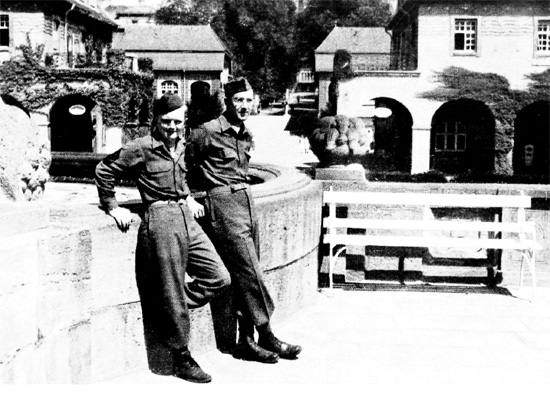
Leisure time, Bad Nauheim, Germany, August 1945. From L to R: Technical Sergeant James W. Jotin and Private Norman Jesser at the “Sprüdel” fountain.
The 41st Evacuation Hospital officially closed its function at Dorsten, Germany, on 26 April 1945, and the billeting party was sent out once more in search of a new site. The new orders indicated that the unit was to be attached to XVIII Airborne Corps, which made it the third Army Corps that it would function under within one month, the others being XIX and XVI Corps.
A Memorial Service honoring President Franklin Delano Roosevelt (died 12 Apr 45 –ed) was held in the American Red Cross building at 1600 hours, 26 April 1945. The Introductory remarks were made by Colonel Joe Harrell, Commanding Officer, and this was followed by the singing of “America” by all personnel. The scripture and prayer were said by Chaplain Roy Bradley (Colonel), Chief Chaplain, Ninth United States Army. After the scripture and prayers, Technician 4th Grade Geist sang “Home on the Range” accompanied on the piano by Sergeant Codd, both from the Chaplain’s Office. The chief address was given by Lieutenant Colonel John P. Oliver, Assistant Judge Advocate General, XVI Corps. At the conclusion of the address everyone joined in and sang “God Bless America.”
A recapitulation by the Registrar’s Office revealed the following statistics pertaining to operations in this area. The total number of admissions for the period was 1,651, broken down as follows: 513 disease; 403 injury; 576 wounds; 32 Allied troops, 87 Prisoners of War and 40 civilians.
On 26 April, the Hospital closed for operations and once more prepared to move forward. The move ahead was evidently going to be a long one for by this time American troops were on the Elbe River, which was well over two hundred miles ahead of the present location. The billeting party was sent out with “sealed orders” and much secrecy prevailed as to the next location or assignment. 27 April the tents were struck and loaded immediately – don’t say it, you guessed it – it rained as usual, just to make things normal for the 41st. Left behind, at the time of movement, was a holding unit whose mission was to care for the non-transportable patients until such time as they could be properly transferred to ComZ Hospitals. Captain Truxton Jackson was the Officer in charge and he was assisted by 4 Enlisted Technicians from the Ward Section; Technician 4th Grade H. M. Mattern, Corporals D. F. MacLean and V. A. Ernster and Private First Class L. A. Tuenge. Private First Class E. L. Hampton of the Mess Department and Technician 5th Grade J. R. Van Bergen of the Registrar’s Department also remained behind. Lieutenant Colonel G. R. Benton, Chief of Surgery, was left as a patient and was evacuated to Paris by air several days after the organization’s departure.
Upon leaving Dorsten for the next location, hardly anyone knew just where they were going. There were rumors that the men were to support an invasion into Norway. Only those that needed the information for the proper performance of their duties were told of the ultimate destination.
However, after a long ride of two hundred and twenty-five miles, the 41st found themselves in a Concentration Area in the vicinity of Stederdorf, Germany, awaiting for assignment to a mission which in itself was highly classified. At this time, the Hospital was attached to XVIII Airborne Corps. On arrival there, no particular assignment had been received, so staff and personnel set up a bivouac area, and left as many of the trucks loaded as possible. Later, it was revealed that this Corps had the assignment of pushing north across the Elbe, southeast of Hamburg to the Baltic Sea. By 1 May 1945, United States Forces had reached their objectives and linked up with Soviet Russian Forces. Ninth US Army had already reached its assigned objective when it arrived on the Elbe River. With the exception of a small sector in the area southeast of Hamburg, there was little, if any, further activity on the Ninth Army front. XVIII Airborne Corps held this sector and proceeded to clear it quickly, meeting only slight enemy resistance. Casualties were very light, and a general feeling that the “end” was near prevailed. First US Army held the area south of the Ninth Army, and their front was static along the Elbe River. Third Army was pushing toward Prague, Czechoslovakia, and was meeting some resistance. Seventh US Army was holding the line south of Patton’s forces and waiting for a possible next move, as were almost all American units in the region.
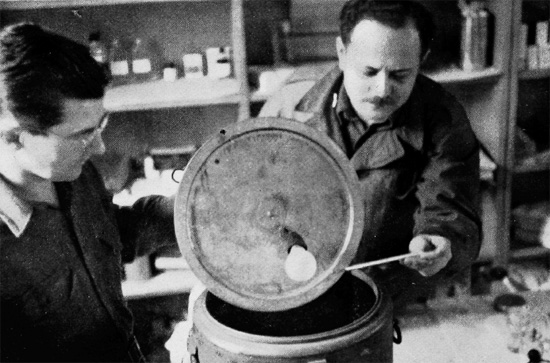
Laboratory Section staff Sergeant Herbert M. Haskell and Captain Lester E. Shapiro check the temperature inside a marmite (food) container.
After the northern sector had been cleared with only light casualties, the rumors of surrender were to be heard on every tongue. On 4-5 May, enemy troops in Northern Germany capitulated (surrender signed at Lüneburg 4 May 45 –ed). On 7 May 1945, the unconditional surrender of the German Forces was signed at Reims, France, in presence of the Allied leaders. V-E Day was proclaimed 8 May 1945 and observed by both prayer and celebration. Victory was received quietly by most troops in the sector as the cease-fire order had been given one day earlier on 7 May and the actual surrender was a sort of anti-climax to everyone. The sudden disintegration of the German High Command after Hitler’s unconfirmed death was somewhat surprising. There was very little done to maintain the previous fanatical devotion to the leader of the Third Reich. Admiral Karl Dönitz and the other members who had assumed further control of the German State seemed only concerned with the chances of saving their own skins, rather than the Nazi party. Suicides were numerous, as capture often could result in proceedings for potential trial as war criminals for many of them.
The unit spent the first two weeks of May in bivouac at Stederdorf, but the principal occupation there was just resting, or trying to keep busy with some form of recreation activities. Hunting became very popular and at one time, an organized deer hunt was conducted under the supervision of those experts such as Major James G. Bogle and Captain Robert E. Eby. It was very successful and enough venison was procured to supply the entire unit with some excellent food.
American Red Cross and Special Services set up in double tents placed side by side. The furnishings were plentiful, but not comfortable. They consisted of supply boxes, large and small, and several dilapidated card tables. However, they served their purpose as a day room for the men and many others in addition, as they often had to accommodate a number of guests.
Special Services held movies in the tent every night; then the guards took over, and it served as a guard house until morning. All in all, the ARC was never empty, nor the workers at a loss for things to do during the stay in this area.
The time spent at Stederdorf, Germany, was not without its social occasions. A V-E Day party for the Officers and Nurses was held in the Officers’ recreation tent. There was nothing but a dirt floor and dancing was not anticipated, but the lively music was too much for itchy feet and a real dance resulted, which was enjoyed by all. To complete the evening Major Arthur Post took several group pictures. The best to do for the Enlisted Men was a stag party with beer, donuts and coffee in the recreation tent. In this location, as had been the case at Dorsten, mail call proved to be quite a problem. The mail was picked up at a rear echelon APO in Münster, and since it was a two-day run, the influx of mail was most discouraging. An APO opened in Braunschweig at “Conquer” Forward (Ninth US Army advance Headquarters –ed) and this certainly represented better service. Lieutenant Colonel George R. Benton returned to the unit from the General Hospital in Paris and once again resumed his duties as Chief of Surgery. Captain Edward J. Hammerbacher was promoted to the rank of Major as of 1 May 1945.
| Staff – 41st Evacuation Hospital (1945) | |
| Commanding Officer | Colonel Joe Harrell, MC |
| Executive Officer | Lieutenant Colonel Clinton E. Adams, MC |
| Adjutant & Personnel Officer | Major Edward J. Hammerbacher, MAC |
| Chief Operative Section | Lieutenant Colonel George R. Benton, Jr., MAC |
| Chief Ward Section | Lieutenant Colonel Van Buren O. Hammett, MC |
| Chief X-Ray Section | Major Arthur Post, MC |
| Chief Dental Section | Major Frank R. Pittman, DC |
| Chief Laboratory & Pharmacy | Captain Lester E. Shapiro, MC |
| Receiving & Evacuation Officer | Captain Glenn F. Palmer, MC |
| Principal Chief Nurse | Captain Jeannette E. Potter, ANC |
| Registrar | Captain Allen L. Allion, MAC |
| Assistant Registrar | Warrant Officer Junior Grade Albert Kuhlmann |
| Chaplain | Captain William H. Barsh, ChC |
| Chaplain | Captain Clyde J. Verheyden, ChC |
| Supply Officer | First Lieutenant Henry E. Zeranski, MAC |
| Detachment Commander | First Lieutenant Howard E. Thompson, MAC |
| Mess Officer | First Lieutenant Jack D. Wallace, MAC |
| Transportation Officer | First Lieutenant William V. Ivery |
(staff personnel changes are not included)
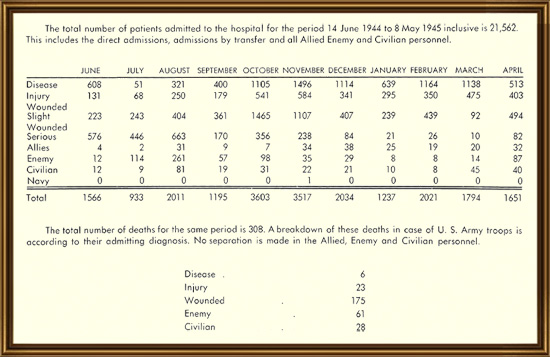
Statistics – patients received at the 41st Evacuation Hospital.
Finale:
Orders were received to move the unit to a medical concentration area north of Frankfurt-on-Main. The final elements moved on 9 June 1945, and joined the majority of the unit already in bivouac in a field five to six miles north of Bad Nauheim, Germany. The area was a large field. The Headquarters row was set up near the road in the usual manner while the remainder of the departments used plenty of space and adequate tentage to set up, or store, their equipment. Bad Nauheim was a town of some size with ample recreation facilities, such as an ARC club, a theater, a swimming pool and tennis courts for the personnel. Some shops were “On Limits” and gave the men an opportunity to purchase a few trinkets.
The 41st Evac was transferred from Ninth US Army to Seventh United States Army, on 15 June 1945. This caused new unit files to be set up and changes in MRU (Machine Records Unit –ed) and Finance offices. While the organization was in Iserlohn, it had said goodbye to Captain Truxton Jackson, who left to go to the 118th Evacuation Hospital, and to First Lieutenant Margith H. Heide, and Second Lieutenant Ida M. Walker who left to join the 5th Auxiliary Surgical Group, both being CBI-bound units. The unit welcomed Lieutenants Cecilia T. Garvin, and Louise T. Curcio, who joined from the 5th Auxiliary Surgical Group. Technician 4th Grade George L. Der and Staff Sergeant Arthur W. James were transferred to the 18th Replacement Depot for return to the Zone of Interior and discharge. Leaves and furloughs were granted in the new area. For many of the personnel these were the first leaves in two years. Officers, Nurses and Enlisted Men went to the French Riviera, England, Italy, Paris, Egypt, and a quota went to Switzerland. June was the month of orange blossoms and also of the brides, and the 41st had two brides; Lieutenant Betty Tubridy married Captain John Kelly of the 1st Infantry Division; and Lieutenant Betty J. Hindman and Lieutenant William V. Ivey, both of this unit, were married in Bad Nauheim by Chaplain Clyde J. Verheyden. First Lieutenant Betty Tubridy and Major J. Kelly were married near Cologne, Germany. Getting settled in tents again, after the luxury of living in a house with electric light and bath, was a bit difficult, although living under canvas was far from being uncomfortable. Engineers, under the direction of Major Warren, a brother of one of the unit’s Nurses, built floors and side walls for the many tents, graveled roads, made seats and a stage for the theater, a boxing ring, backstops for the baseball diamonds, bridges across the creeks, floors for the recreation halls, and generally made the camp very comfortable.
An athletic program and classes in photography and developing were put into operation. Classes in markmanship were held, and a number of Officers, Nurses and EM attended these instruction periods. Major Frank R. Pittman and Technician 4th Grade Donald F. Willsey went on DS with the 739th Field Artillery Battalion for a week. Most of the Departments of the Hospital were busy during the month of June with inventories and repairs. The Motor Pool had difficulty in obtaining the necessary parts for repairing some of its vehicles. The Operative Section inventory revealed very few shortages, and all equipment was serviced and put in condition for possible future function. Ward equipment, after inventory, was stored in tents.
June 1945 proved to be a busy month for the Dispensary. Captain Lester E. Shapiro submitted his reports as follows:
Dispensary Activities – 41st Evacuation Hospital
288 patients treated
200 physical examinations performed
5 civilian employees examined
The American Red Cross did its usual good work during the month. The furniture for the ARC tent became a splash of color, due to the efforts of Miss Willa Blake and Private First Class James H. Johnson. Every effort was made to keep the Enlisted Men’s spare time occupied. Coffee and donuts and GI shows, as well as nightly movies by the Special Service, helped pass the time.
July found the organization -as June left it- still in the field, and in tents. This became the month of farewells. Parts of the big family began to leave for other units, either to CBI-bound outfits or to Category IV units headed for the United States. On 7 July 1945, the personnel sang “Auld Lang Syne” to Majors E. J. Hammerbacker, W. W. McCook, F. R. Pittman, A. Post and J. J. Reardon; Captains A. L. Allion, M. F. Axthelm, C. R. Solbrig, G. L. Wadsworth, B. B. Wetchler, J. T. Williams, and H. B. Hutt; First Lieutenants W. V. Ivery, B. J. Hindman, E. C. Hogan, M. L. Middleton, G. E. Patenaude, B. Tubridy, M. E. Twamley, and A. M. Schiller; First Sergeant M. P. Telehany, Technical Sergeants P. Gentile, W. E. Messner and J. F. McKenna; Staff Sergeants J. A. Capute and J. Meier; Technicians 3d Grade W. W. Hose, W. T. McDuff Jr., including First Sergeant W. D. Roux and Staff Sergeant C. Podolak; Technicians 4th Grade G. W.Bixler Jr., J. DiNapoli and K. L. Stephens; Technicians 5th Grade S. Cuccinello, H. L. Eaton and H. K. Strey, as well as Staff Sergeant E. D. Bielenin; Corporals R. Shapiro and E. A. Van Sickel; Privates First Class J. Fineday, J. Pelerin and R. R. Sampson. All of these left to join the 103d Evacuation Hospital, a Category IV unit. Further losses involved Major James G. Bogle and Captain George Bush at this time, both of whom flew back to the ZI.
The 41st family grew still smaller when First Lieutenant Florence E. Thompson, Second Lieutenant Virginia Thomas, Privates First Class Leslie L. Jones, William N. Mote, Carl W. Nelson and Wayne W. Rathbone left for the 114th Evacuation Hospital.
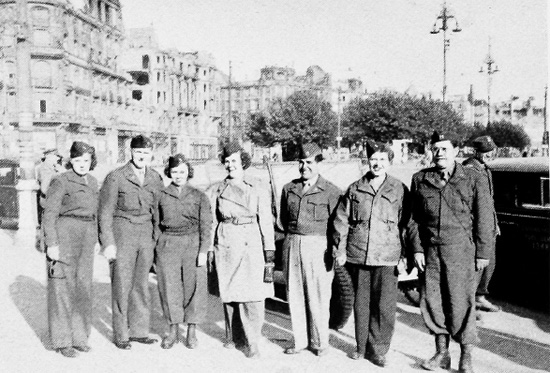
Enjoying some free time somewhere in the European Theater. From L to R: Second Lieutenant Virginia R. Thompson (ANC); Captain Martin J. Rucker (MC); First Lieutenant Connie A. Snape (ANC); First Lieutenant Julia R. Blandford (ANC); Captain Richard T. Milazzo (MC); First Lieutenant Alice M. Radigan (ANC); and Captain Milton F. Axthelm (MC).
Major Ernest H. Wallace, MAC joined the unit and became the new Executive Officer on 4 July 1945, coming from the 31st Medical Group. On 24 July 1945, Staff Sergeant Emanuel A. Zahner, Technician 5th Grade Frank J. Gauldin, Technician 3d Grade Robert L. Haldeman and Technician 3d Grade Merle E. Berry joined the organization from the 448th Medical Collecting Company. Privates First Class Carl W. Mueggenburg, Willard L. Wyatt, Vincent J. Ahearn, Hugh R. Culton, Chester M. Pierson and Grady Wilkins joined from the 566th Motor Ambulance Company. Private Wilfrid M. Cotter, Technician 4th Grade Mike A. Soltis, Technician 5th Grade Walter R. Popp, Technician 4th Grade Darwin L. Fisher, Privates First Class John R. Henderson, Joe P. Hofer; Technician 5th Grade Walter B. Guest were transferred from the 445th Medical Collecting Company.
The unit still lived under tentage in the field at the end of the month, but it represented now only a mere “skeleton” of the former organization. Everybody was thinking about his own turn to go home, and disliked the idea of leaving the many friends made during the time spent with the 41st. Those remaining in the unit passed the time as best they could, either attending classes, engaging in athletics, taking sunbaths, or going on tours, passes and leaves to Munich, Heidelberg, Chamonix, the French Riviera, Italy, Brussels, Maastricht or England.
The 41st left its summer camp at Bad Nauheim the latter part of August, 1945 and eventually moved into the permanent barracks of the Tannenberg Kaserne at Marburg, with orders to take over and operate the Hospital already there for US troops.
The move was made by shuttle over a period of several days, and by the end of the month the unit was well housed and settled in one large four-story barracks stone building, with adequate space for day rooms, offices and quarters. Some of the Nurses were billeted in the hospital building, some in the building provided for the Nurses of the 102d Evacuation Hospital, while some others were quartered in the same building as the remainder of the unit. On 1 September the hospital installations were officially taken over from the 102d Evac, along with about 75% of their equipment, as this seemed the only practical way of making the change, and in view of the fact that the 102d would no longer need their hospital equipment. The hospital itself consisted of one four-story stone building, sufficiently large to house at least 350 patients, as well as all the offices, clinics and different departments required for operation of the hospital.
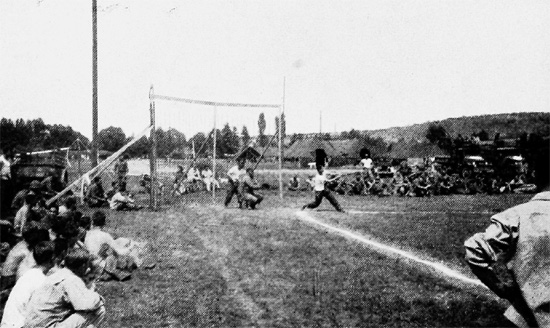
Action shot taken during the baseball game between the 41st and 105th Evacuation Hospitals at Bad Nauheim, Germany.
There were sufficient electricity, water, plumbing and latrine facilities, although some water had to be hauled initially. There were numerous out-buildings, in good condition, adequate for Supply, Mess, Transportation and the Post Exchange. The Motor Pool was probably the best one that department ever had, and the men went right to work fixing it up. On taking over the premises there was lots of work to be done in order to put things in shape, and everyone went to work with a will, glad to have something to do again. It was apparent that the Nurses and Enlisted Men were tired of doing nothing over a period of two months, and they tore the place to pieces getting it in order, but when they had finished things looked really bright and shiny. There was a daily average of 185 patients in the hospital during the month, with a big out-patient service. The majority of the admissions were medical cases, as was to be expected. Most of the operative cases were results of fights, vehicle accidents, and acute abdominal conditions. A number of drunks were taken care of, also. The turnover of patients was slow, as a 120-day evacuation policy was in effect, but the 41st Evac Hosp census did not increase appreciably. The advance party of the 280th Station Hospital arrived during the first week of September 1945 and the main body arrived a few days later, being commanded by Lieutenant Colonel James E. Watson, MC. The unit had orders to take over and operate the hospital, but they were to be a part of the Army of Occupation. There being no particular hurry, it was agreed that the hospital would change hands about 23 September. In the meantime, word was received that all of the 41st Nurses and about fifty of the EM men were to be transferred to units leaving for the Zone of Interior prior to 23 September; so, by excellent cooperation between the two units involved, the change was made on 17 September, instead. The 280th Sta Hosp took over all of the equipment the 41st had received from the 102d Evac, which made the physical transfer comparatively easy. This seemed like a lot of changes (and it was) and it would appear that nothing but confusion would result; but such was not the case, and the patients continued to receive the best of care during the period. At one time there were 3 different hospital units billeted in the various buildings of the Kaserne, sharing messing facilities, store rooms and quarters with one another, but there was little or no friction, because all concerned realized that it was a matter of necessity and that the crowded condition would soon be over.
During the week of 17 October, 1 Medical Officer (Major Ernest H. Wallace), 23 Nurses and approximately 50 Enlisted Men (many key noncoms) were transferred to the 102d Evacuation Hospital and left with that unit for the Assembly Area at Rheims, France three days later. This left only 3 Nurses in the 41st Evac, and a week later they, too, were transferred to units scheduled for return to the United States at later dates.
Beginning on 15 October and continuing through 23 October 1945, high-point Medical Officers were ordered out of the unit, flown from Frankfurt to Paris and from Paris to the States. This list included some of the old timers in the unit, as Lieutenant Colonel G. R. Benton, Captains G. F. Palmer, J. J. Malee, and R. T. Milazzo. Captain L. E. Shapiro was transferred to the 1st Medical Laboratory; Colonel Joe Harrell to the Theater General Board at Bad Nauheim; Captains S. S. Fajans and J. Carp to a Medical Clearing Company; Captain W. P. Gaynor and Mr. A. W. Kuhlman to the 24th Evacuation Hospital; Lieutenant J. W. Burrell to the 241st Medical Battalion and Major J. M. Mayer to the 280th Station Hospital.
These transfers were initiated by the Seventh US Army Surgeon, in preparing the unit for return to the ZI on or about 10 October 1945. Regular Army Officers were frozen in the Theater, so a new Commanding Officer had to be selected to replace Colonel Joe Harrell, who had commanded the 41st Evacuation Hospital for something like over three years. Lieutenant Colonel Van Buren O. Hammett was selected for this job, being the senior Medical Officer in the unit. All high-point Medical Officers were removed from the unit and flown home; low-point Officers, Nurses and Enlisted Men were transferred to units scheduled to move at later dates. When these transfers were completed the 41st was no longer the 41st Evac, except in name, and this fact left most of the old members of the outfit with a feeling that they had not been treated right, and that they should have all been allowed to return to the Zone of Interior as one unit. Everyone believed this would have been better than the way it was done, and it would surely have been a more efficient way of doing it. The unit was filled back to strength during the first week in October with approximately 6 Officers, 50 Nurses, and 100 EM. There were no further transfers after this, as the unit had by this time been well screened and everybody then with the unit was eligible for return to the States with it. These switches resulted in considerable confusion and dissatisfaction, but the 41st was probably better off than a majority of the units. This change did allow for the promotion of a number of Enlisted personnel to higher grades, and no time was wasted in taking advantage of the opportunity. There were a number of deserving men in the unit who had been held down by the lack of vacancies in the higher grades, and they were very happy about their promotions.
Numerous parties took place in September for the Enlisted Men, Officers and Nurses, alike. The men had a beer party and buffet supper for the ones leaving with the 102d Evac, while the Officers and Nurses had a dance at the Allied Officers’ Club, near Marburg. This was a very nice affair, and well attended by guest from the 102d Evac and the 280th Sta, as well as from the 3d Reinforcement Depot. Then, the Officers and Nurses held a private 41st party, and there is nothing else in the books to compare with a “41st Party.” This was a particularly good one, except for the thought that it would be the last one of its kind.
The last few weeks on the continent saw several weddings in the units. Staff Sergeant Louis R. Feeney and Miss Willa Blake, ARC worker, were married in the Church in Marburg by Chaplain Clyde J. Verheyden, with most of the unit present. It was a very pretty affair, pictures were taken of the wedding party afterwards, and the car in which they departed was well decorated. Then, Major William A. Greene, Jr. and Miss Kay Sanborn, the other ARC worker, were married in the same church on 2 October, with the Chaplain in charge, and only a few close friends present. Colonel Joe Harrell gave the bride away on both occasions. This wedding ended a series of marriages in the unit, the others being: Lieutenants Howard E. Thompson and Helen E. Callesen; William V. Ivery and Betty J. Hindman; Agatha M. Schiller and Lieutenant Guthrie; Lieutenant Betty Tubridy and Major Kelley; Betty A. Harris and Edward Waldron; Jack D. Wallace and Phyllis H. Richardson, and a few others.
The remaining days of the unit on the Continent of Europe were destined to be busy ones, what with the shifting of personnel, turning in of property, mailing of excess personal items home, and getting things in order to pass the inspections at the staging areas; but, for some reason or other, nobody seemed to mind a little extra work, or inconvenience; it must have been because they were going home and nothing could dampen their spirits.
The 41st was now scheduled to leave for the Assembly Area at Reims, France on 1 November, and to sail for the United States on or about 20 November 1945. On arrival there, the unit was to be demobilized, and the activities of the 41st Evac brought to an end…

Technician 5th Grade Joseph R. Van Bergen in front of the 41st Evacuation Hospital sign.
Roster (incomplete):
41st Evacuation Hospital (SM) Roster
The following lists of Officers, Nurses, Enlisted men and American Red Cross workers includes every member of staff or personnel assigned to the 41st Evac, at one time or another, since its activation and includes the names of everyone who was with the unit during the period of combat function in Europe from 6 June 1944 to 8 May 1945 (some ranks however are missing).
| Officers: | ||
| Ackerman, Andrew J., MAC, First Lieutenant | Guthrie, MC, First Lieutenant | Rabban, Meyer, MC, Second Lieutenant |
| Adams, Clinton, E., MC, Lieutenant Colonel | Halbstein Bernard M., MC, Major | Rankow, Robin M., DC, Major |
| Alfano, Nicholas F., MC, Captain | Hammerbacher, Edward J., MAC, Major | Reardon, James J., MC, Major |
| Allion, Allen L., MAC, Captain | Hammett, Van Buren O., MC, Lieutenant Colonel | Rein, Robert L., MC, First Lieutenant |
| Alpert, Harry L., MC, Major | Harrel, Joe, MC, Colonel | Rose, Donald L., MC, First Lieutenant |
| Angen, Willard F., MC, Captain | Haynes, MC, Major | Rucker, Martin J., MC, Captain |
| Axthelm, Milton F., MC, Captain | Helms, Jacob, MC, Major | Rudd, Joel W., MAC, First Lieutenant |
| Barsh, William H., ChC, Captain | Hutt, Herbert B., MC, Captain | Schwartz, Jay B., MAC, Second Lieutenant |
| Benton, George R., Jr., MC, Lieutenant Colonel | Ivery, William V., MAC, First Lieutenant | Shapiro, Lester E., MC, Captain |
| Bogle, James G., MC, Major | Jackson, Truxton L., MC, Captain | Sherman, Samuel R., MC, Captain |
| Bolanowski, James E., MC, First Lieutenant | Kelleher, Vincent R., MC | Solbrig, Charles R., MC, Captain |
| Bradbury, John, MC, First Lieutenant | Kelley, J., MC, Major | Stanczak, Stephen S., MC, First Lieutenant |
| Burrell, John W., MAC, First Lieutenant | Kirkendall, MC | Thompson, Howard E., MAC, First Lieutenant |
| Bush, George, MC, Captain | Kuhlman, Albert W., Warrant Officer Junior Grade | Tyree, Jack, MAC, First Lieutenant |
| Candel, Eli J., MC, First Lieutenant | Lehman, Joyce M., MC, Second Lieutenant | Verheyden, Clyde J., ChC, Captain |
| Carp, MC, Captain | Malee, John J., MC, Captain | Wadsworth, George L., MC, Captain |
| Click, Gustave N., MC, First Lieutenant | Mayer, Jacob M., MC, Major | Waldron, Edward, MC, First Lieutenant |
| Colyer, George, MC, Captain | McCook, Walter W., MC, Major | Wallace, Ernest H., MAC, Major |
| Eby, Robert E., MC, Captain | Miller, Anton M., MC, Major | Wallace, Jack D., MAC, First Lieutenant |
| Ettinger Alfred, QMC, Second Lieutenant | Milazzo, Richard T., MC, Captain | Wetchler, Benjamin B., MC, Captain |
| Fajans, Stefan S., MC, Captain | Monahan, William D., MC, Captain | Willard, ChC, Chaplain |
| Friedman, Abraham I., MC, Captain | Mote, Dairwood A., MC, Second Lieutenant | Williams, James T., MC, Captain |
| Friedman, George A., MC, Captain | Nenner, George, MC, Captain | Wood, MC, Major |
| Gaynor, William P., MC, Captain | Nowacki, Stanley N., MC, First Lieutenant | Wyatt, Thomas E., MC, Major (+ 12 Aug 45) |
| Golman, Louis, MC, First Lieutenant | Palmer, Glenn F., MC, Captain | Yankour, MC, First Lieutenant |
| Greene, William A., Jr., MC, Captain | Pancamo, Anthony P., MAC, Second Lieutenant | Zeranski, Henry E., MAC, First Lieutenant |
| Gross, Samuel D, MC, Second Lieutenant | Pittman, Frank R., DC, Major | |
| Gullickson, Miles J., MC, Captain | Post, Arthur, MC, Major | |
| Nurses: | ||
| Allen, Agnes J., ANC, First Lieutenant | Garvin, Cecilia T., ANC, Second Lieutenant | Radigan, Alice M., ANC, First Lieutenant |
| Bailey, Phyllis E., ANC, First Lieutenant | Gaylord, Rosemary M., ANC, First Lieutenant | Richards, Rhoda B., ANC, Second Lieutenant |
| Banks, Minnie E., ANC, Second Lieutenant | Green, Floy E., ANC, Second Lieutenant | Richardson, Phyllis N., ANC, Second Lieutenant |
| Berry, Ruth, ANC, Second Lieutenant | Harris, Betty A., ANC, First Lieutenant | Roberts, Dorothy B., ANC, First Lieutenant |
| Blandford, Julia R., ANC, First Lieutenant | Heide, Margith H., ANC, First Lieutenant | Robbins, Augusta, ANC, Second Lieutenant |
| Blanton, Mary E., ANC, Second Lieutenant | Hill, Mary, ANC, Second Lieutenant | Schiller, Agatha M., ANC, Second Lieutenant |
| Bradshaw, Grace E., ANC, First Lieutenant | Higgins, Mildred A., ANC, Second Lieutenant | Schreiber, Helen, ANC, First Lieutenant |
| Briggs, Winifred M., ANC, Second Lieutenant | Hindman, Betty J., ANC, First Lieutenant | Scott, Maggie E., ANC, Second Lieutenant |
| Brown, Mary E., ANC, First Lieutenant | Hogan, Elizabeth C., ANC, First Lieutenant | Sharbaugh, Virginia A., ANC, First Lieutenant |
| Buchanan, Madeline, ANC, Second Lieutenant | Hogan, Eunice M., ANC, First Lieutenant | Slater, LaRene R., ANC, First Lieutenant |
| Buck, Mary E., ANC, First Lieutenant | Jackson, Mary M., ANC, Second Lieutenant | Slavin, Rosemary, ANC, First Lieutenant |
| Callesen, Helen E., ANC, First Lieutenant | Kent, Marjorie B., ANC, First Lieutenant | Snape, Connie A., ANC, First Lieutenant |
| Cinelli, Maria G., ANC, Second Lieutenant | Kestner, Anna B., ANC, Second Lieutenant | Thomas, Virginia R., ANC, Second Lieutenant |
| Collins, Ruth E., ANC, Second Lieutenant | Kuntz, Mary E., ANC, Second Lieutenant | Thompson, Florence E., ANC, First Lieutenant |
| Crandall, Lucille, ANC, First Lieutenant | Langham, Ethel W., ANC, First Lieutenant | Thorpe, Eunice A., ANC, First Lieutenant |
| Curcio, Louise T., ANC, Second Lieutenant | LaPalme, Marjorie B., ANC, First Lieutenant | Tubridy, Betty, ANC, First Lieutenant |
| Davis, Frances, ANC, Second Lieutenant | Middleton, Myra L., ANC, First Lieutenant | Twamley, Mary E., ANC, First Lieutenant |
| Denton, Margaret C., ANC, First Lieutenant | Miller, Elma M., ANC, Second Lieutenant | Walker, Ida M., ANC, Second Lieutenant |
| DeVilbiss, Olive R., ANC, Second Lieutenant | Mulkins, Verdine E., ANC, Second Lieutenant | Warren, Theresa E., ANC, First Lieutenant |
| Dewey, Katharin, ANC, First Lieutenant | Musante, Emily A., ANC, First Lieutenant | Wentzel, Luella M., ANC, Second Lieutenant |
| Duley, Clara M., ANC, First Lieutenant | Parre, Pauline F., ANC, Second Lieutenant | Wheeler, Lenora E., ANC, Second Lieutenant |
| Fitzpatrick, Mildred M., ANC, First Lieutenant | Patenaude, Gertrude E., ANC, First Lieutenant | Wilkinson, Myra L., ANC, Second Lieutenant |
| Fedor, Mary E., ANC, Second Lieutenant | Phillips, Eugenia A., ANC, First Lieutenant | Wright, Margaret M., ANC, Second Lieutenant |
| Fountain, Nell L., ANC, First Lieutenant | Potter, Jeannette E., ANC, Captain | |
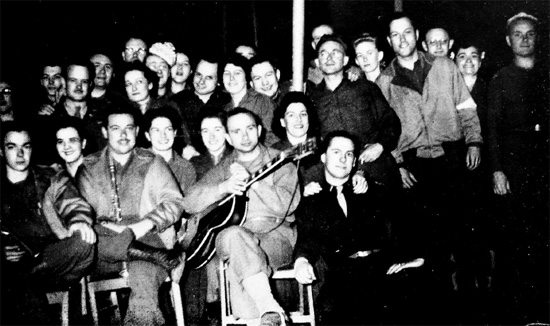
Photograph taken at the Officers’ and Nurses’ VE Day celebration party.
| American Red Cross: | ||
| Blake, Willa | Sanborn, Kay | |
| Jones, Nancy | Stenvick, Ruth | |
| Enlisted Men: | ||
| Adams, Elmer E., MD, Private First Class | Hallquist, William G., MD, Technician 4th Grade | Pickett, Patrick A., MD, Private First Class |
| Ahearn, Vincent J., MD, Private First Class | Hampton, Edwin L., MD, Technician 5th Grade | Pien, Melvin H., MD, Private First Class |
| Allen, LeRoy J., MD, Private First Class | Harris, Robert J., MD, Technician 4th Grade | Pierce, George F., MD, Private First Class |
| Allen, Marion K., MD, Staff Sergeant | Haskell, Herbert M., MD, Sergeant | Pierson, Chester M., MD, Private First Class |
| Andreasson, Herman R., MD, Technician 5th Grade | Head, Ivan E., MD, Technician 5th Grade | Pizzutti, James J., MD, Private First Class |
| Arry, MD, Private | Hemond, Julien M., MD, Private First Class | Podolak, Charles (NMI), MD, Staff Sergeant |
| Ash, Robert C., MD, Technician 4th Grade | Henderson, Joseph P., MD, Private First Class | Polodichuk, Emil T., MD, Technician 5th Grade |
| Asp, Harold S., MD, Private First Class | Hernandez, Juan A., MD, Private First Class | Popp, Walter R., MD, Technician 5th Grade |
| Augustus, Percy H., MD, Private First Class | Hernandez, Barthol, MD, Private First Class | Powers, Wesley K., MD, Technician 4th Grade |
| Auldin, Frank J. G., MD | Hess, Willard F., MD, Technician 4th Grade | Quinn, Robert W., MD, Private First Class |
| Badboy, Mike, MD, Private First Class | Hill, John M., MD, Private First Class | Rabine, John L., MD, Technician 5th Grade |
| Ball, MD, Private | Hill, Winford, MD, Private | Ranta, Arthur, MD, Private |
| Banks, John R., MD | Hirtz, Edward H., MD | Rathbone, Wayne W., MD, Private First Class |
| Baker, Harley R., MD, Private First Class | Hjelter, Quentin R., MD, Technician 5th Grade | Reibeling, George E., MD, Private |
| Barkman, Samuel J., MD, Technician 4th Grade | Hochheim, Alfred T., MD, Technician 5th Grade | Riley, John H., MD, Technician 4th Grade |
| Bass, Wilbur, MD, Private First Class | Hofer, Joe P., MD, Private First Class | Riley, Lawrence V., MD, Private First Class |
| Bassett, Charles D., MD, Private First Class | Hogan, Arnold, MD, Private First Class | Ridley, Robert F., MD, Technician 5th Grade |
| Bennington, Russell D., MD, Private | Hose, William W., MD, Technician 3d Grade | Rogers, Wardell A., MD, Staff Sergeant |
| Berry, Merle E., MD, Technician 3d Grade | Howard, Willard H., MD, Private | Rongitsch, Frank J., MD, Technician 4th Grade |
| Bertalan, Joseph, Jr., MD, Technician 4th Grade | lannaccone, Anthony, Jr., MD, Private First Class | Rosenhaft, Samuel, MD, Private |
| Bertsch, Matthew, MD, Corporal | Ingvalson, Gilman A., MD, Corporal | Rosenkjar, Lowell W., MD, Technician 5th Grade |
| Bielenin, Edward L., MD, Staff Sergeant | Jacob, Meier, MD, Staff Sergeant | Roux, Willard D., MD, First Sergeant |
| Bixler George W., Jr., MD, Technician 4th Grade | James, Arthur W., MD, Staff Sergeant | Ruck, Francis H., MD, Technician 4th Grade |

Three unidentified Enlisted personnel of the 41st prepare to cross the Channel in 1945.
| Block, Alfred A., MD, Private First Class | James, David L., MD, Private | Ruffcorn, Lewis F., MD, Corporal (+ 30 Dec 44) |
| Bolanowski, James E., MD, First Lieutenant | Jamsa, George J., MD, Technician 5th Grade | Sampson, Russel R., MD, Private First Class |
| Borg, Victor L., MD, Private First Class | Jeeney, Louis, MD, Technician 5th Grade | Sapp, John R., MD, Private First Class |
| Braendle, Clinton A., MD, Private | Jeli, William, MD, Private | Scattie, MD |
| Bray, William R., MD, Sergeant | Jesser, Norman, MD, Private | Schmidt, Melvin J., MD, Private First Class |
| Brodt, Theodore R., MD, Technician 5th Grade | Jeson, Richard, MD, Staff Sergeant | Schneider, Emil, MD, Private First Class |
| Brooks, Albert J., MD | Johnson, Edon M., MD | Schultz, Otto C., MD, Technician 5th Grade |
| Buckley, Ralph M., MD, Private | Johnson, James H., MD, Private First Class | Schurr, Harry A., MD, Staff Sergeant |
| Burr, William J., MD, Private First Class | Johnson, Lloyd G., MD, Technician 5th Grade | Schwartz, Jay B., MD, Staff Sergeant |
| Burrell, John, W., MD, Technical Sergeant | Johnson, Russell H., MD, Technician 4th Grade | Scott, Fred P., MD, Private |
| Cameron, George D., MD, Technician 4th Grade | Jones, Leslie L., MD, Private First Class | Scott, George W., MD, Corporal |
| Campanaro, George, MD, Private First Class | Jorgenson, Norman R., MD, Private First Class | Scott, Harold J., MD, Private First Class |
| Cancer, MD, Private | Jortel, MD, Private First Class | Seff, Frank, MD, Private |
| Capute, John A., MD, Staff Sergeant | Jotin, James, W., MD, Master Sergeant | Shapiro, Rubin, MD, Corporal |
| Chancey, Martin, MD, Private | Karkut, Edward J., MD, Technician 5th Grade | Sheehy, Maurice S., MD, Sergeant |
| Chiswell, Alfred G., MD | Kavanagh, George A., MD, Technician 4th Grade | Short, Robert W., MD, Private First Class |
| Christensen, Clifford G., MD, Private First Class | Kerley, James S., MD, Technician 4th Grade | Shurston, MD, Private |
| Christenson, Harold S., MD, Technician 5th Grade | Kesselman, Stanley, MD, Private First Class | Siebell, Arnold A., MD, Technician 5th Grade |
| Cobb, Harold L., MD, Private First Class | Kirkegaard, Lester A., MD, Technician 5th Grade | Sittig, Frederick E., MD, Private |
| Cohen, Paul, MD, Private | Kish, John J., MD, Staff Sergeant | Smith, Lawrence A., MD, Technician 5th Grade |
| Cook, Ralph E., MD, Technician 4th Grade | Kleven, Douglas W., MD, Technician 5th Grade | Smith, Oscar, MD |
| Costa, Manuel R., MD, Sergeant | Knight, Glen N., MD, Technician 5th Grade | Smith, Robert E., MD, Private First Class |
| Cotter, Wilfrid M., MD, Private | Knittel, Harry H., MD, Corporal | Snow, Charles R., MD, Technician 4th Grade |
| Covey, Russel E., MD, Private First Class | Koch, Walter E., MD, Technician 4th Grade | Solberg, Edward N., MD, Private First Class |
| Cuccinello, Salvatore, MD, Technician 5th Grade | Koons, Wilbur R., MD, Staff Sergeant | Solem, William, MD, Sergeant |
| Culton, Hugh R., MD, Private First Class | Krzemianowski, Edward A., MD, Technician 4th Grade | Soltis, Mike A., MD, Technician 4th Grade |
| Curtis, Wallace R., MD, Private | Kurowski, Donald J., MD, Technician 4th Grade | Sortor, Willard P., MD, Private First Class |
| Danich, Michael, MD, Private First Class | Kutcher, Delbert E., MD, Technician 5th Grade | Stamer, Howard W., MD, Technician 4th Grade |
| Davis, J., Leroy, MD, Private First Class | Lambert, Bernard E., MD, Technician 3d Grade | Stanek, Lawrence T., MD, Technical Sergeant |
| Delich, Michael, MD | Landers, William F., MD, Technician 4th Grade | Stephens, Kenneth L., MD, Technician 4th Grade |
| Der, George L., MD, Technician 4th Grade | Lankford, Kenneth D., MD, Technician 4th Grade | Strey, Harold K., MD, Technician 5th Grade |
| DeSantis, Albert A., MD, Technician 4th Grade | LeBlanc, Valmor H., MD, Private First Class | Striegel, Marvin H., MD |
| DiNapoli, Joseph, MD, Technician 4th Grade | Leff, Frank J., MD, Corporal | Stromberg, Raymond G., MD, Corporal |
| Dinon, Patrick N., MD, Technician 5th Grade | Lenstra, Orville P., MD, Private First Class | Sumstadt, MD, Private |
| Dionne, Francis X., MD, Technician 3d Grade | Lentz, Eugene W., MD, Private First Class | Svenson, Arnold S., MD, Technician 4th Grade |
| Dobas, Clarence A., MD | Liebler, Allan T., MD, Private First Class | Tast, Harold C., MD, Private First Class |
| Donick, MD, Private | Lindquist, Howard W., MD, Technician 4th Grade | Telehany, Michael P., MD, First Sergeant |
| Dower, Earl N., MD | Lines, Galen J., MD, Technician 5th Grade | Temple, Lewis A., MD, Private First Class |
| Duncan, Vern C., MD, Private First Class | Logel, LeRoy H., MD, Private First Class | Teson, Richard A., MD, Staff Sergeant |
| Eaton, Homer L., MD, Technician 5th Grade | Lysinger, John F., MD, Technician 5th Grade | Tesser, Norman, MD, Sergeant |
| Edwards, Oscar N., MD, Technician 5th Grade | Mackewicz, Walter W., MD, Technician 5th Grade | Thompson, Eugene S., MD, Private |
| Ellefson, Harvey L., MD, Private First Class | Mairose, Jerome F., MD, Private | Tobin, James W., MD, Master Sergeant |
| Ernster, Verus A., MD, Corporal | Martarano, Louis J., MD, Private First Class | Tracy, Dennis J., MD, Private First Class |
| Feeney, Louis R., MD, Staff Sergeant | Martin, Raymond M., MD, Technician 4th Grade | Tsakonas, Charles, MD, Technician 3d Grade |
| Felci, William, MD, Private First Class | Mattern, Harvey M., MD, Technician 4th Grade | Tuenge, Leonard A., MD, Private First Class |
| Fineday, James, MD, Private First Class | Mayer, Otto P., MD | Tufte, Orville, MD, Private First Class |
| Fisher, Darwin L., MD, Technician 4th Grade | Medrano, Frank H., MD, Private First Class | Van Bergen, Joseph R., MD, Technician 5th Grade |
| Flanagan, William M., MD, Corporal | Messner, William E., MD, Technical Sergeant | Van Sickel, Ellsworth A., MD, Corporal |
| Ford, John H., MD, Private | Miceli, Joseph, MD, Private | Wahweotten, Garnett W., MD, Private First Class |
| Fortel, Robert E., MD, Private First Class | MacLean, Donald F., MD, Corporal | Waldron, Edward J., MD, Private |
| Foust, Joseph S., MD, Sergeant | McDuff, William T., Jr., MD, Technician 3d Grade | Ward, Carroll H., MD, Corporal |
| Free, Tullis M., MD, Private First Class | McKenna, James F., MD, Technical Sergeant | Warrenchack, Metro F., MD, Technician 4th Grade |
| Friess, Paul M., MD, Private First Class | McManus, MD, Sergeant | White, Paul G., MD, Technical Sergeant |
| Gabrielson, Edwin L., MD, Technician 5th Grade | Morehead, Wilbert J., MD, Technician 5th Grade | White, Robert A., MD, Technician 4th Grade |
| Gall, Howard T., MD, Private First Class | Mote, William N., MD, Private First Class | Wilkins, Grady, MD, Private First Class |
| Garrett, Marvel L., MD, Private | Mueggenburg, Carl W., MD, Private First Class | Williams, Alfred P., Jr., MD, Private First Class |
| Gauldin, Frank J., MD, Technician 5th Grade | Mueller, William J., MD, Technician 5th Grade | Willsey, Donald F., MD, Technician 4th Grade |
| Gensler, Oliver (NMI), MD, Technician 4th Grade | Nelson, Carl W., MD, Private First Class | Winter, Richard W., MD, Private First Class |
| Gentile, Patrick, MD, Technical Sergeant | Nelson, Henry W., MD, Private First Class | Wolff, Gilbert L., MD, Private First Class |
| Gentry, Allan, MD, Private First Class | Neu, Ernest L., MD, Technician 4th Grade | Woocher, Louis, MD, Technician 4th Grade |
| Gibis, James J., MD, Technician 4th Grade | Norberg, Joel B., MD, Private First Class | Wright, Fred G., MD, Private First Class |
| Gibson, Curtis B., MD, Private First Class | Ock, Joe, MD, Private | Wroblinski, Michael L., MD, Private |
| Gielep, John H., MD, Private First Class | O’Connor, Patrick F., MD | Wyatt, Willard L., MD, Private First Class |
| Gondringer, Raymond J., MD, Private First Class | Oertel, Joseph G., MD, Technician 4th Grade | Yanicak, Andrew G., MD, Corporal |
| Good, James V., MD, Technician 5th Grade | Ossola, Marshall, MD, Technician 5th Grade | York, Gerald P., MD, Private |
| Grauel, George J., MD, Technician 4th Grade | Ostrom, William G., MD, Private First Class | Zahner, Emanuel A., MD, Staff Sergeant |
| Grazioli, Anthony C., MD, Private First Class | Pannell, Charles H., Jr., MD, Technician 5th Grade | Zigala, Tony S., MD, Staff Sergeant |
| Guest, Walter B., MD, Technician 5th Grade | Paoletti, Frank A., MD, Private | Zmijewski, Edward W., MD, Technician 5th Grade |
| Haapoja, George, MD | Paynter, Lorne H., MD, Technician 5th Grade | Zubiena, Frank J., MD, Private First Class |
| Hahne, Bernard J., MD, Technician 5th Grade | Pelerin, Joseph, MD, Private First Class | Zuletis, Frank A., MD |
| Haines, Elwin L., MD, Private First Class | Peluso, George J., MD, Private First Class | |
| Haldeman, Robert L., MD, Technician 3d Grade | Pereira, José M., MD, Private First Class |
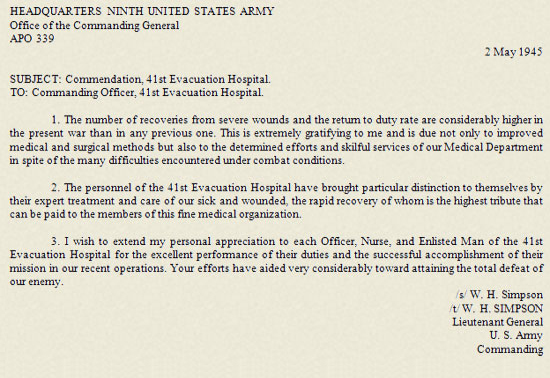
Letter dated 2 May 1945 commending the staff of the 41st Evacuation Hospital for the high rate of patients returned to duty.
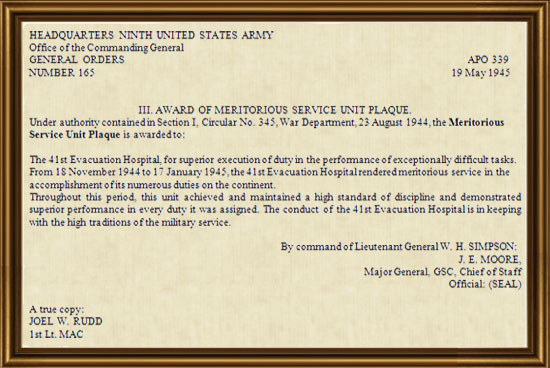
Copy of the Meritorious Service Unit Plaque, awarded to the 41st Evacuation Hospital on 19 May 1945.
We are once more truly indebted to Lynn McNulty, son of Captain Frederick J. McNulty (ASN:O-526873) for providing us with a precious copy of “The narrative-style Report of the Activities of the 41st Evacuation Hospital (SM)” which helped the MRC Staff edit a Unit History of subject Hospital. The original “story’ was written by Warrant Officer Junior Grade Albert W. Kuhlman; ANC First Lieutenant Elizabeth C. Hogan; and Technician 5th Grade J. Leroy Davis, all members of the 41st Evacuation Hospital.
